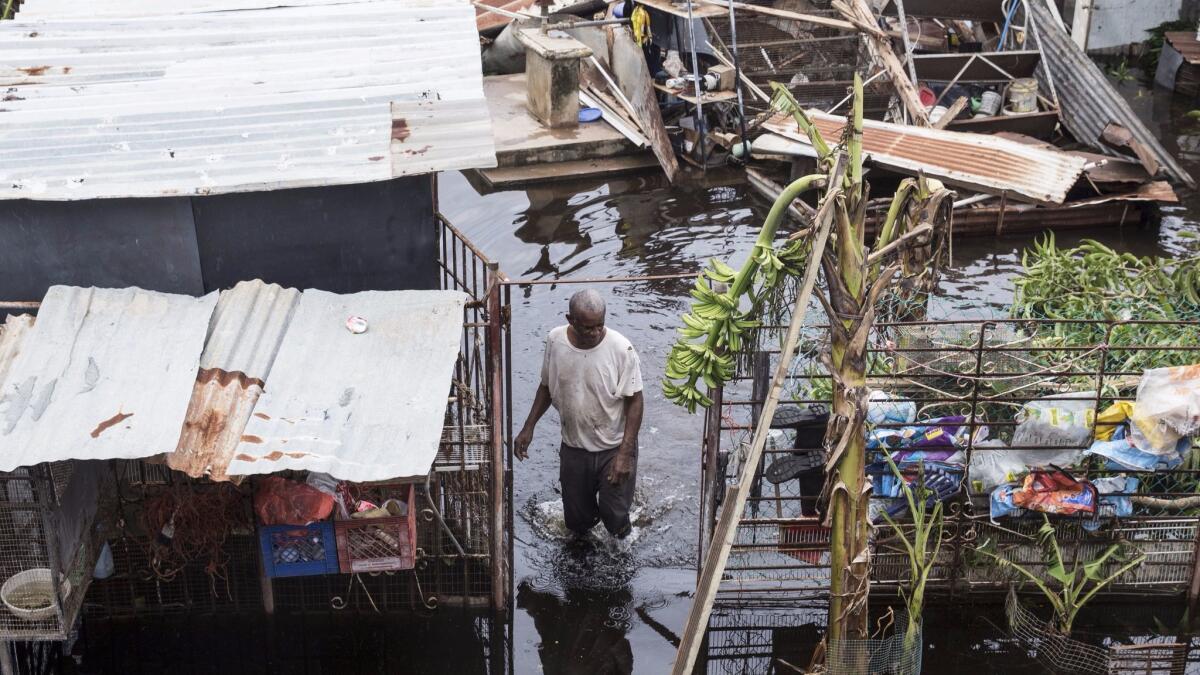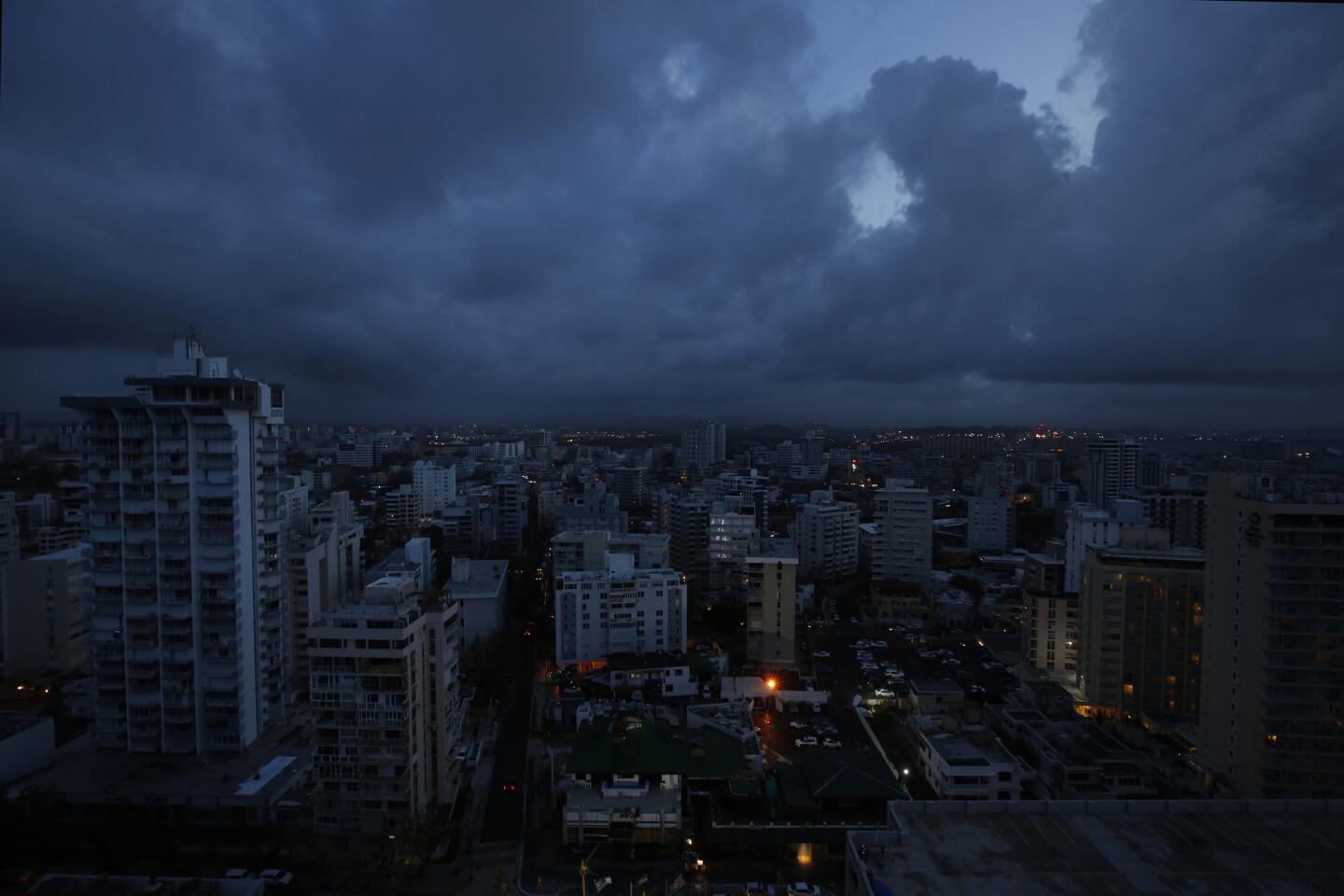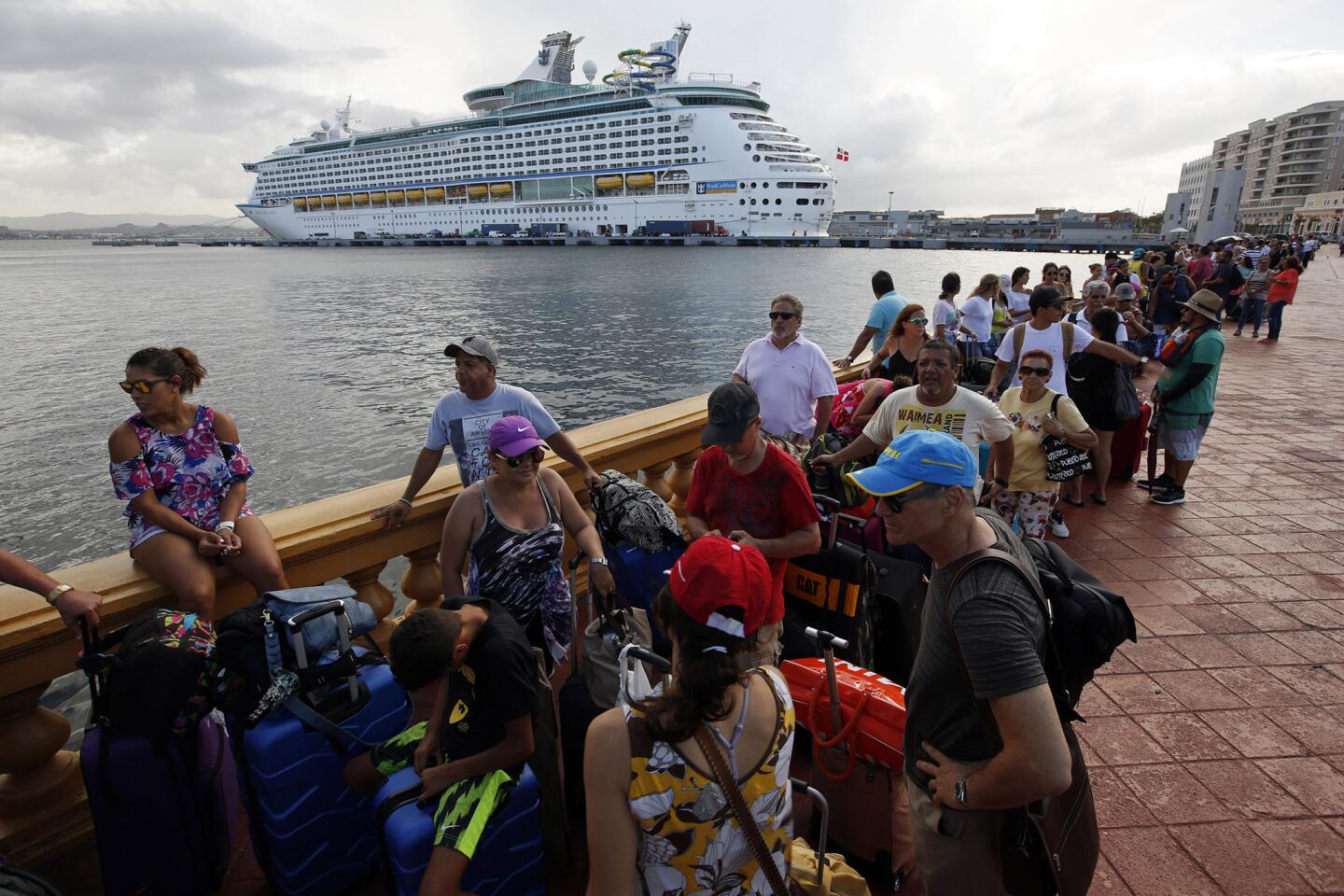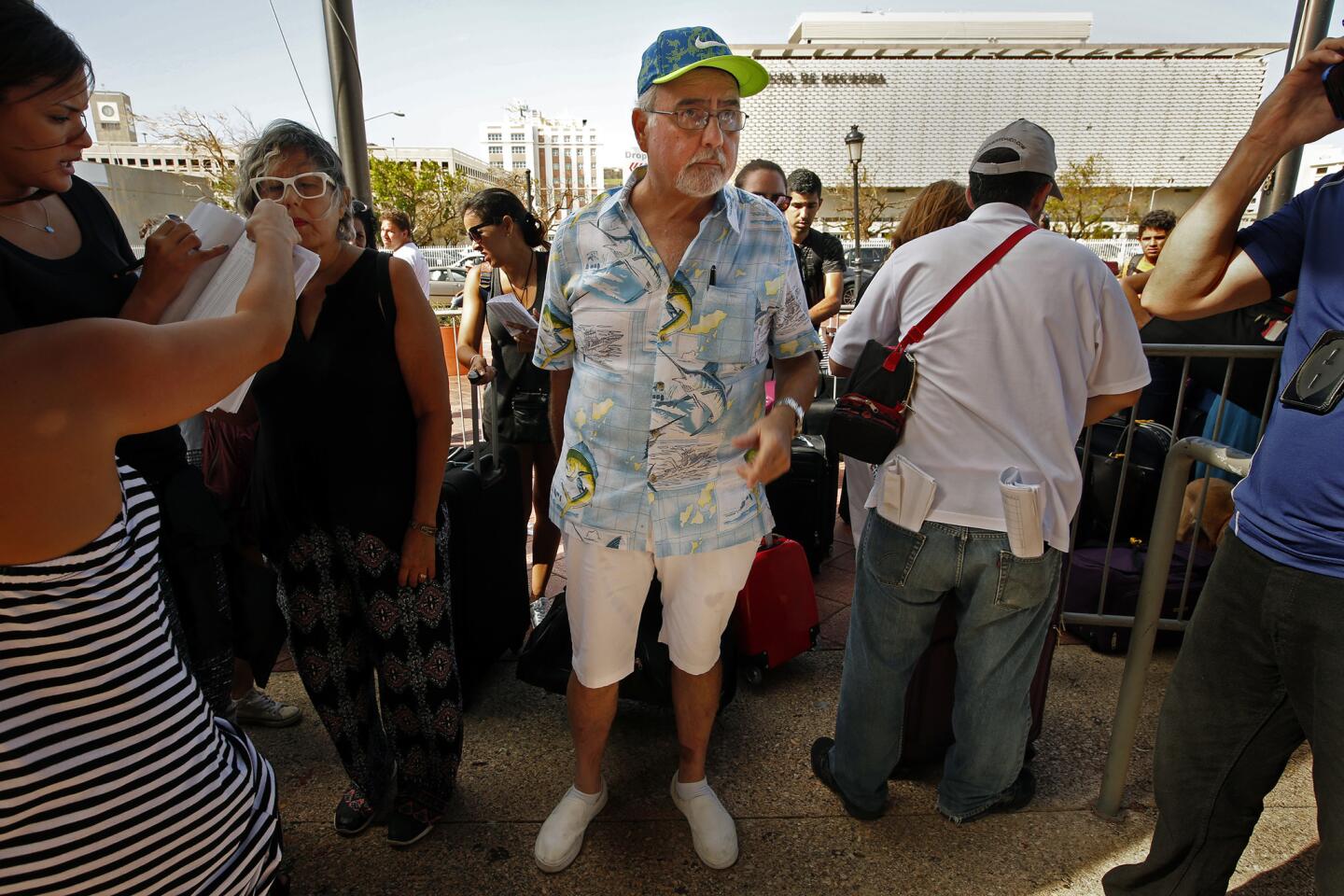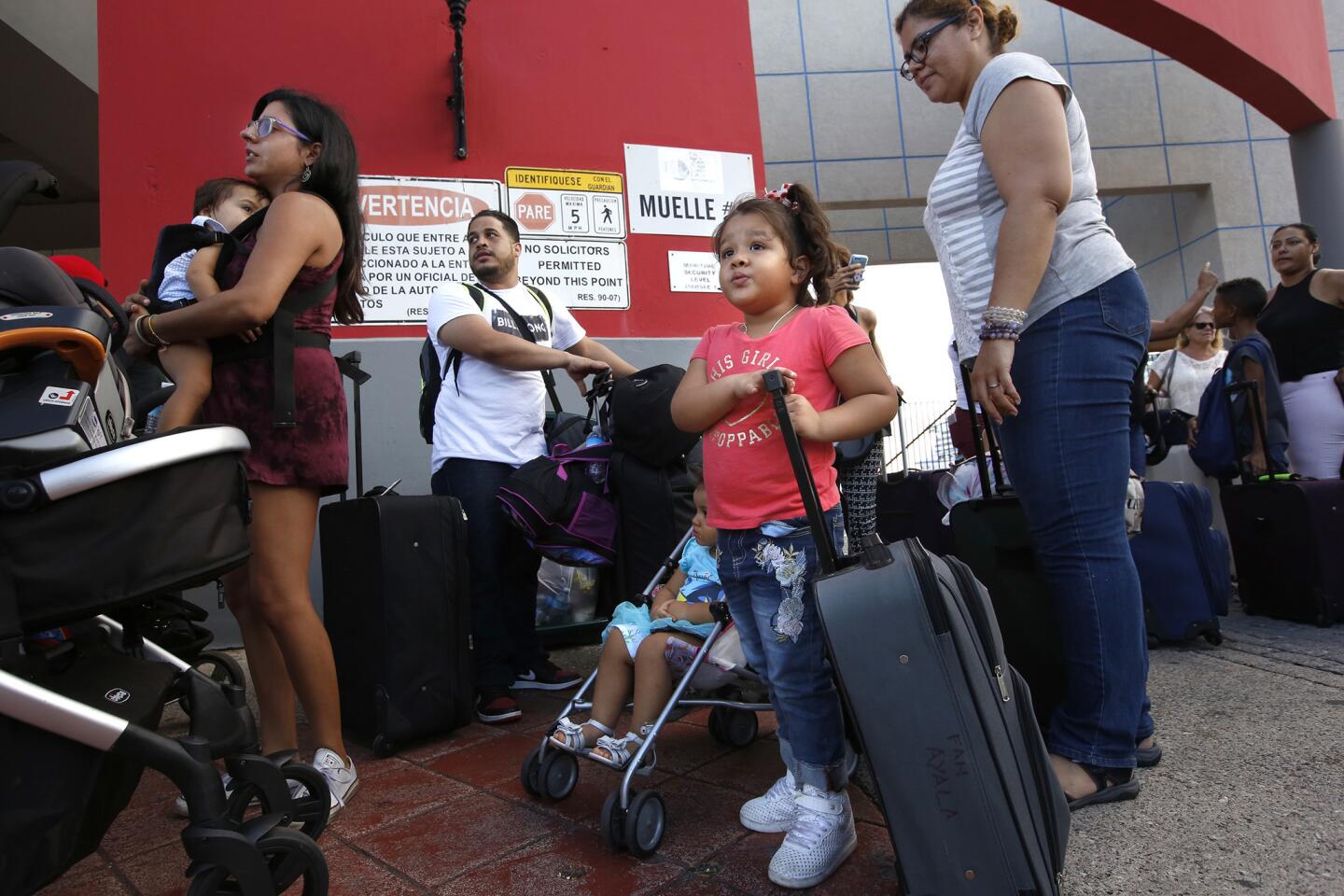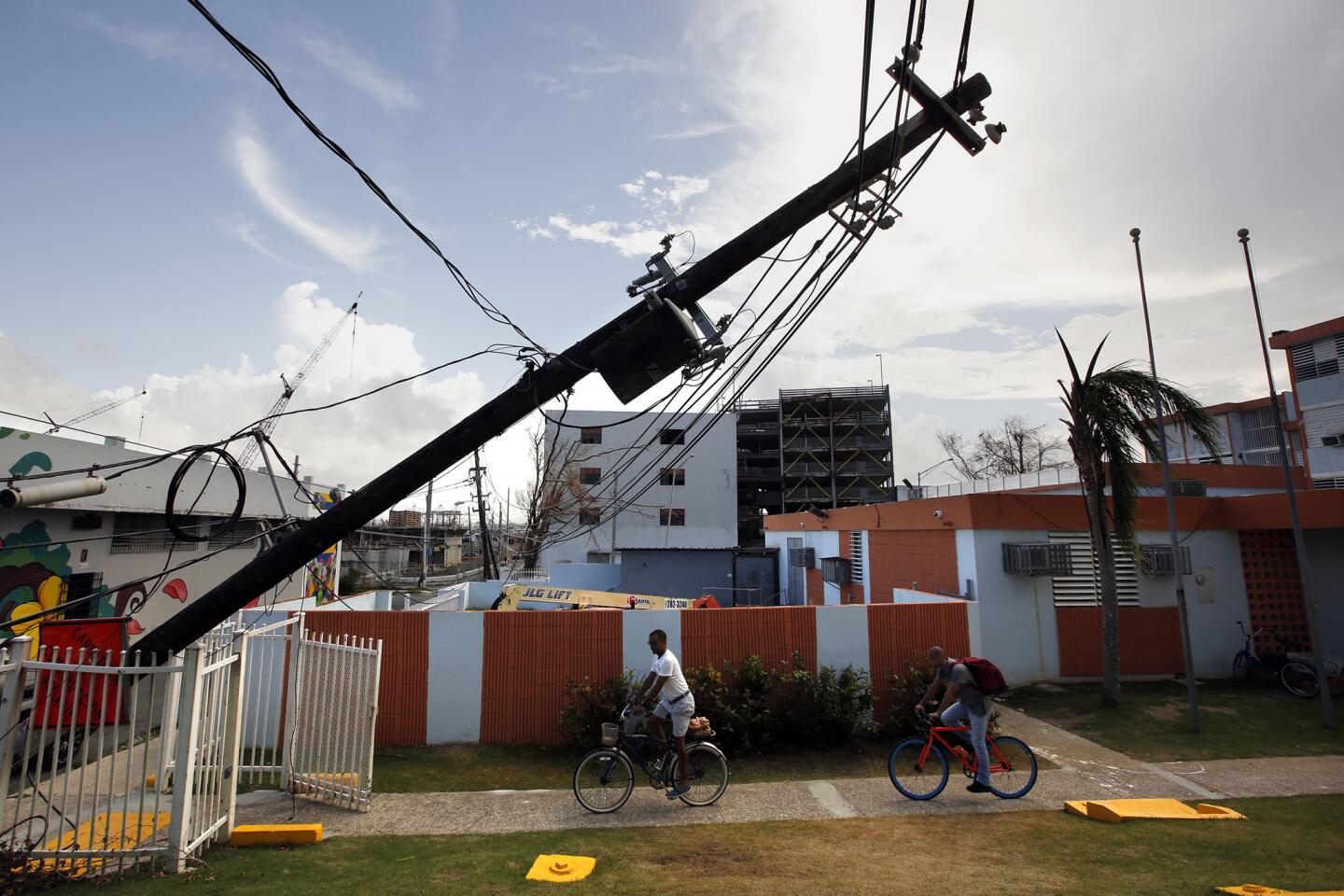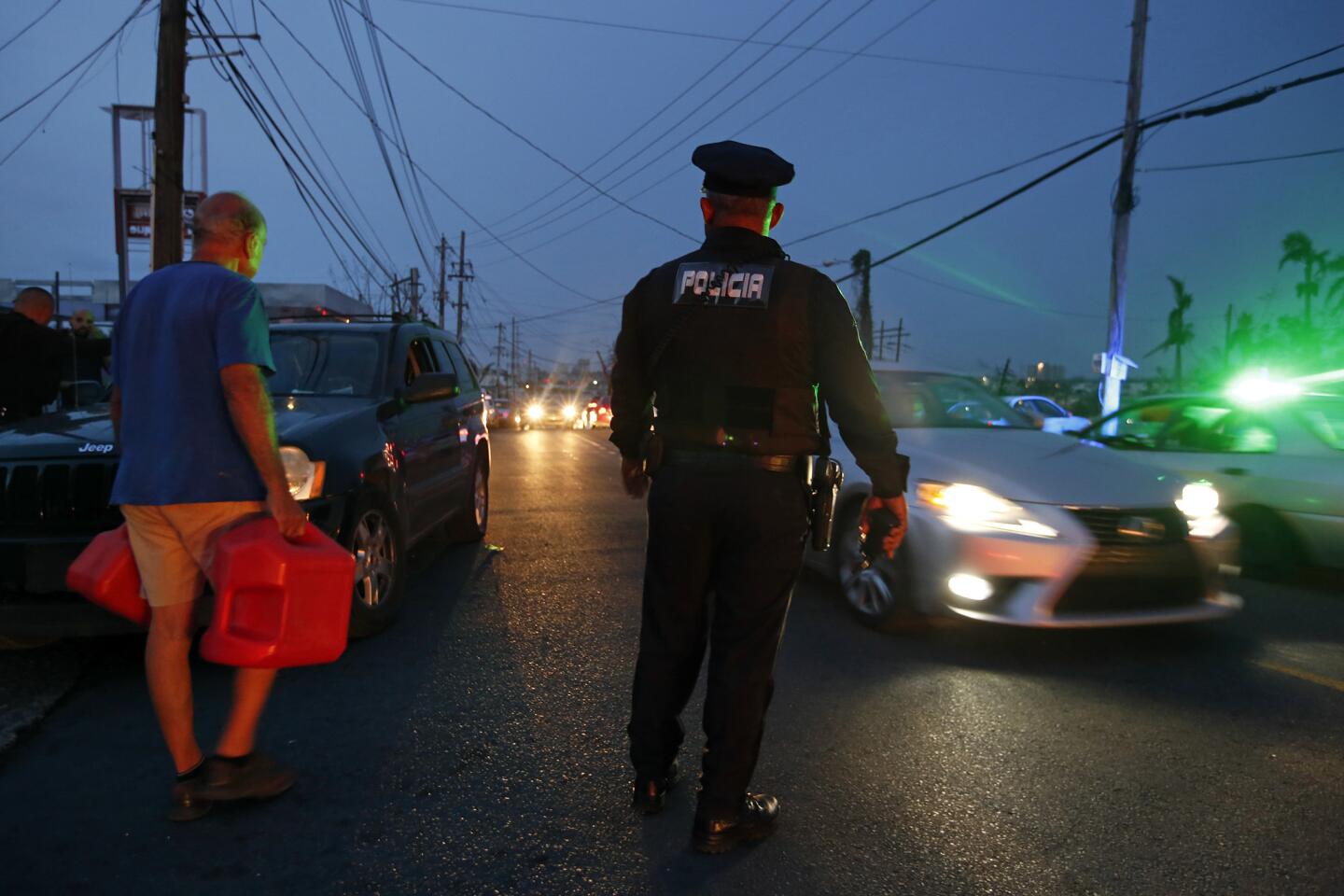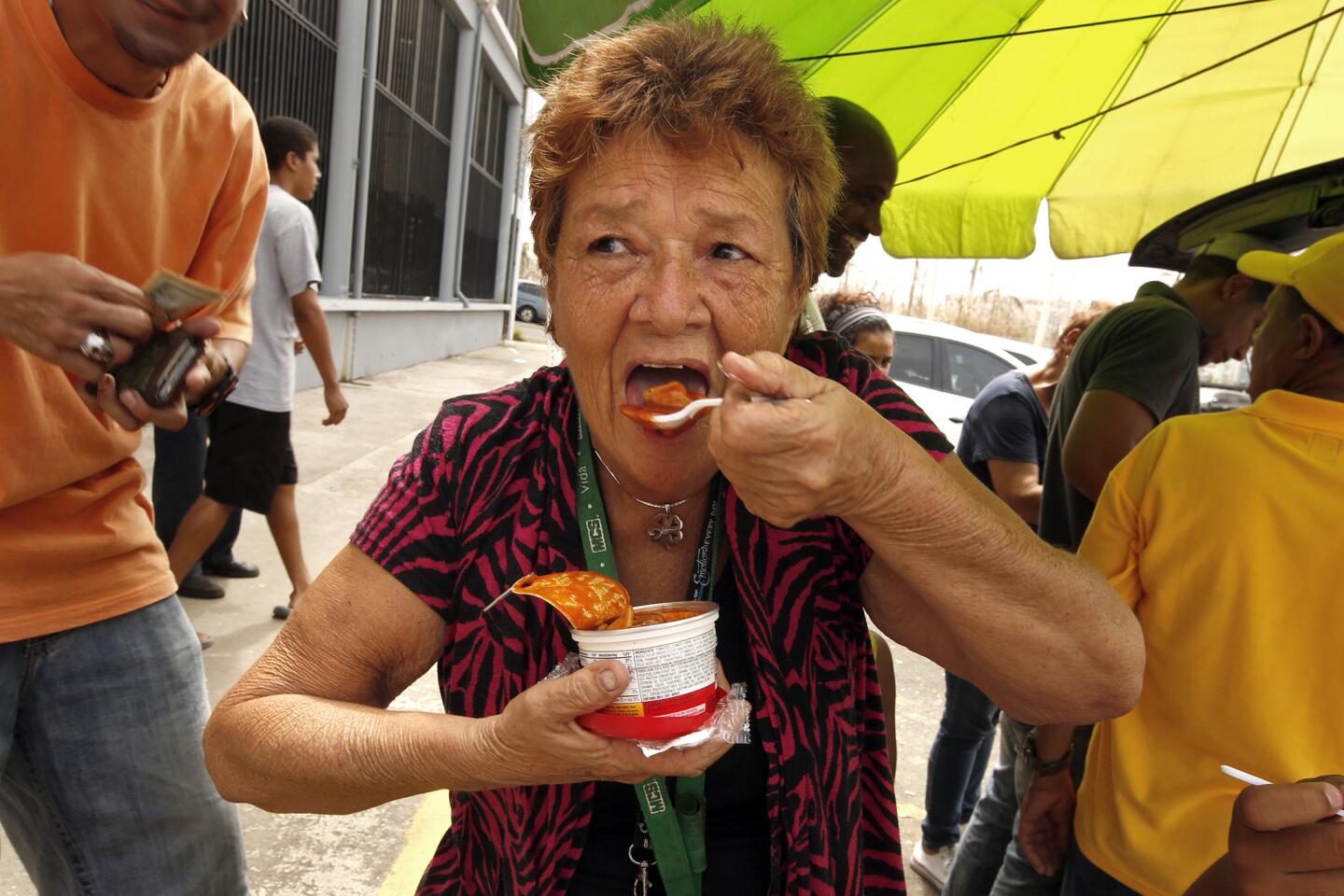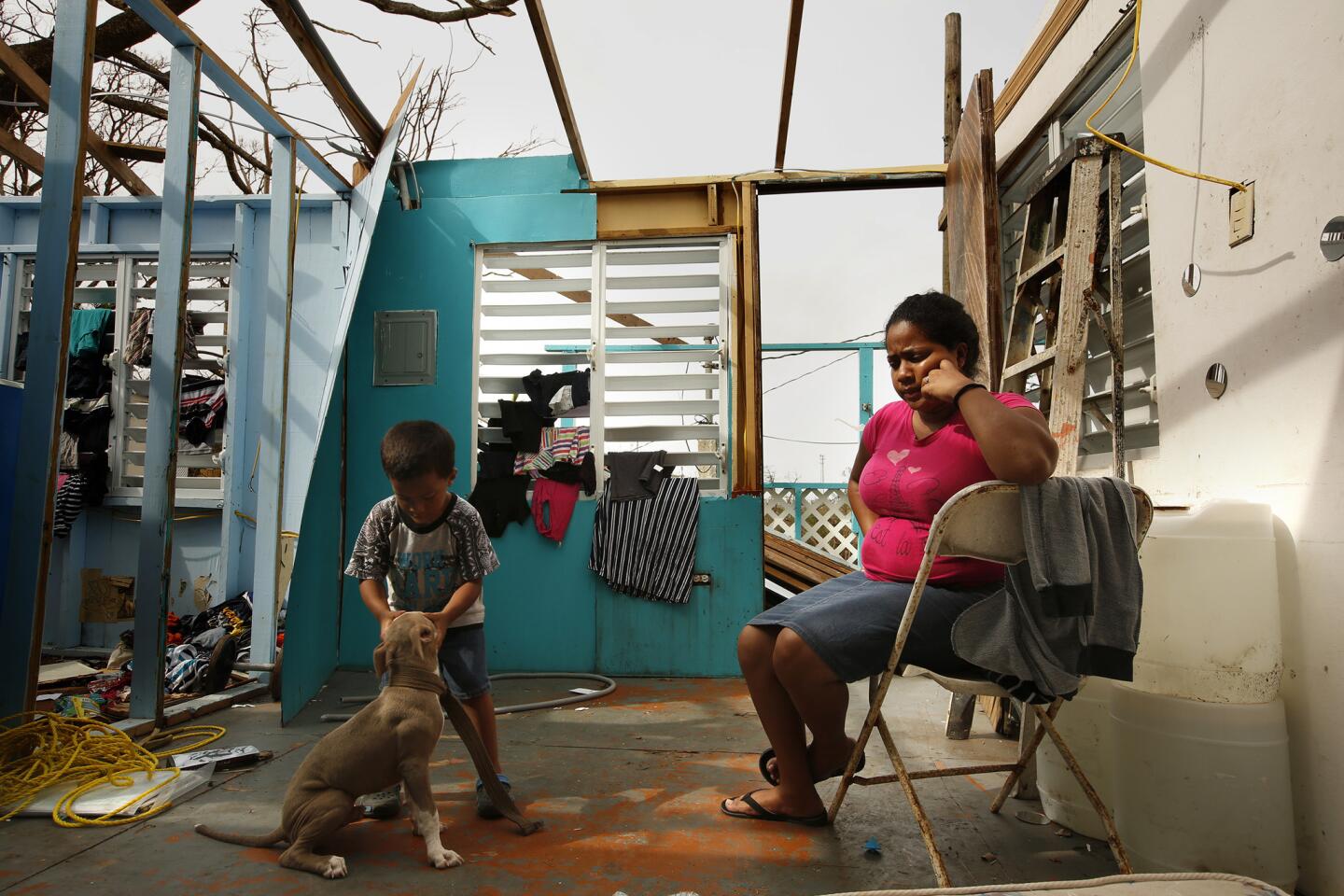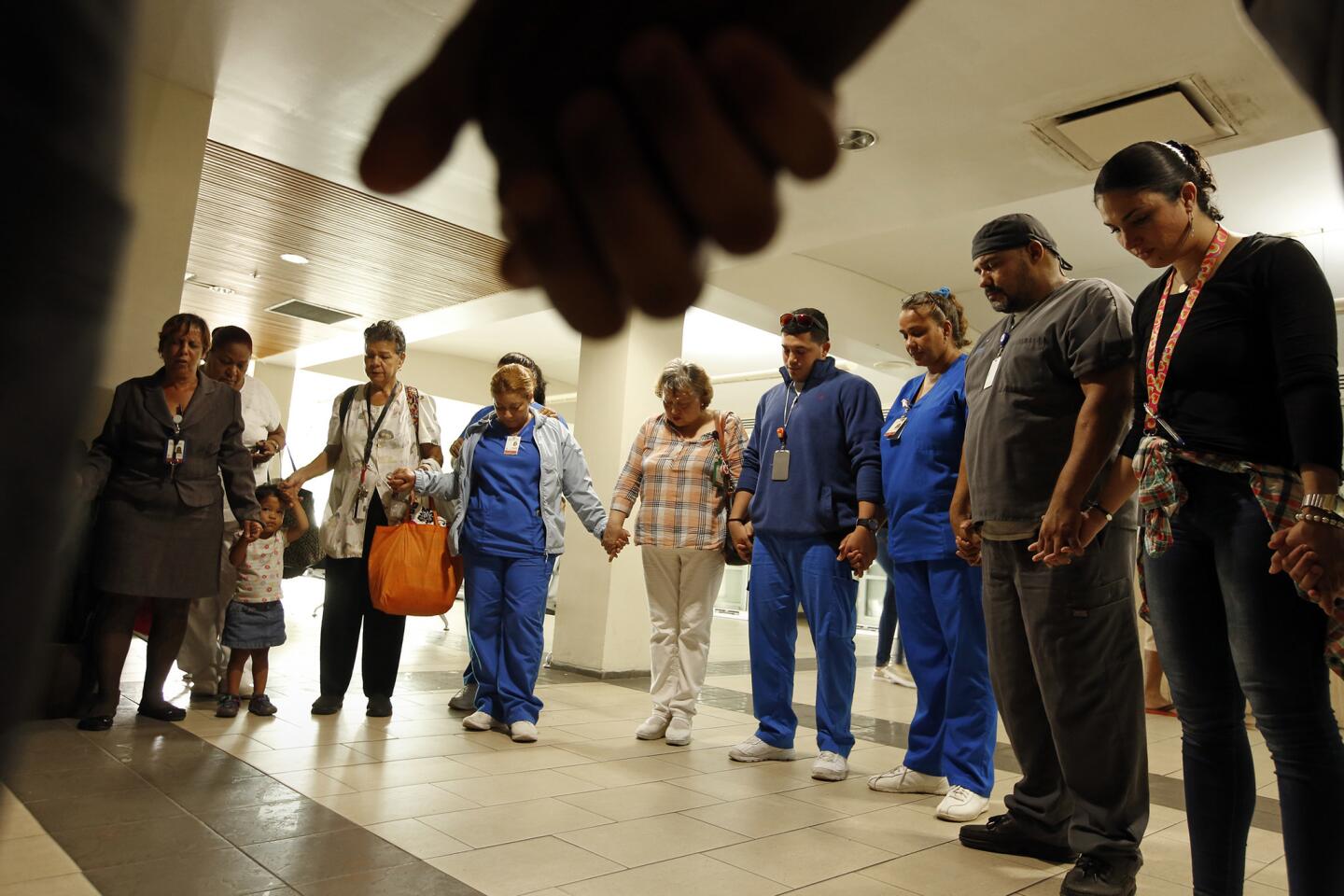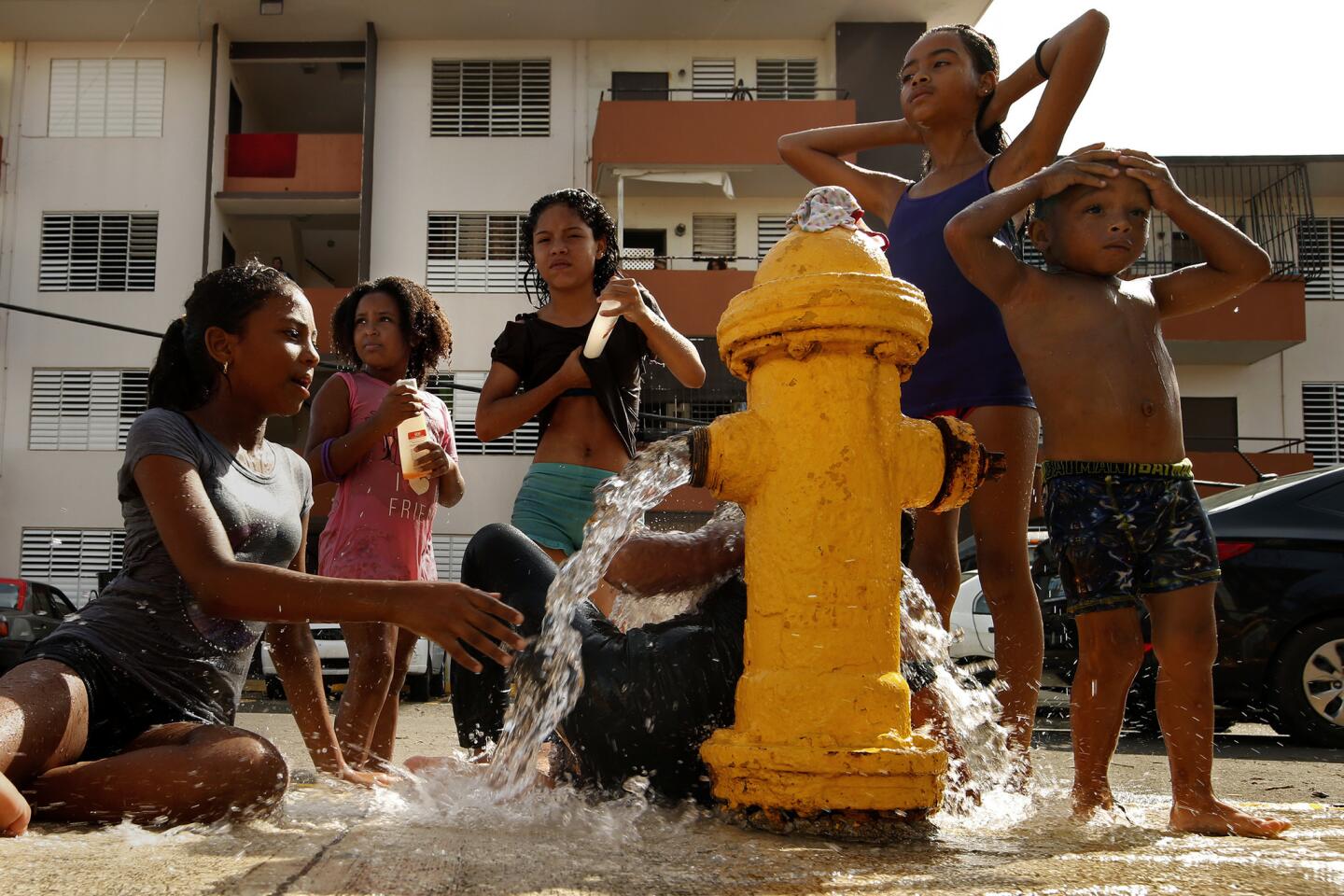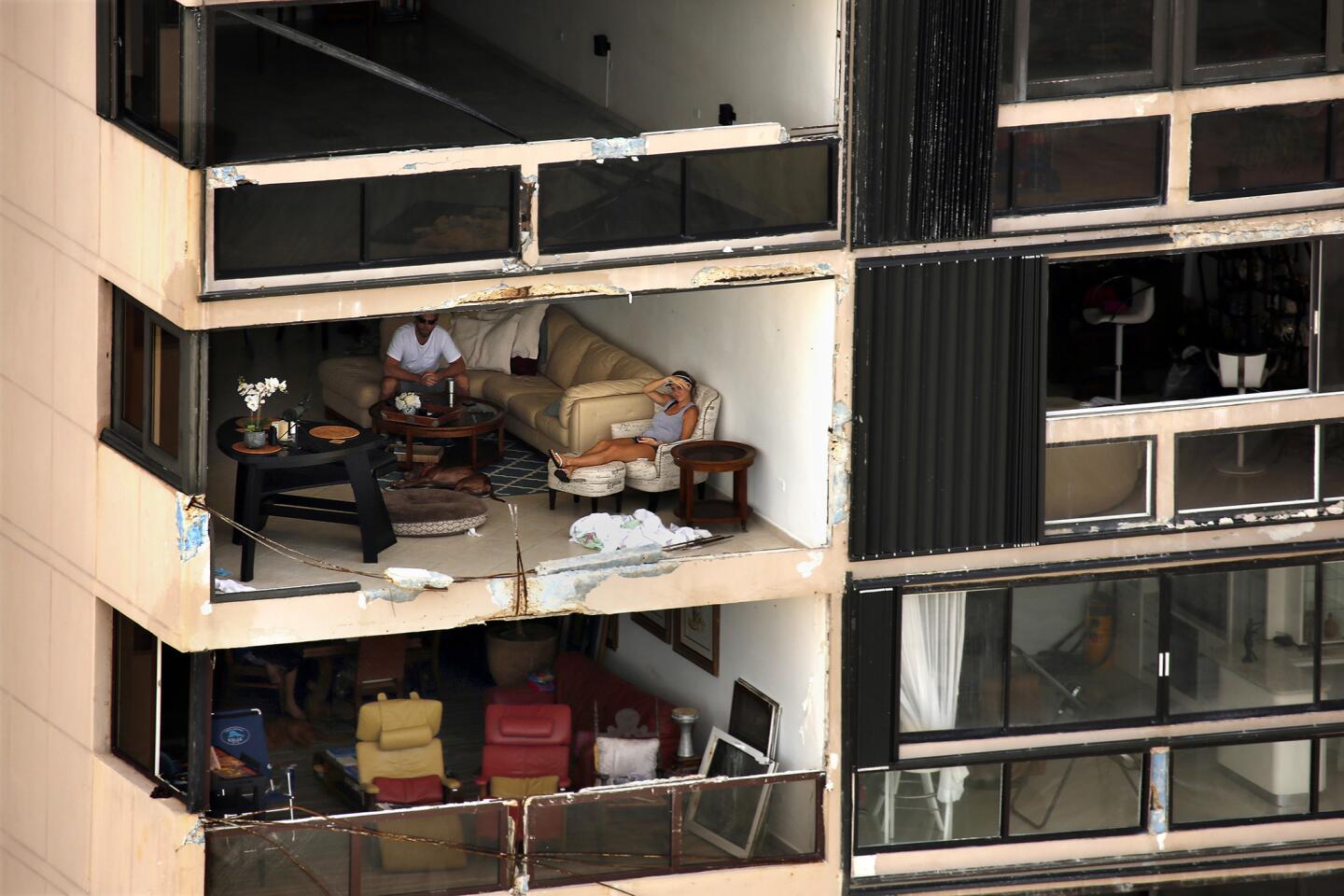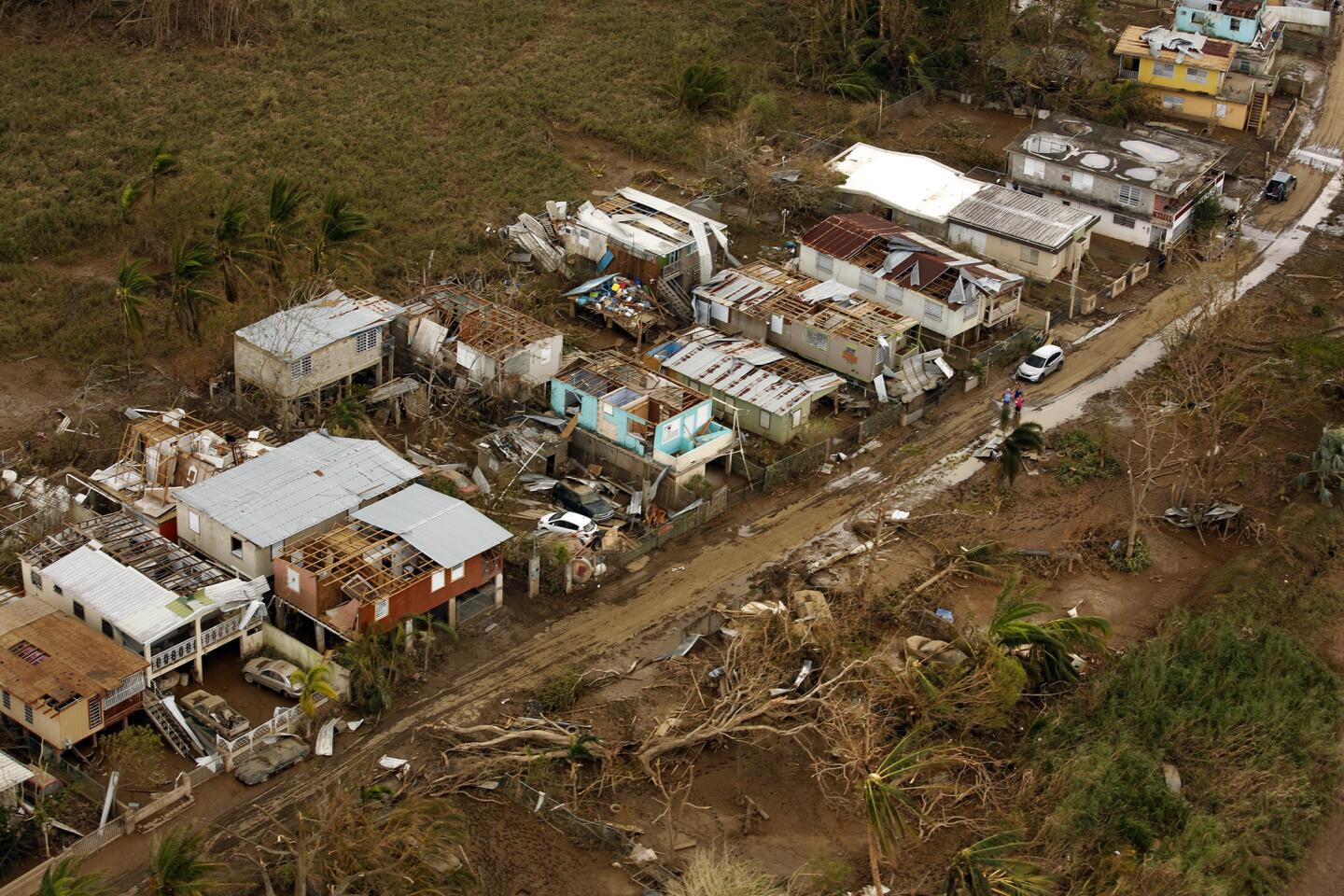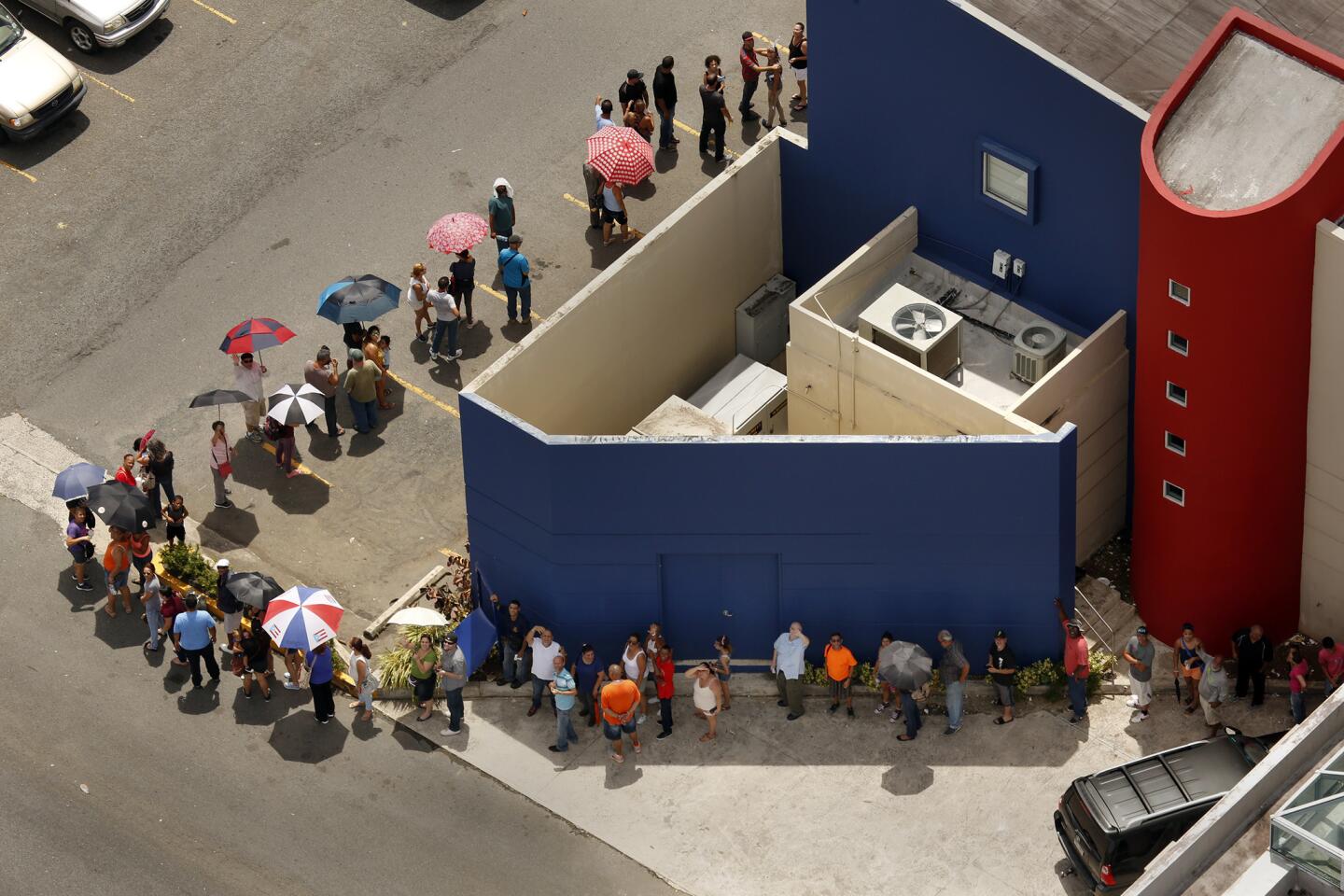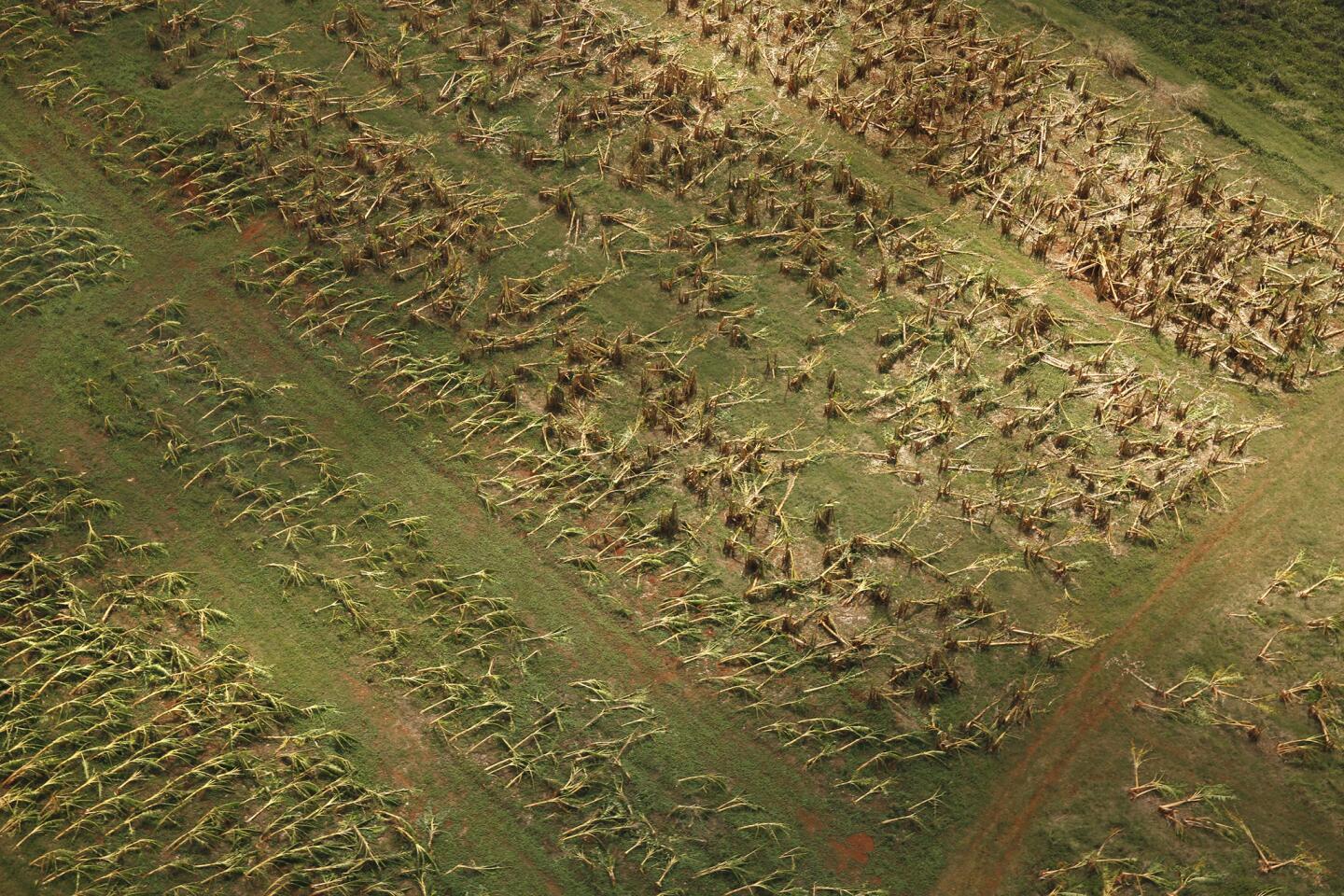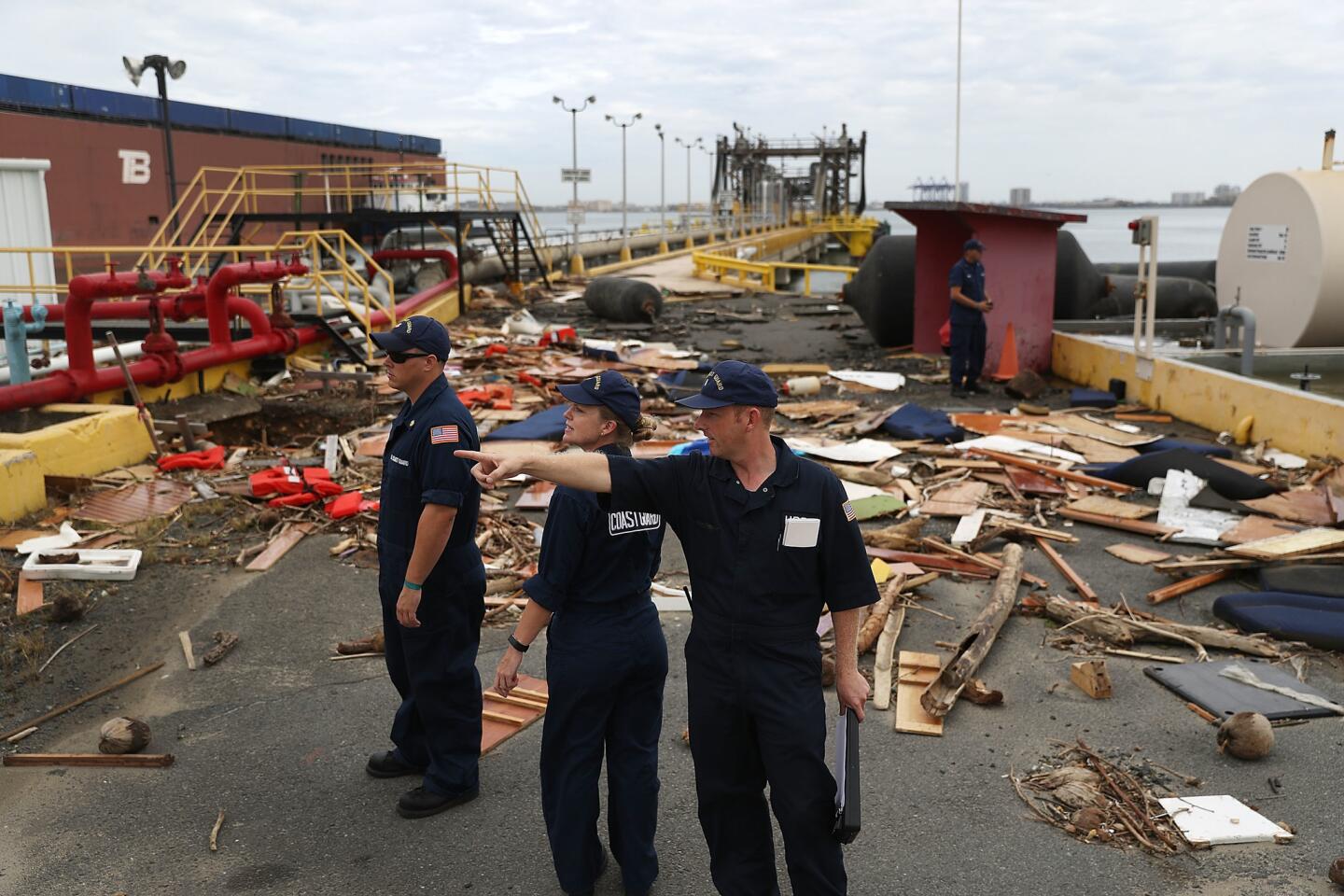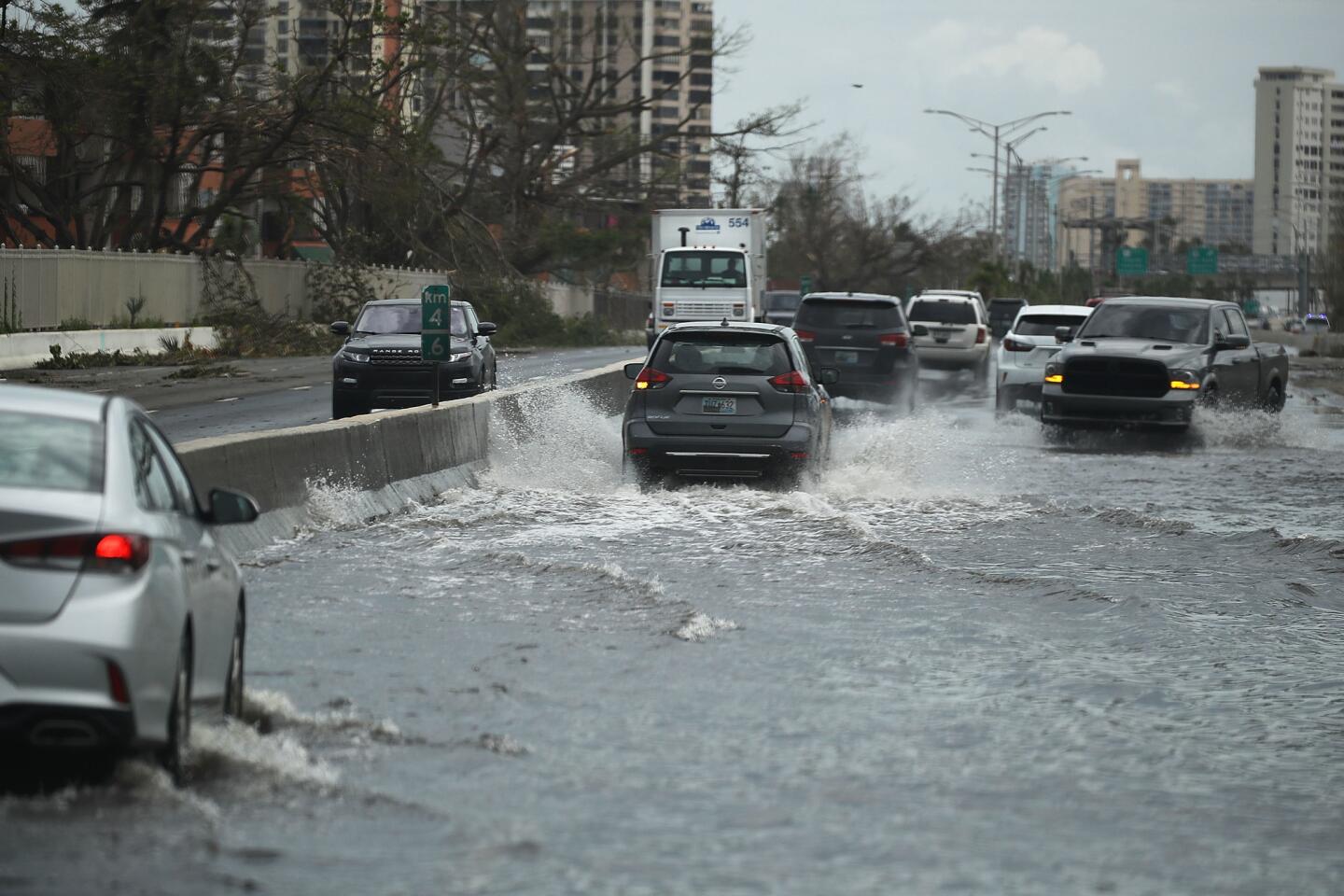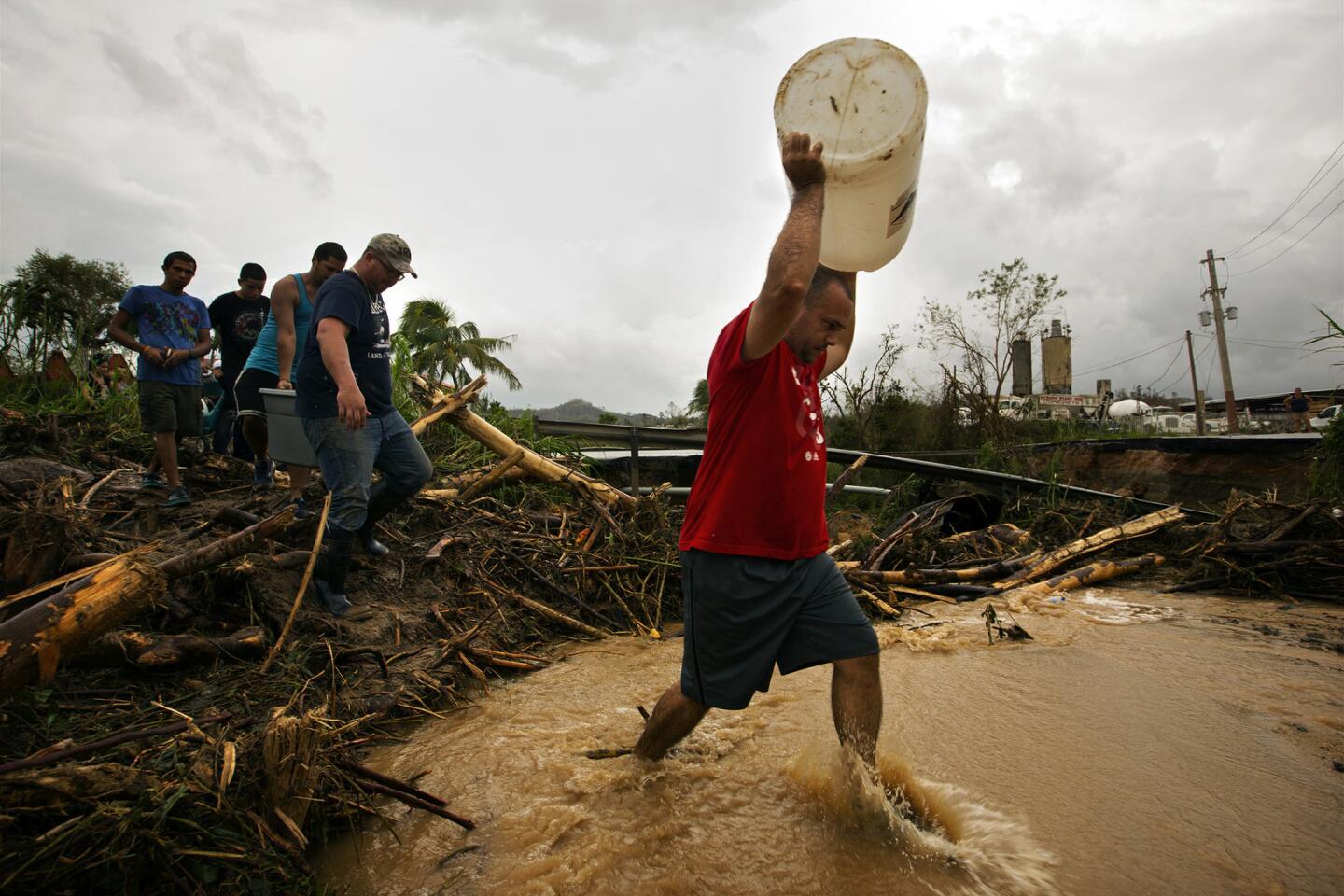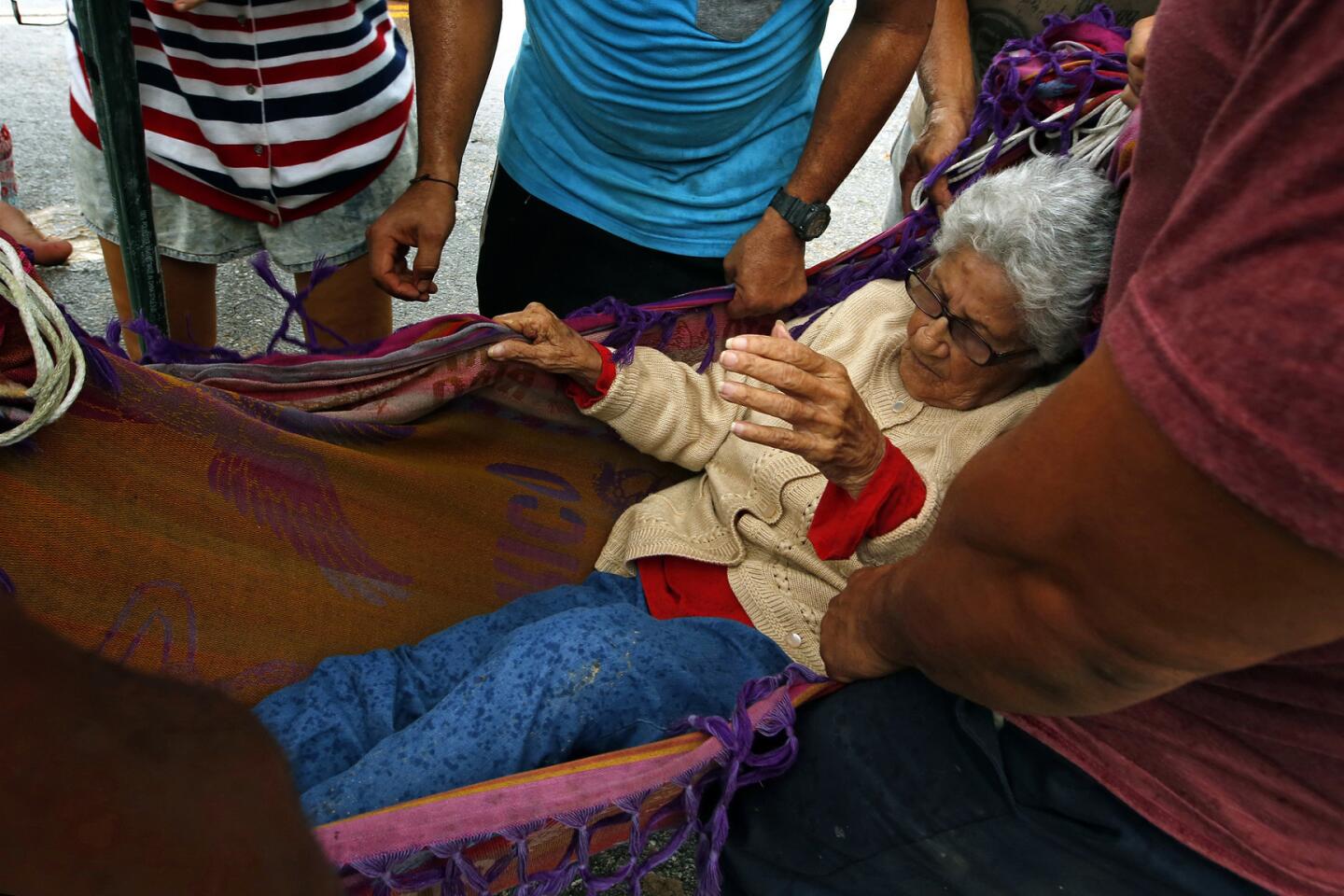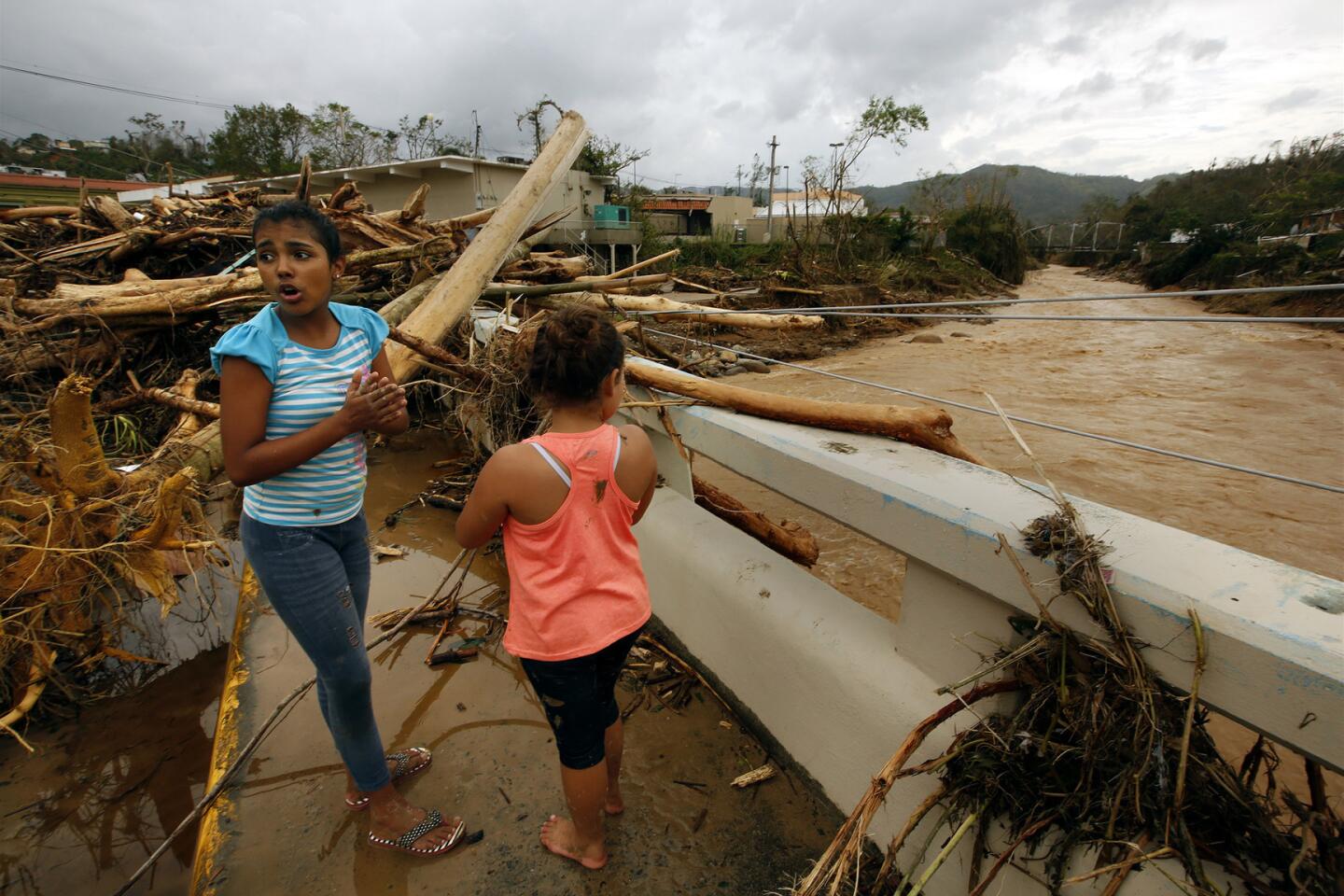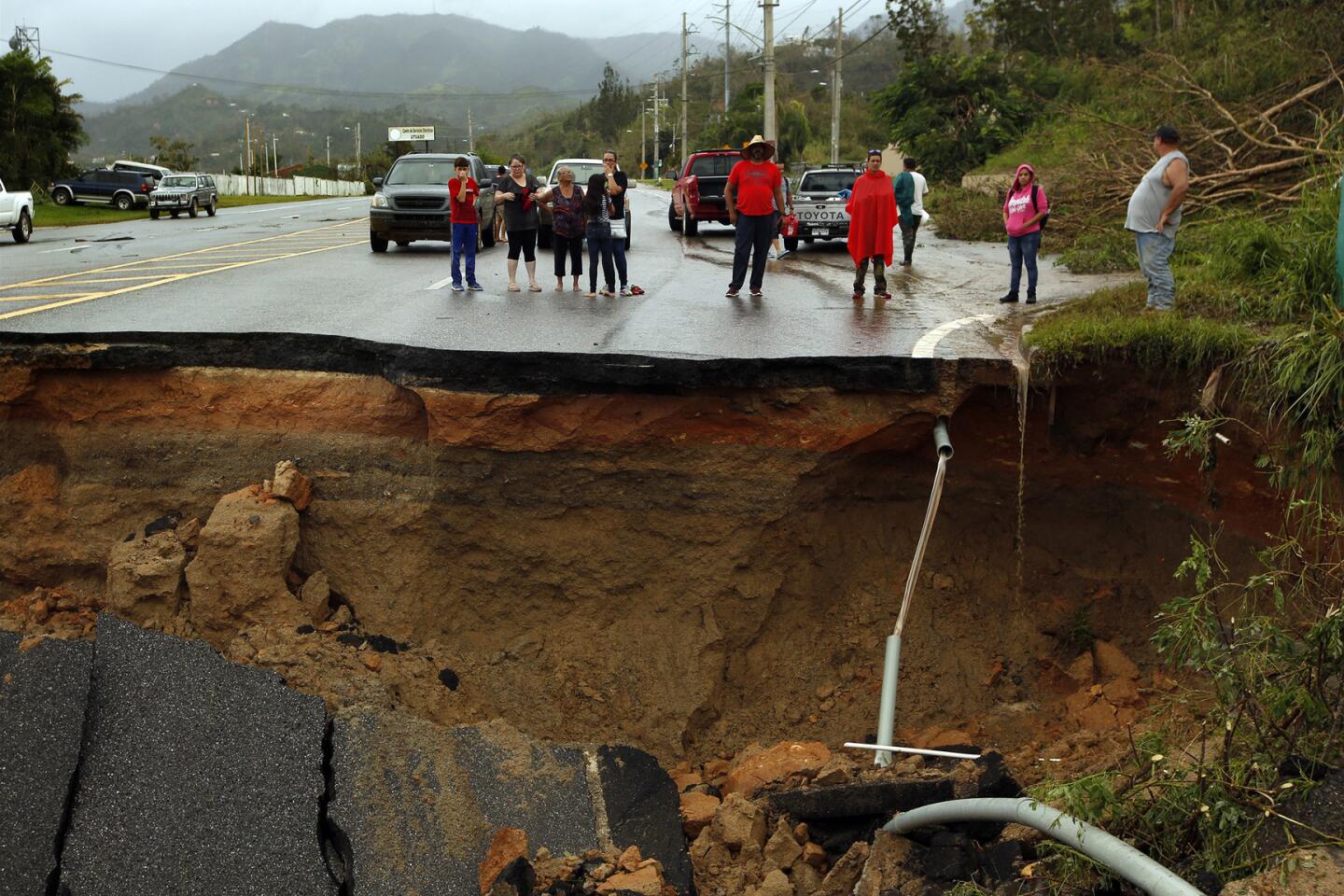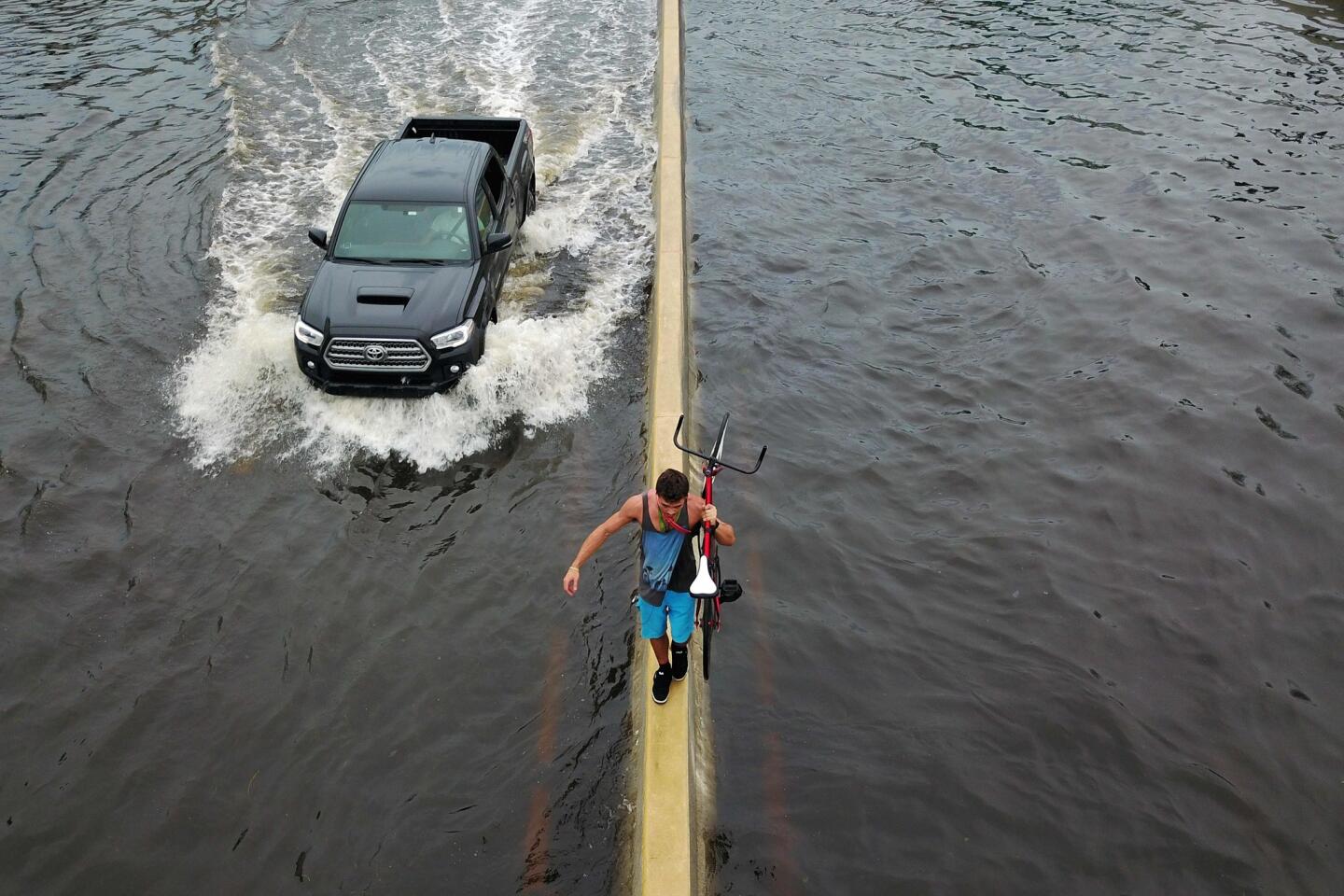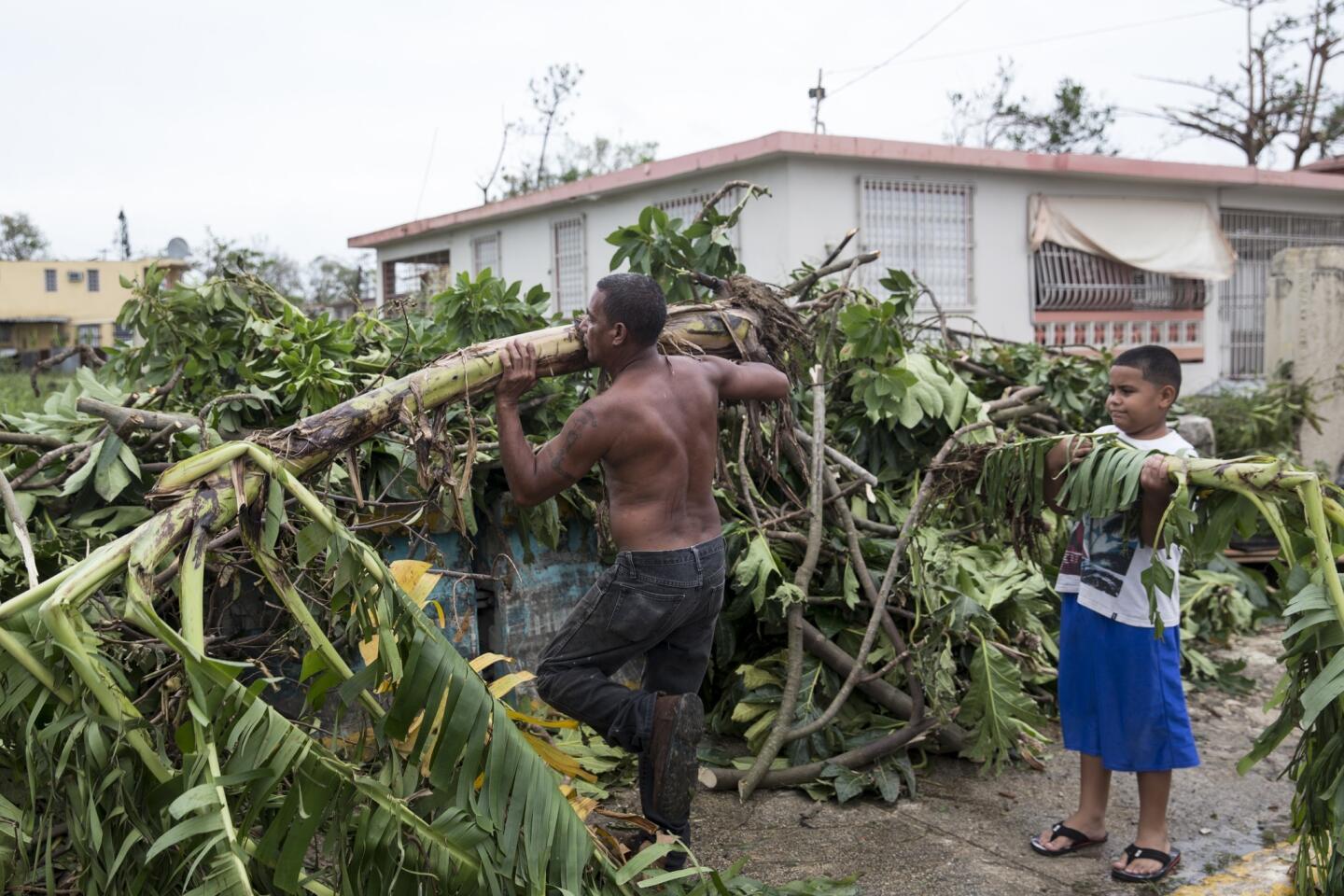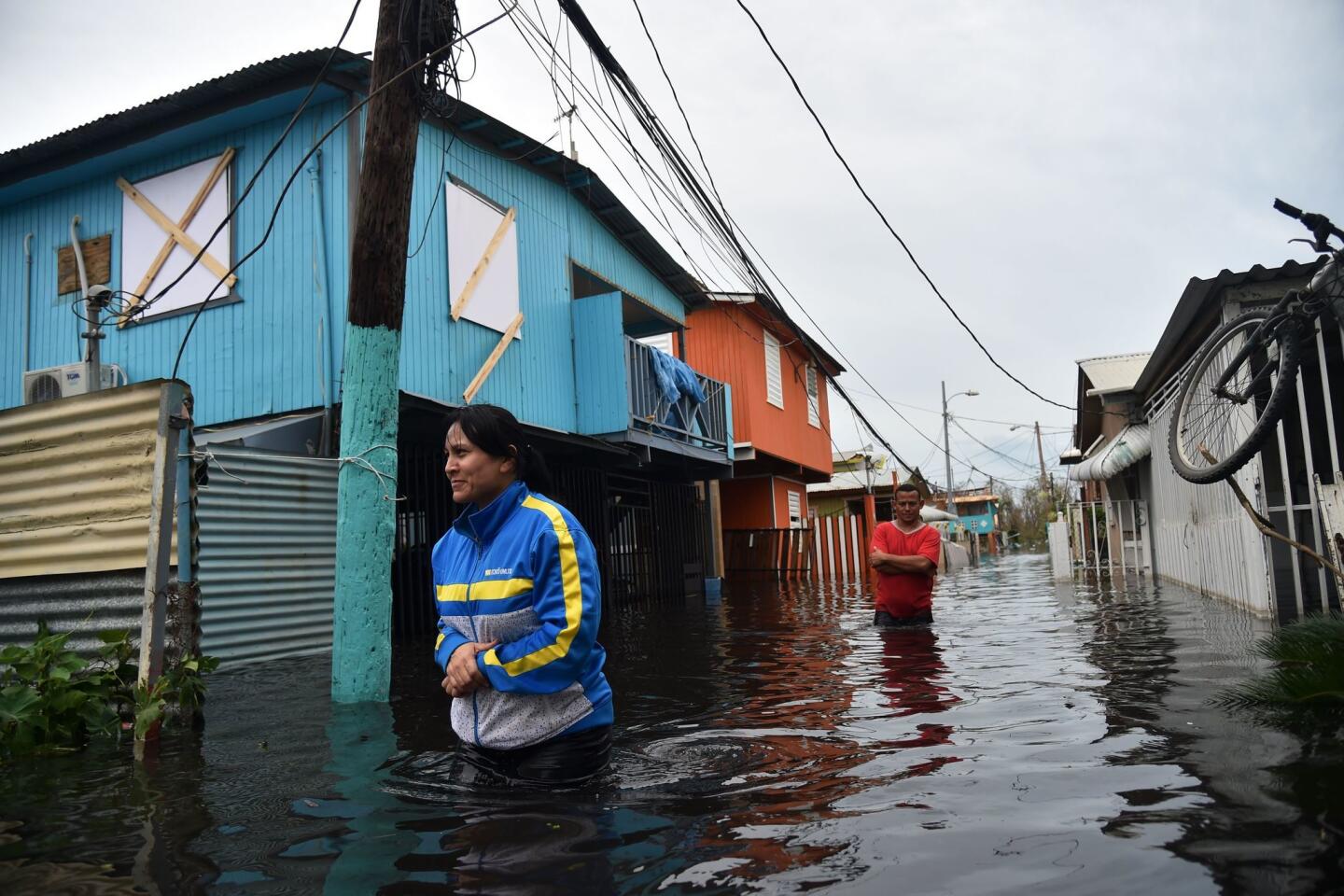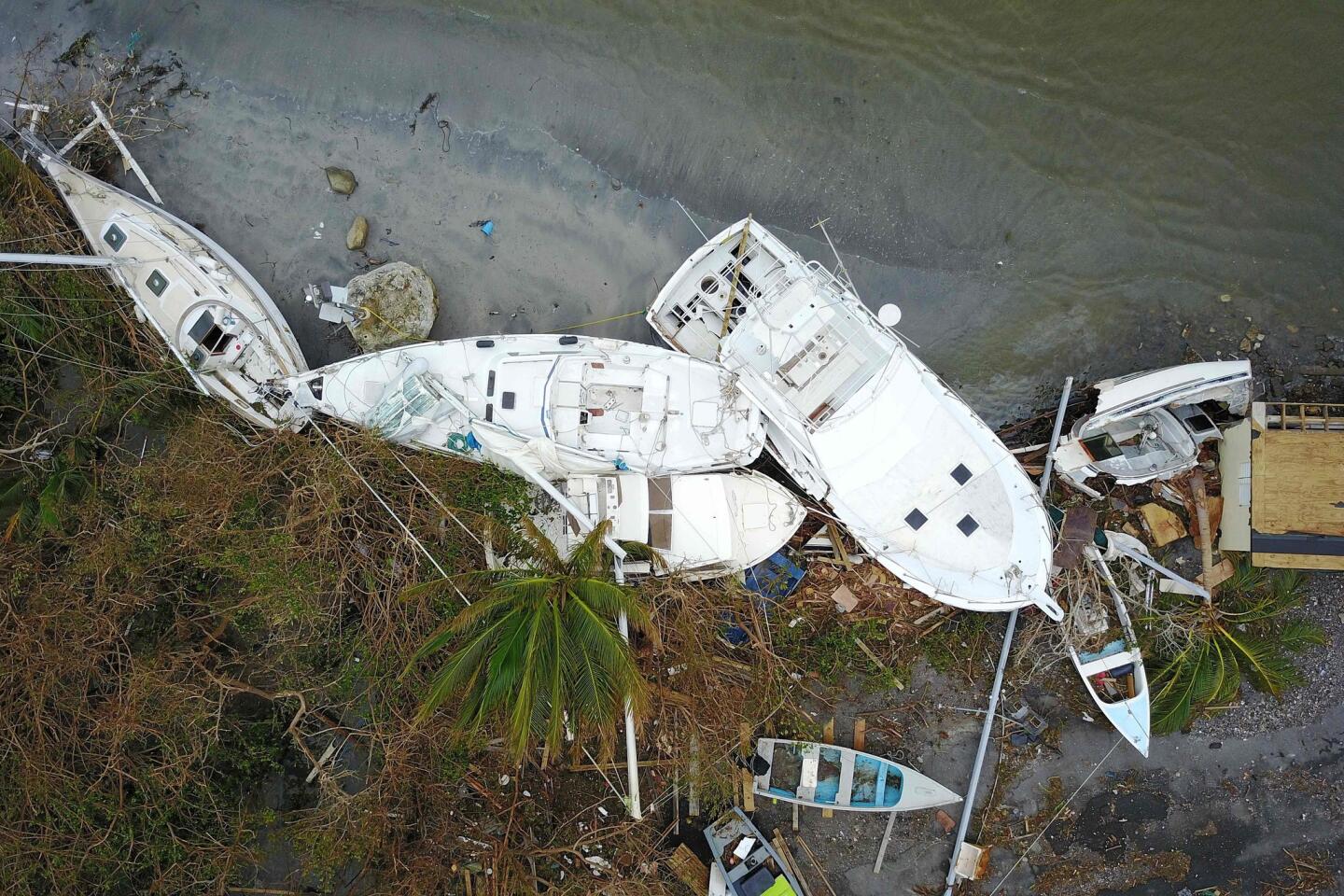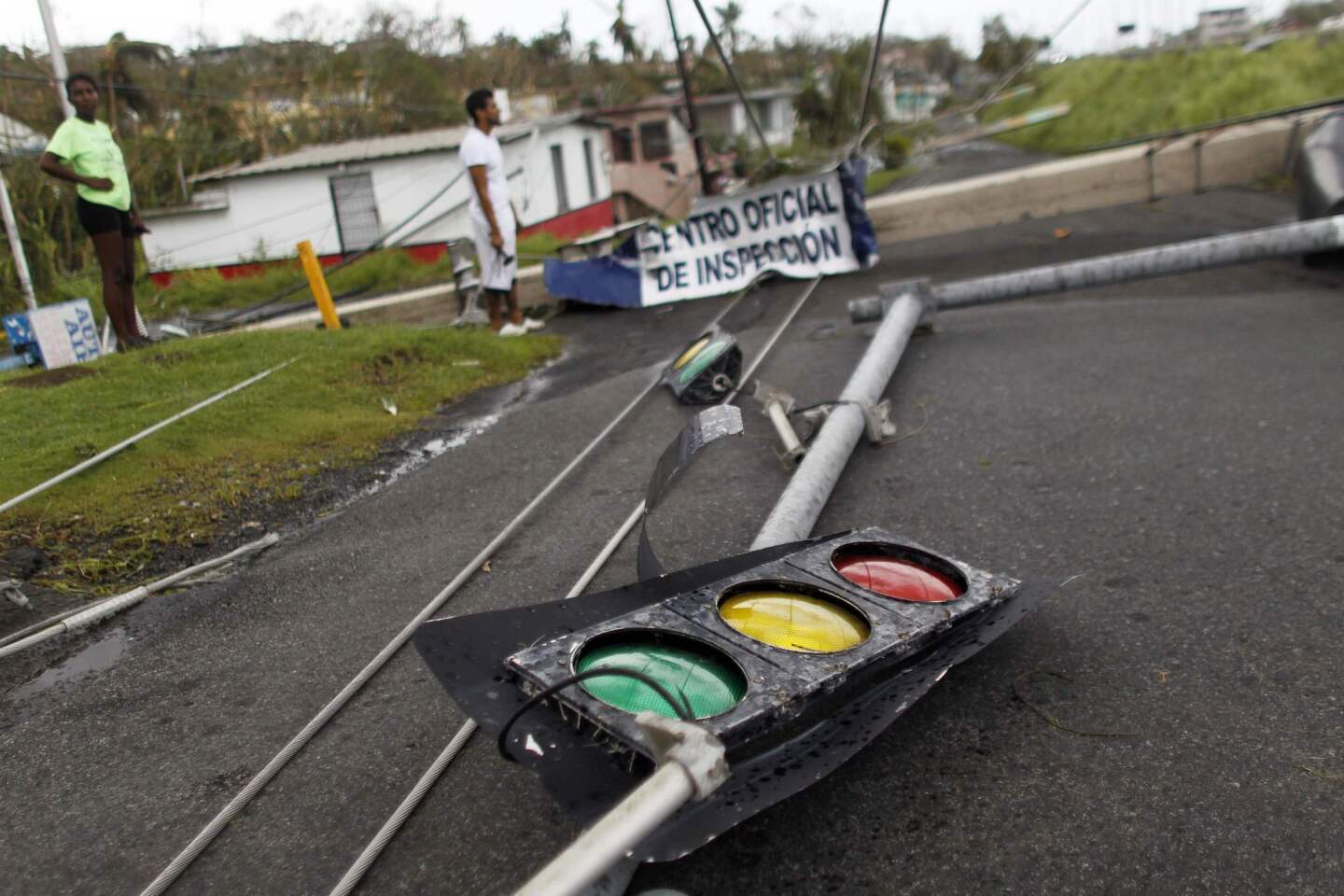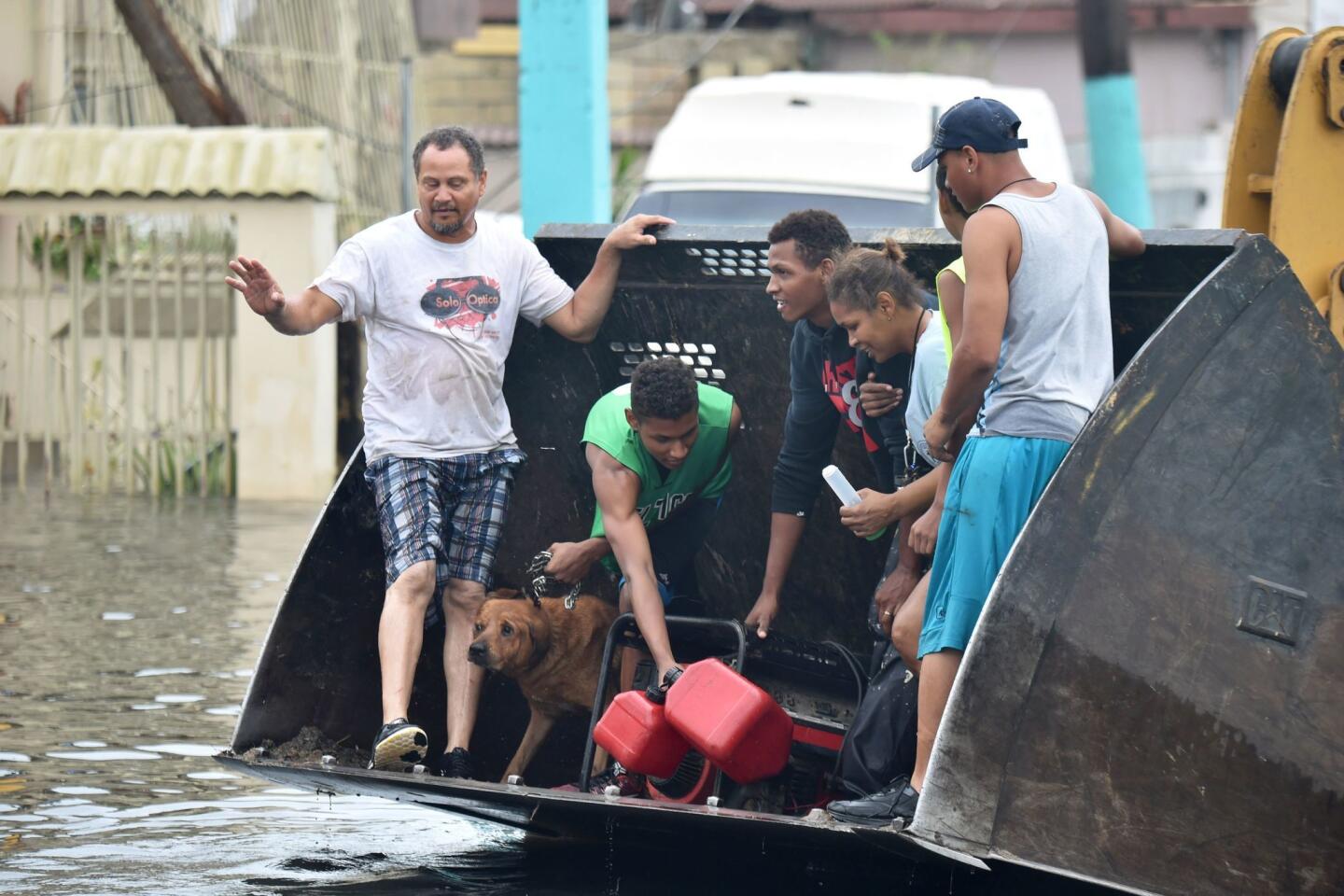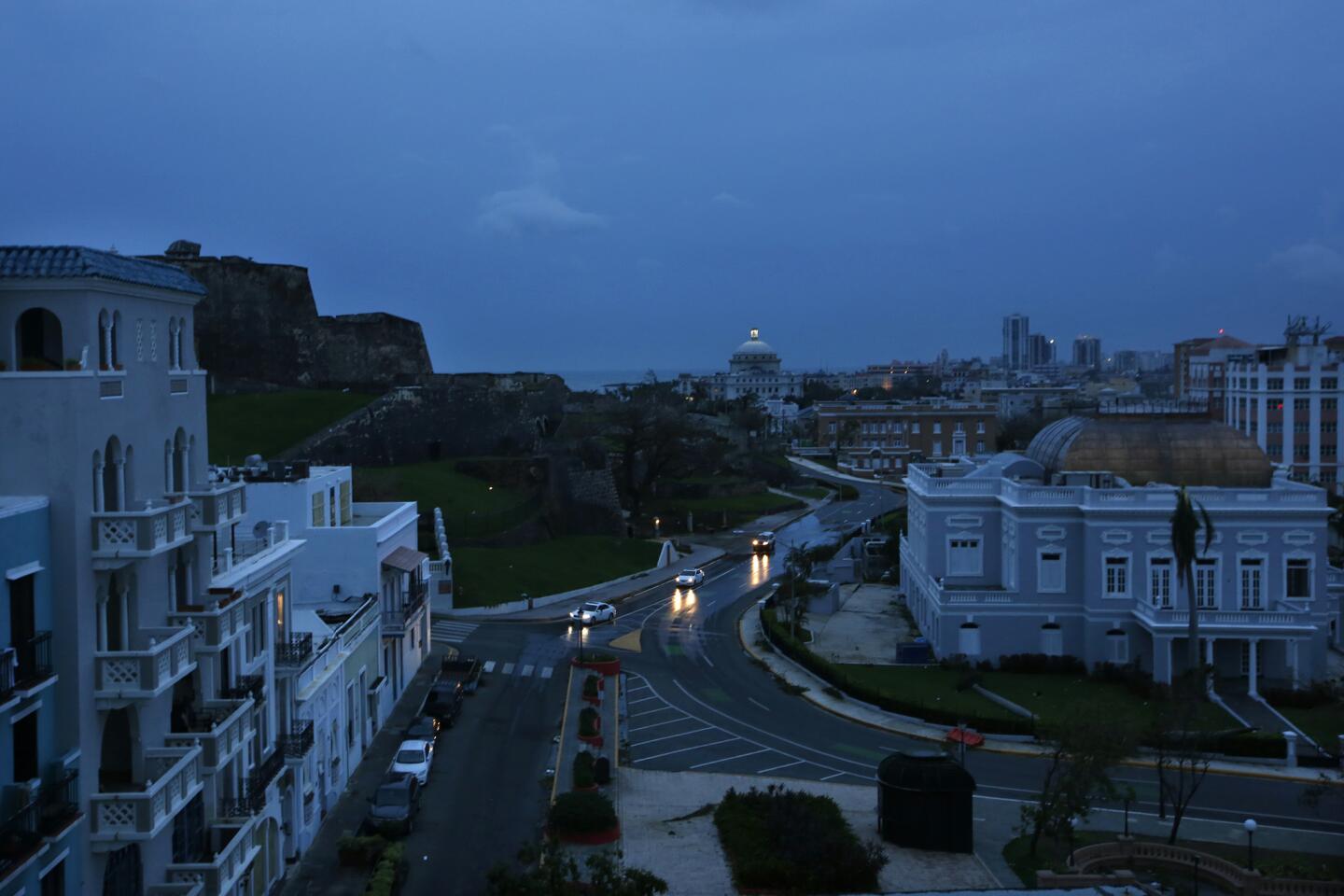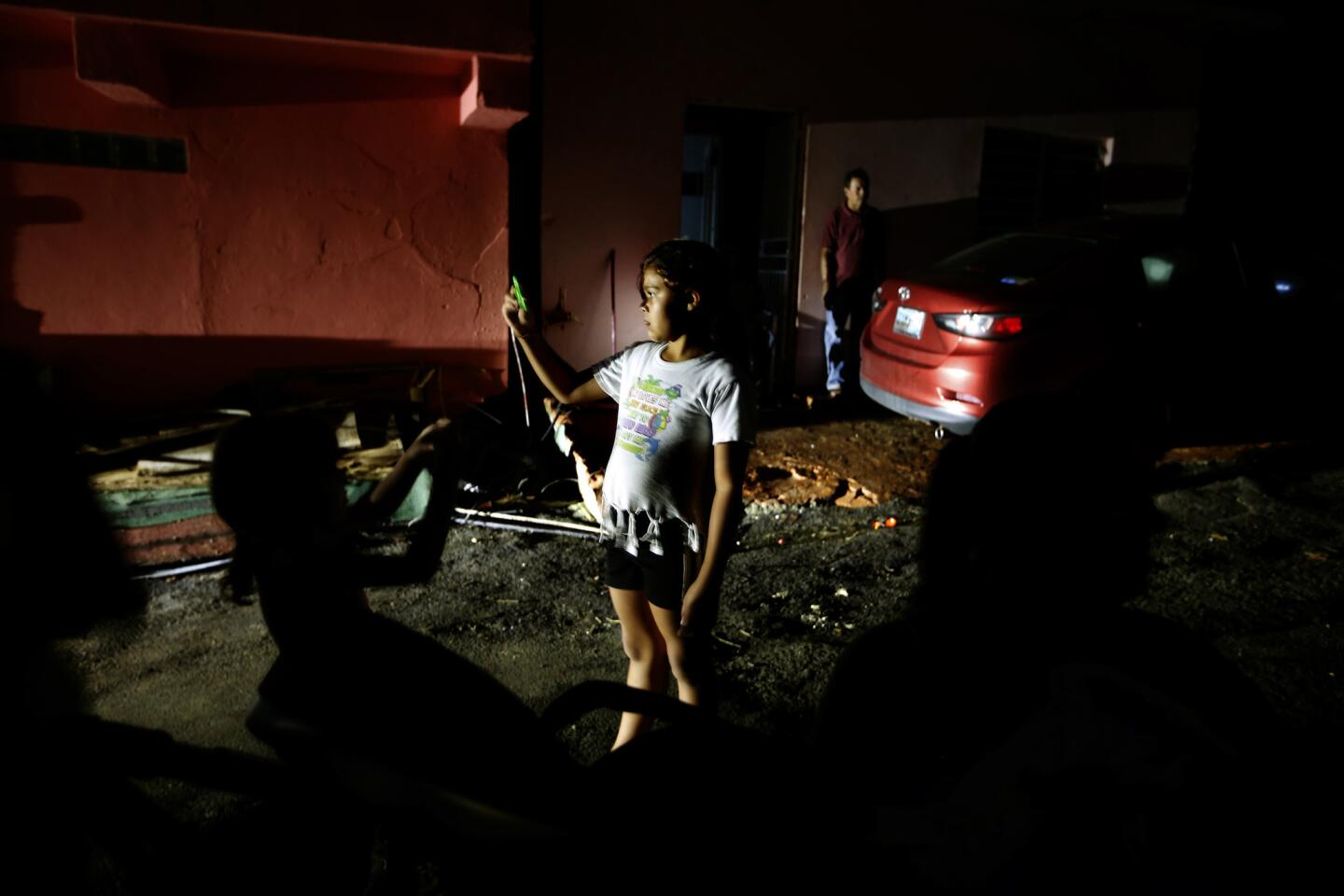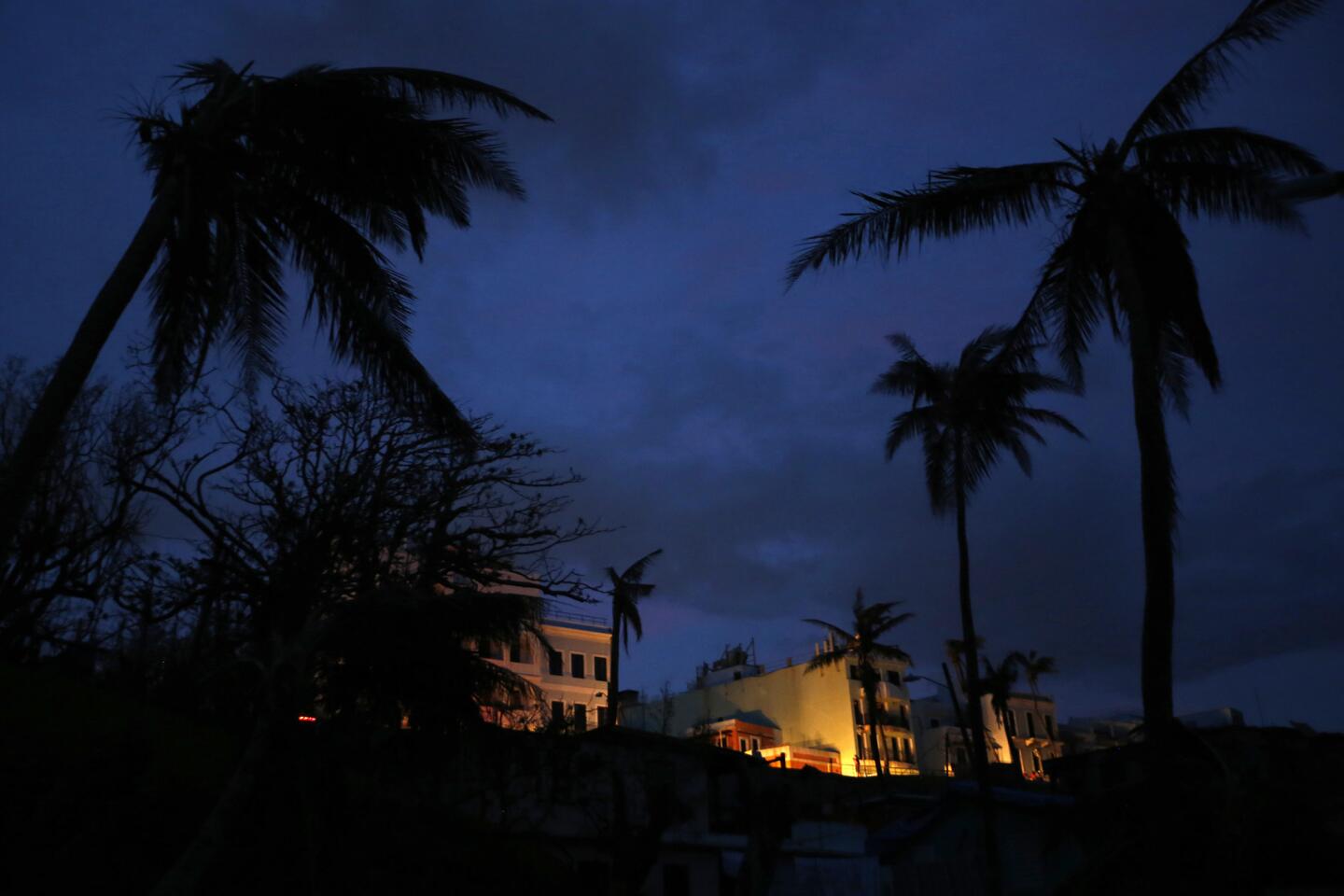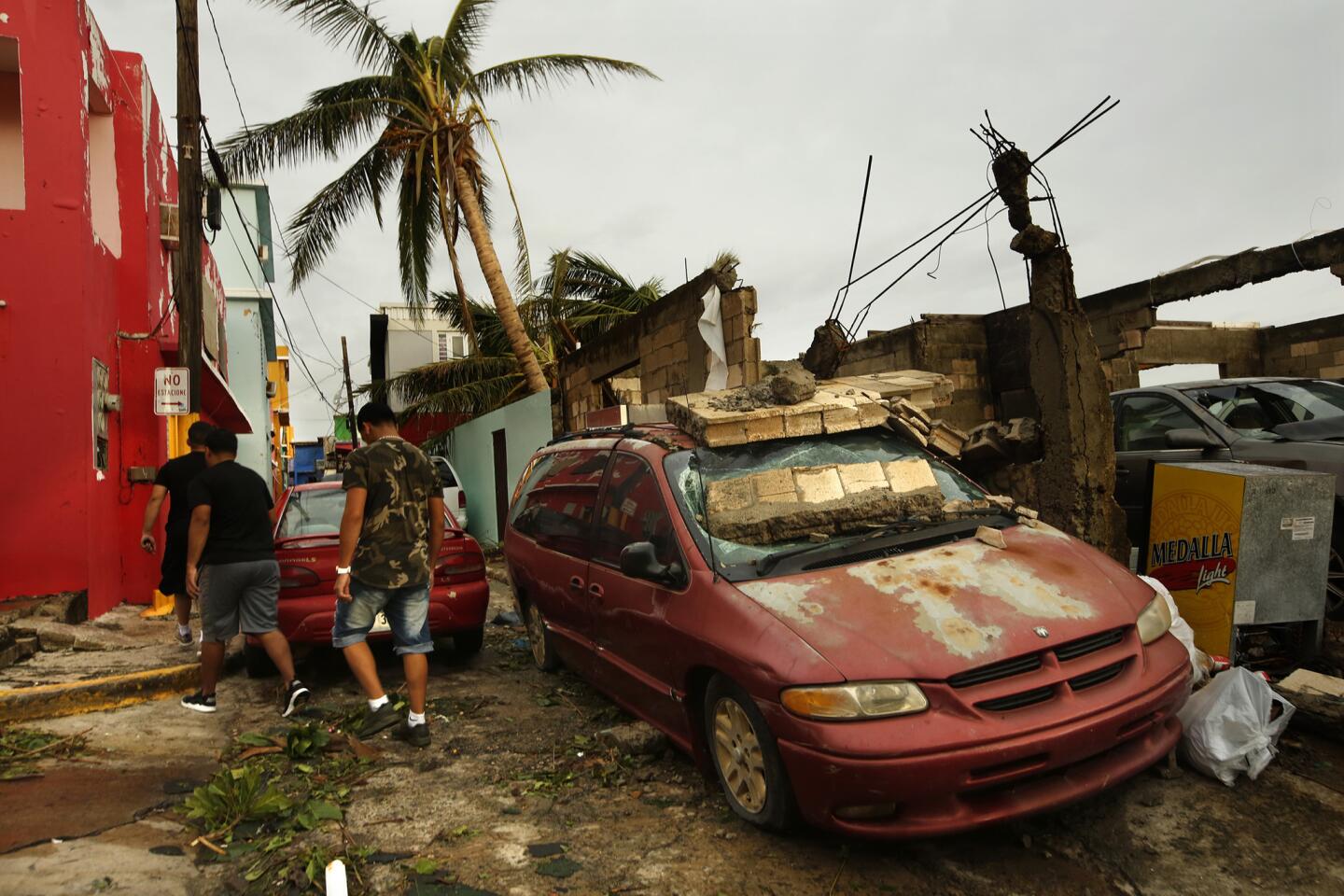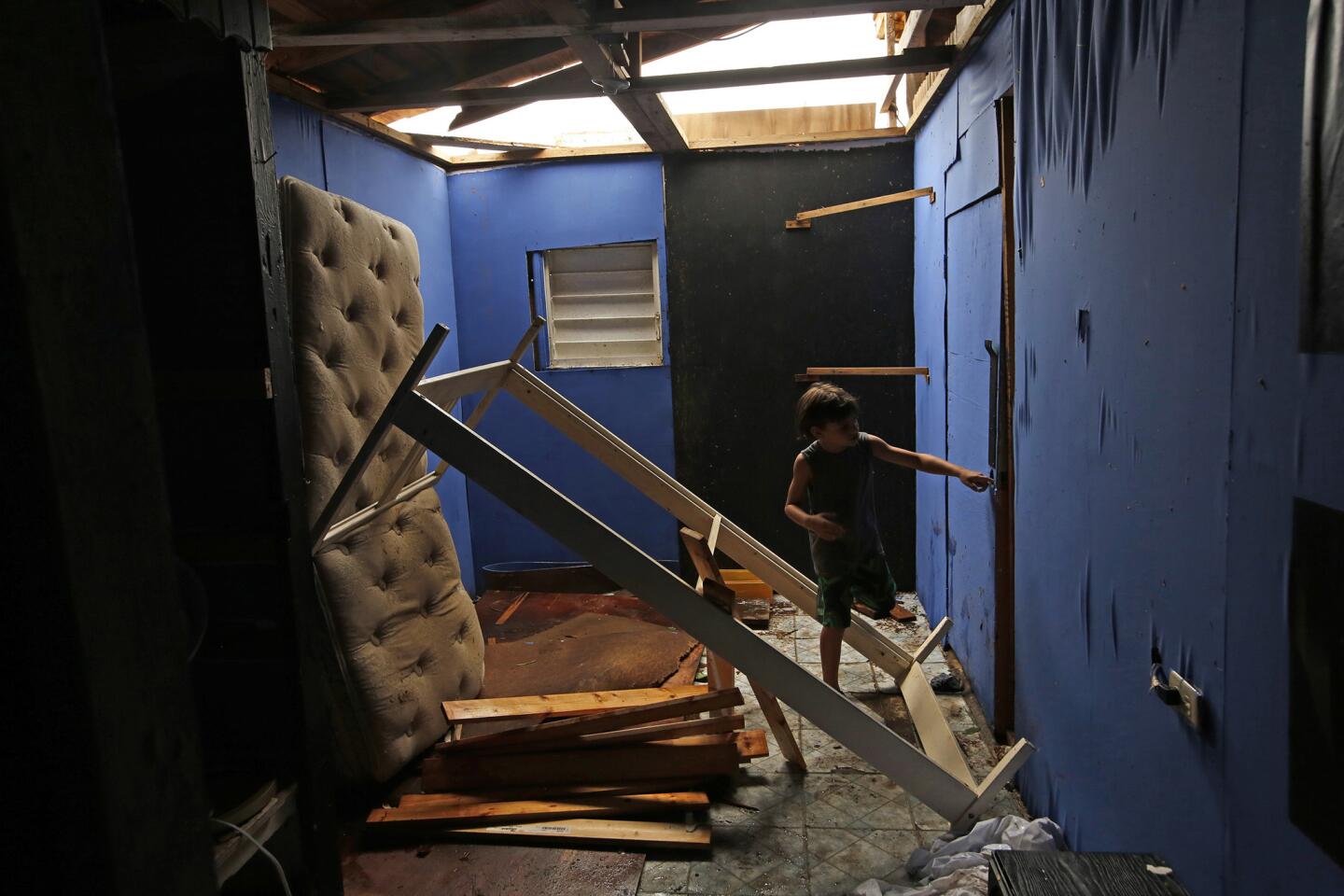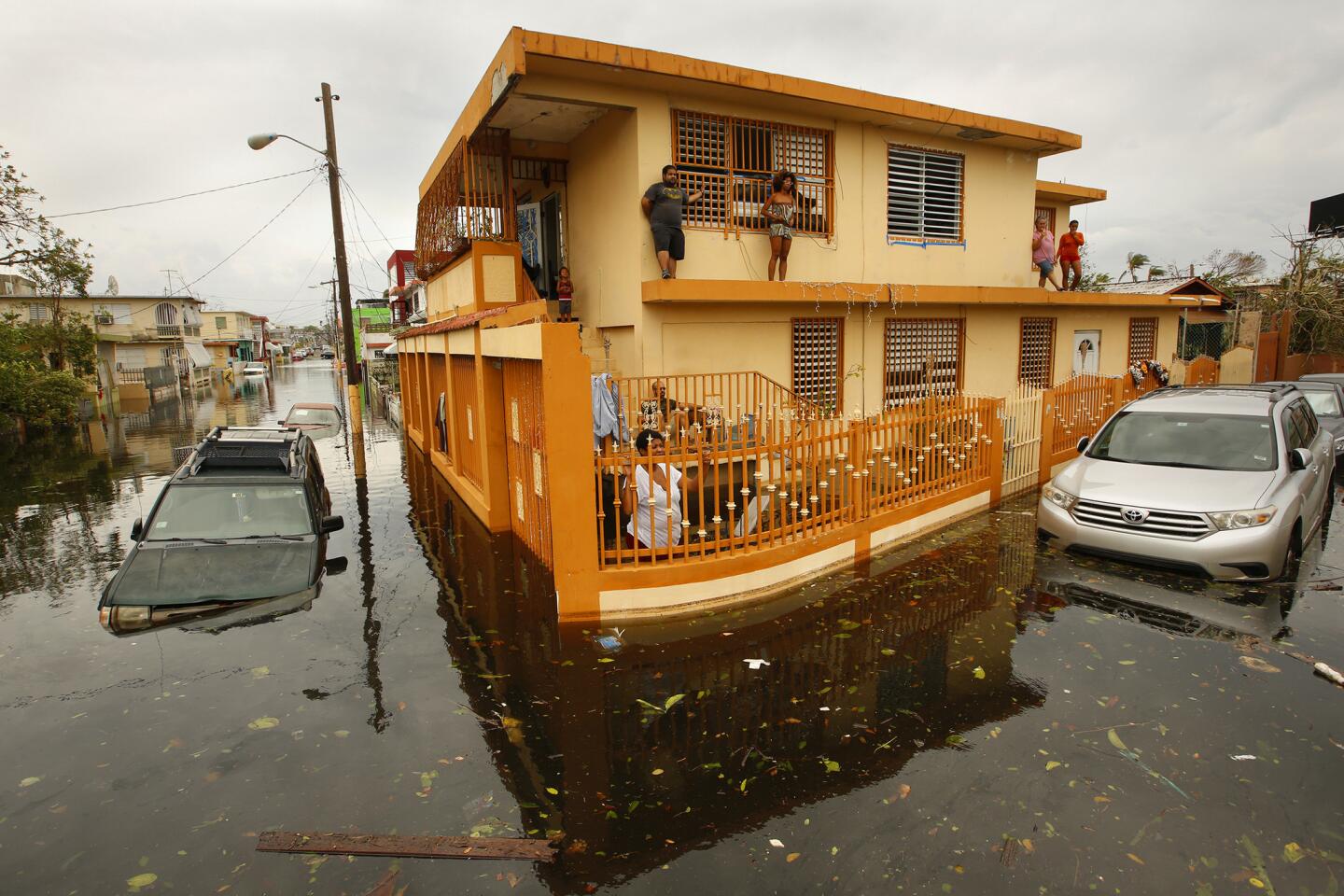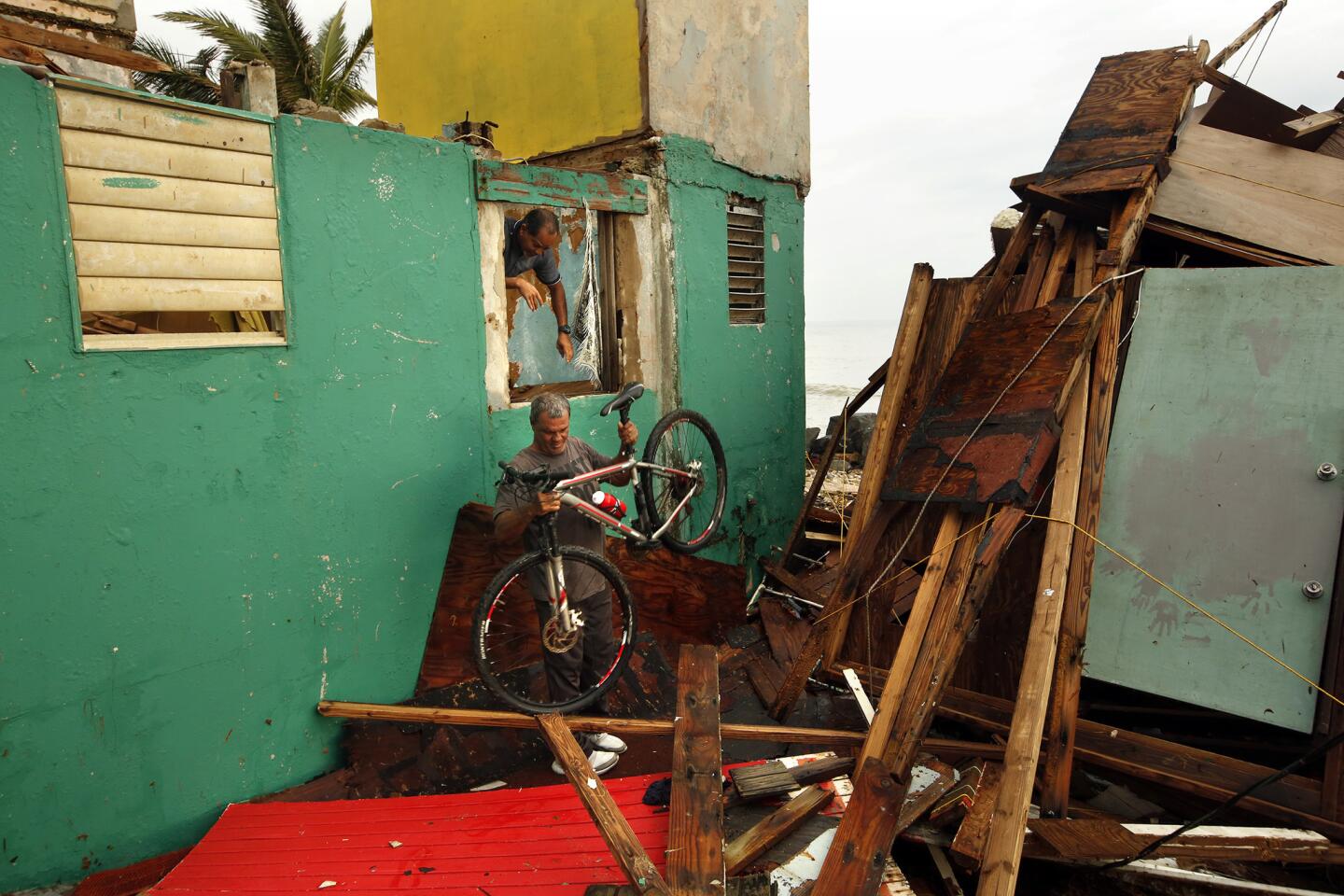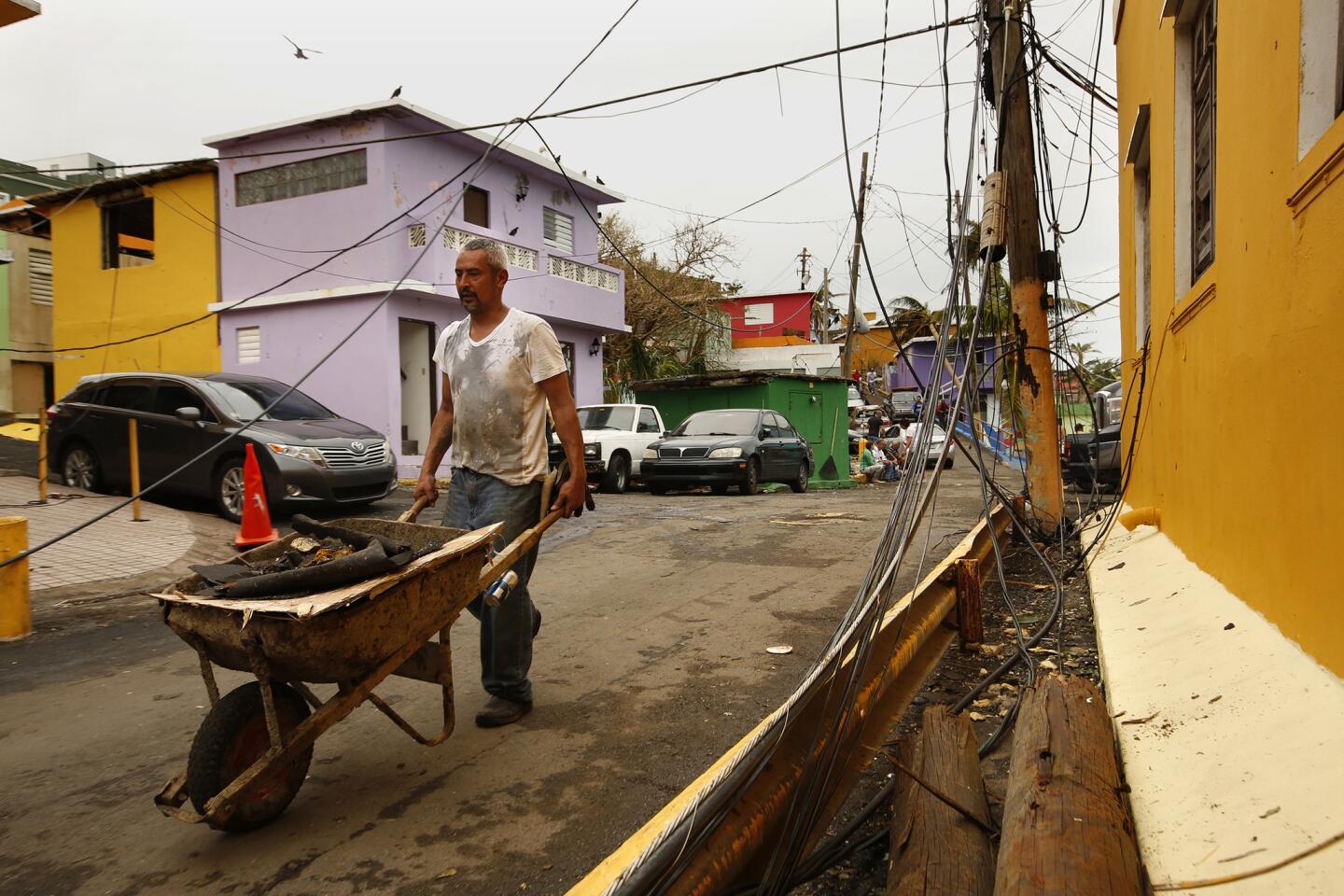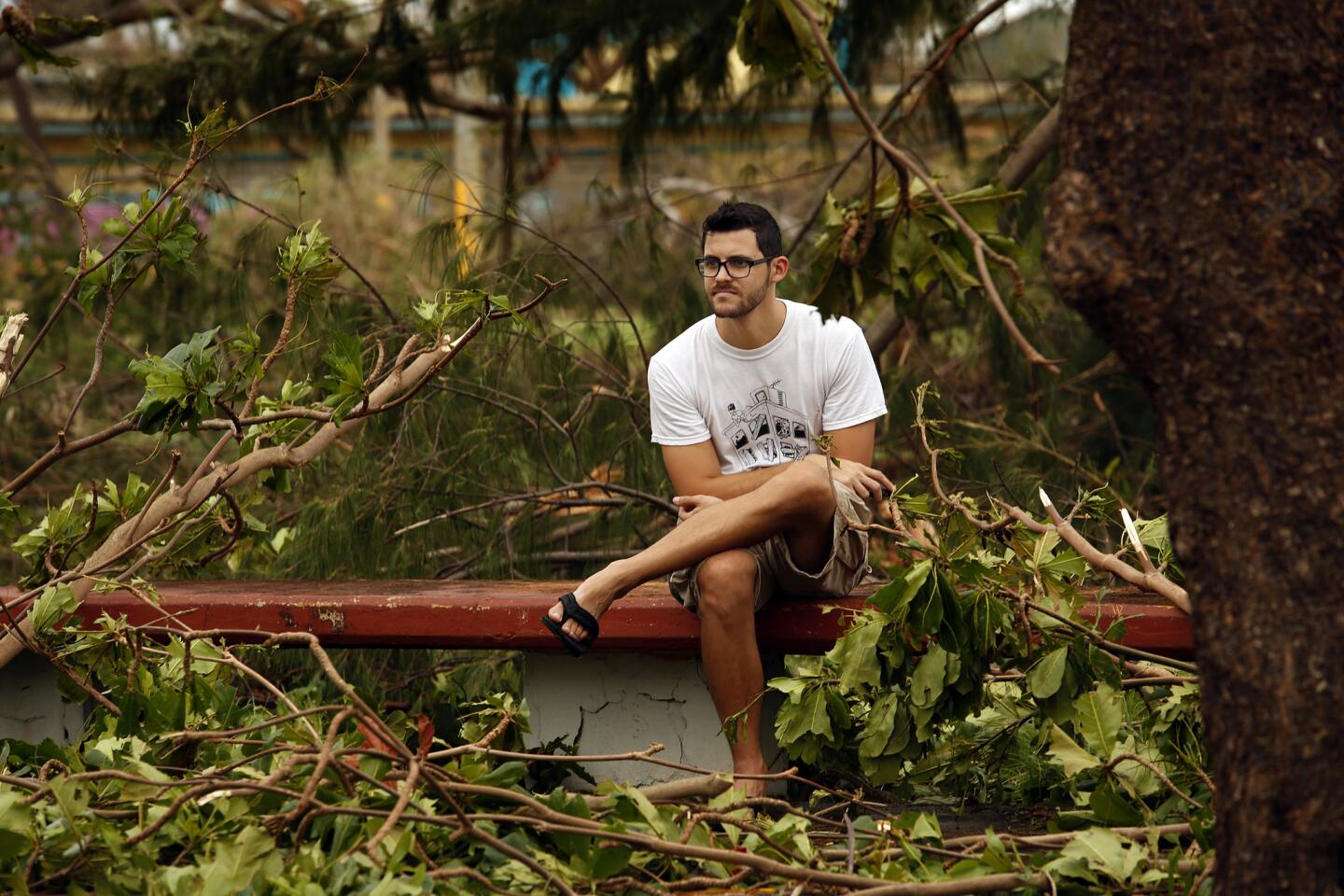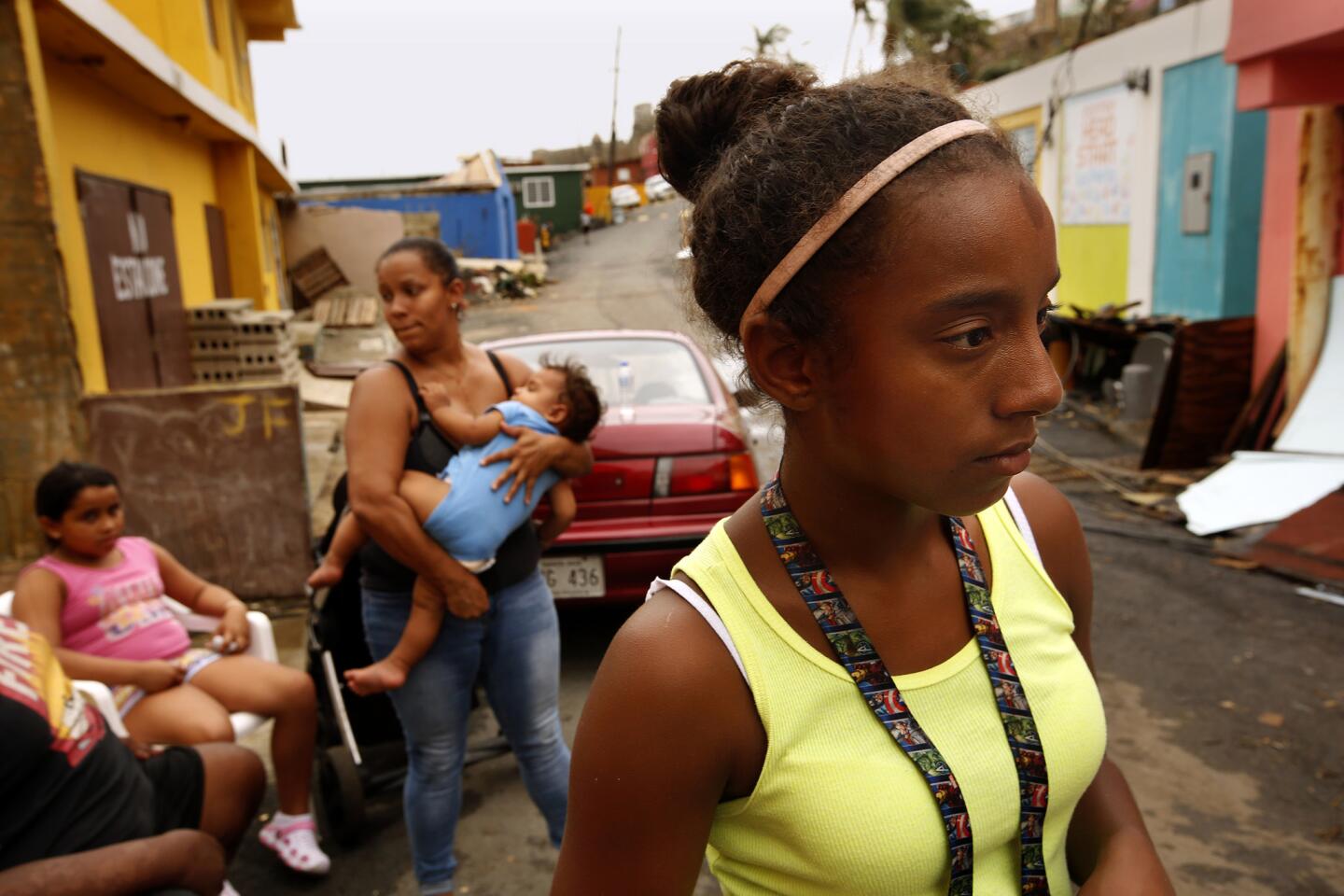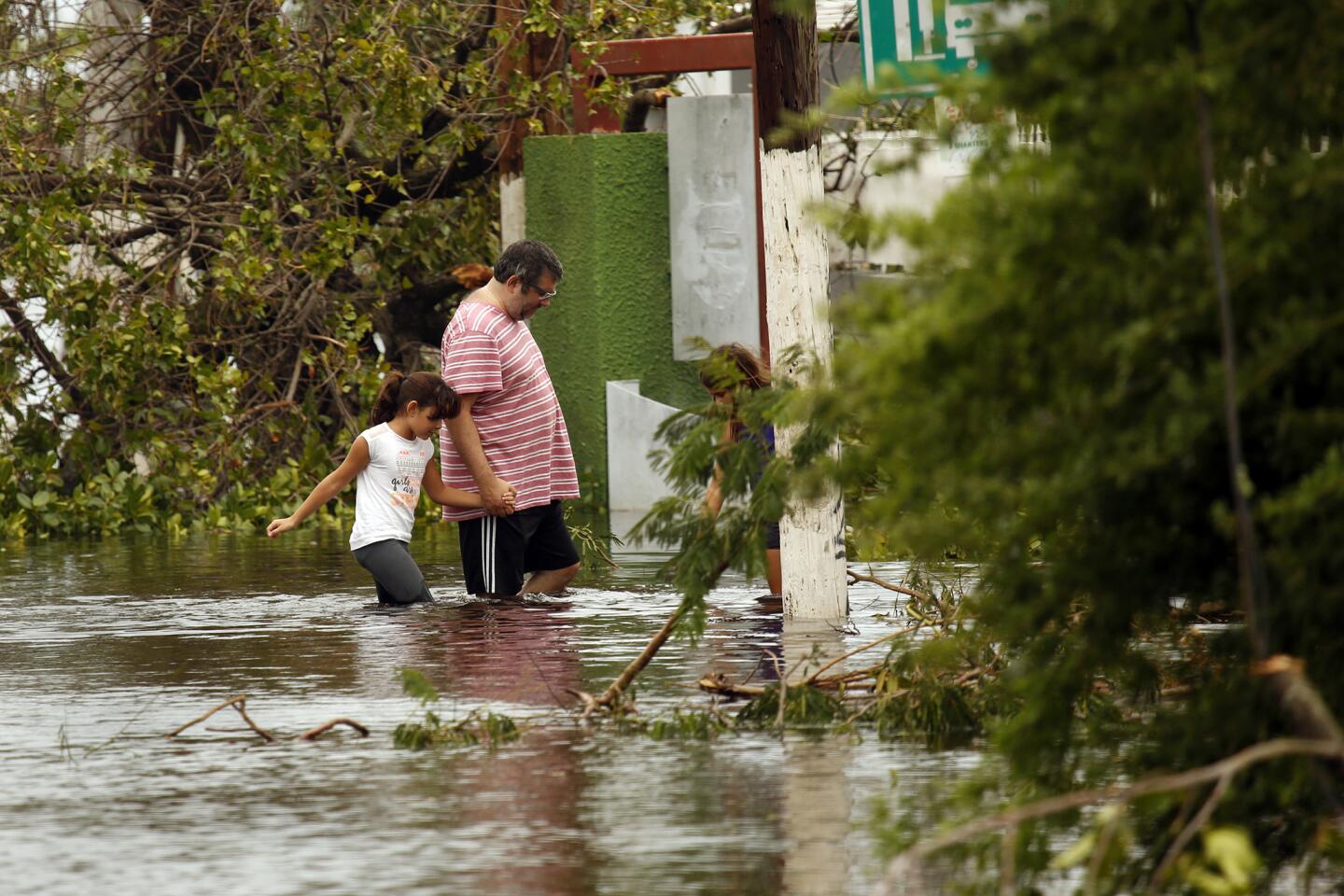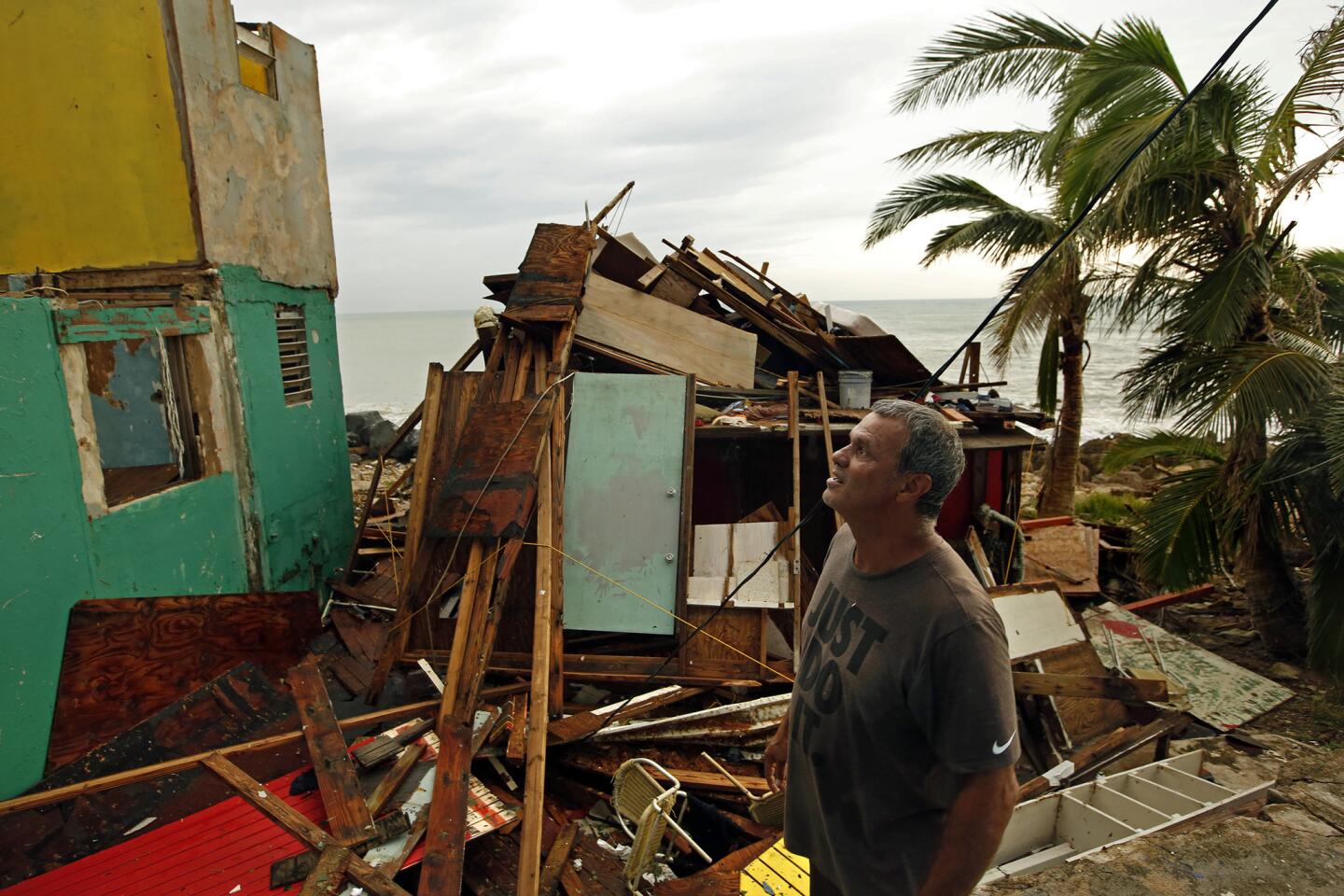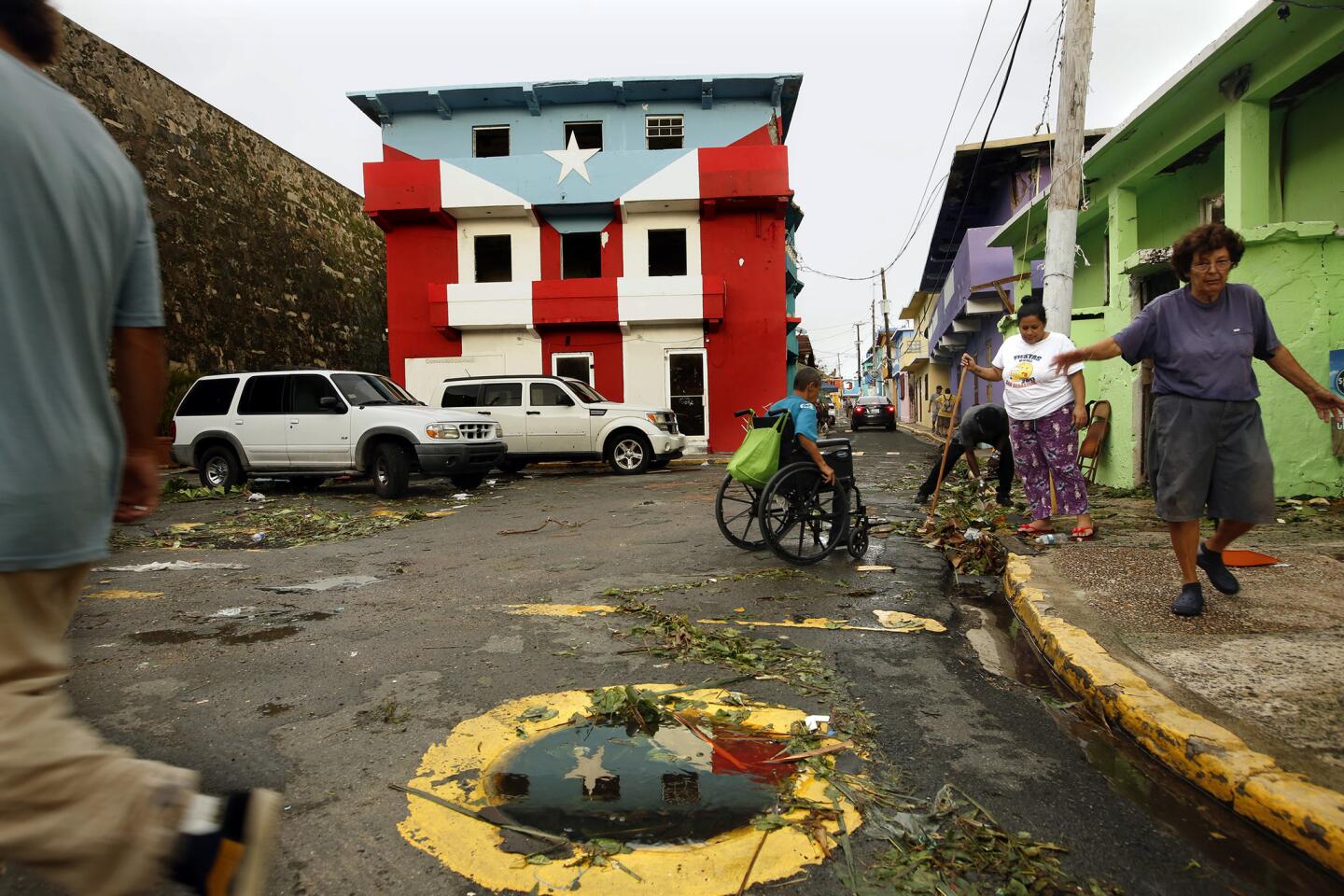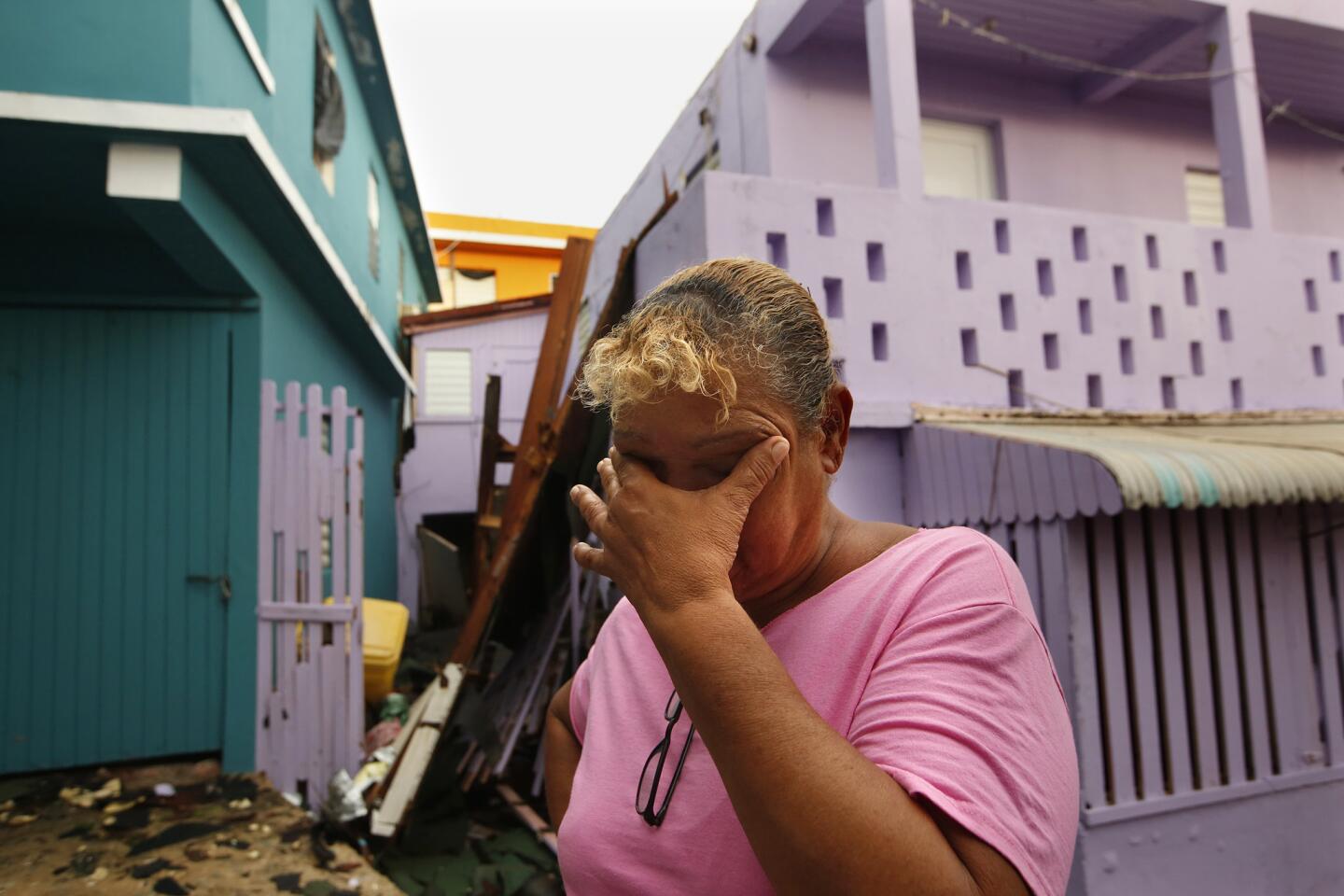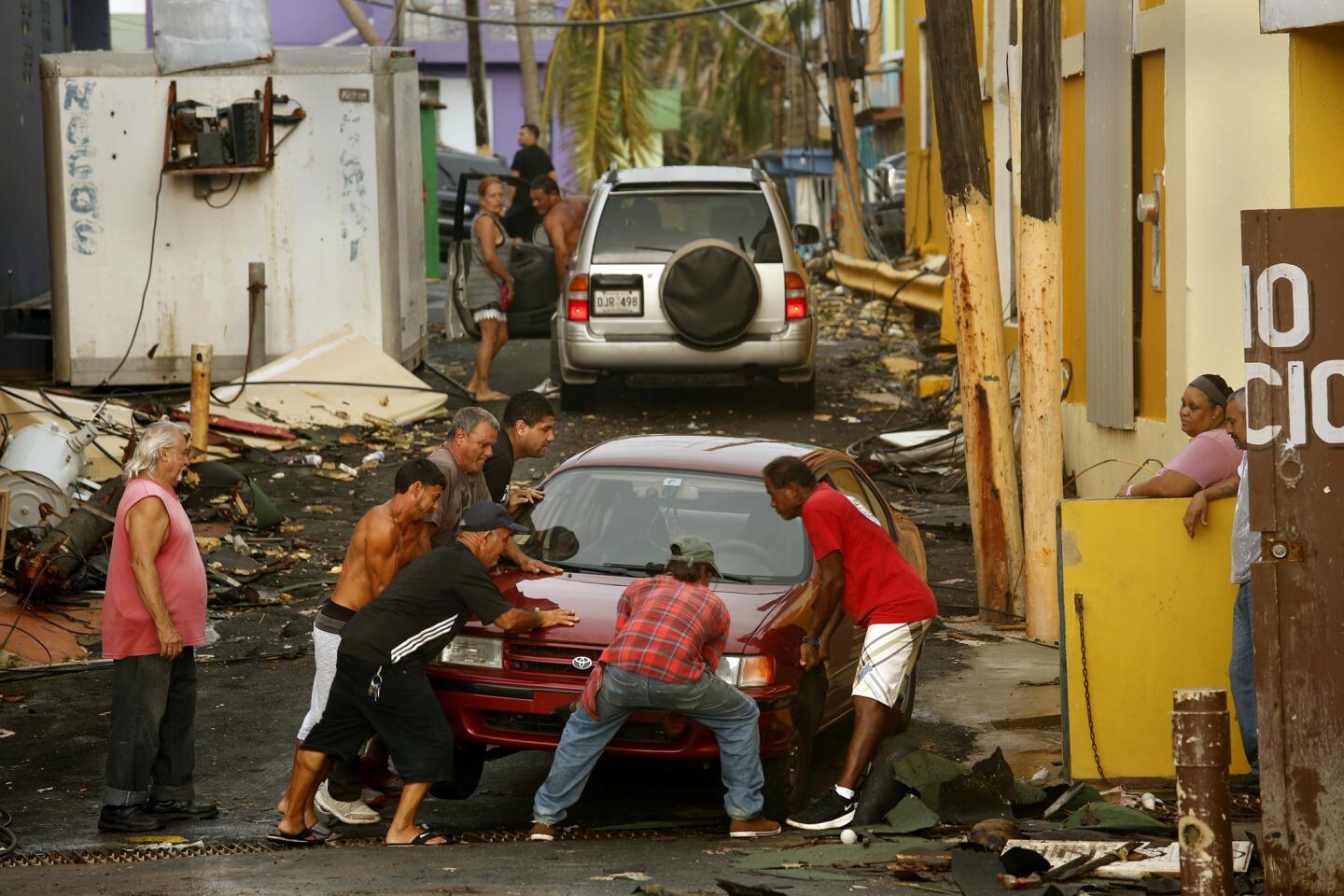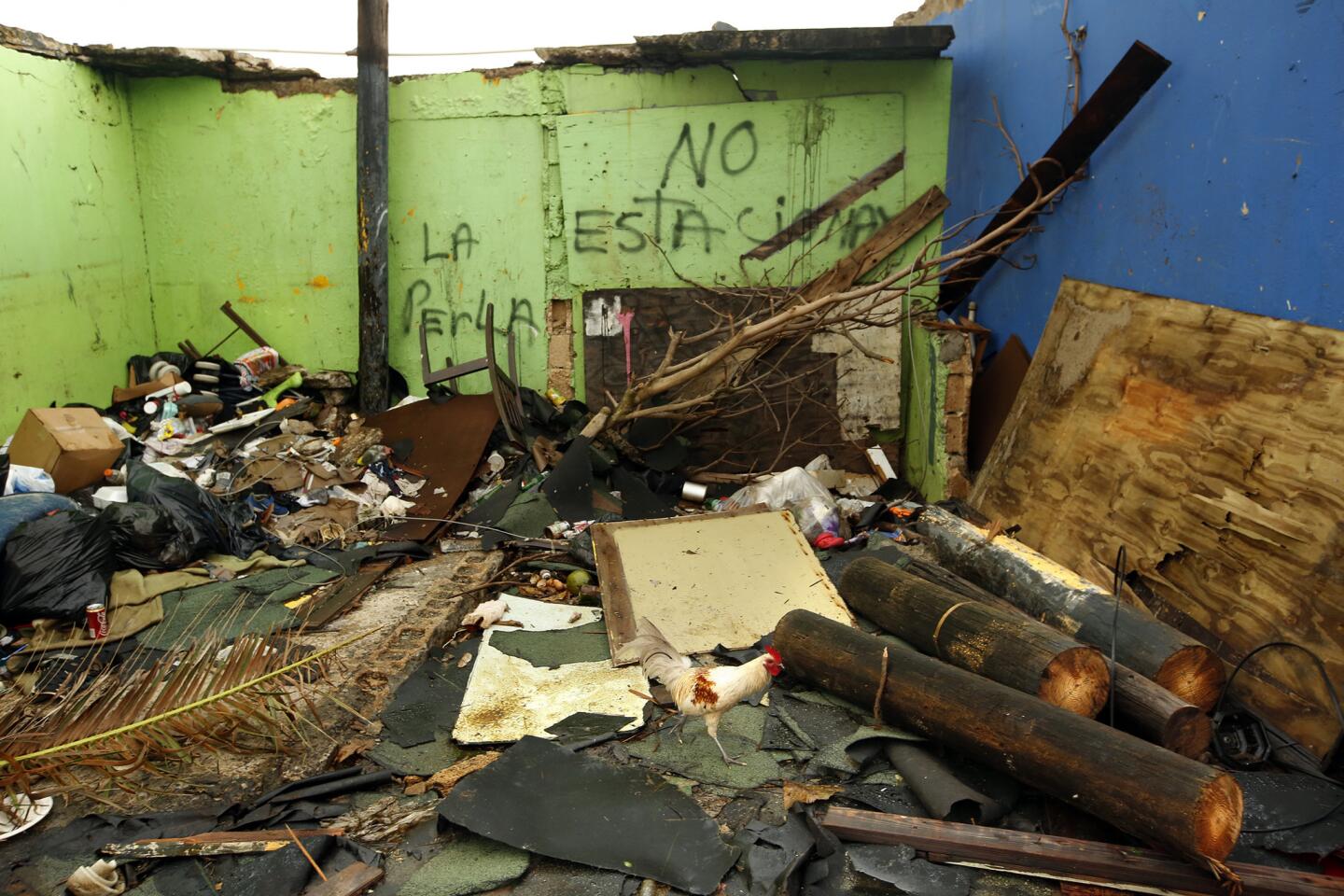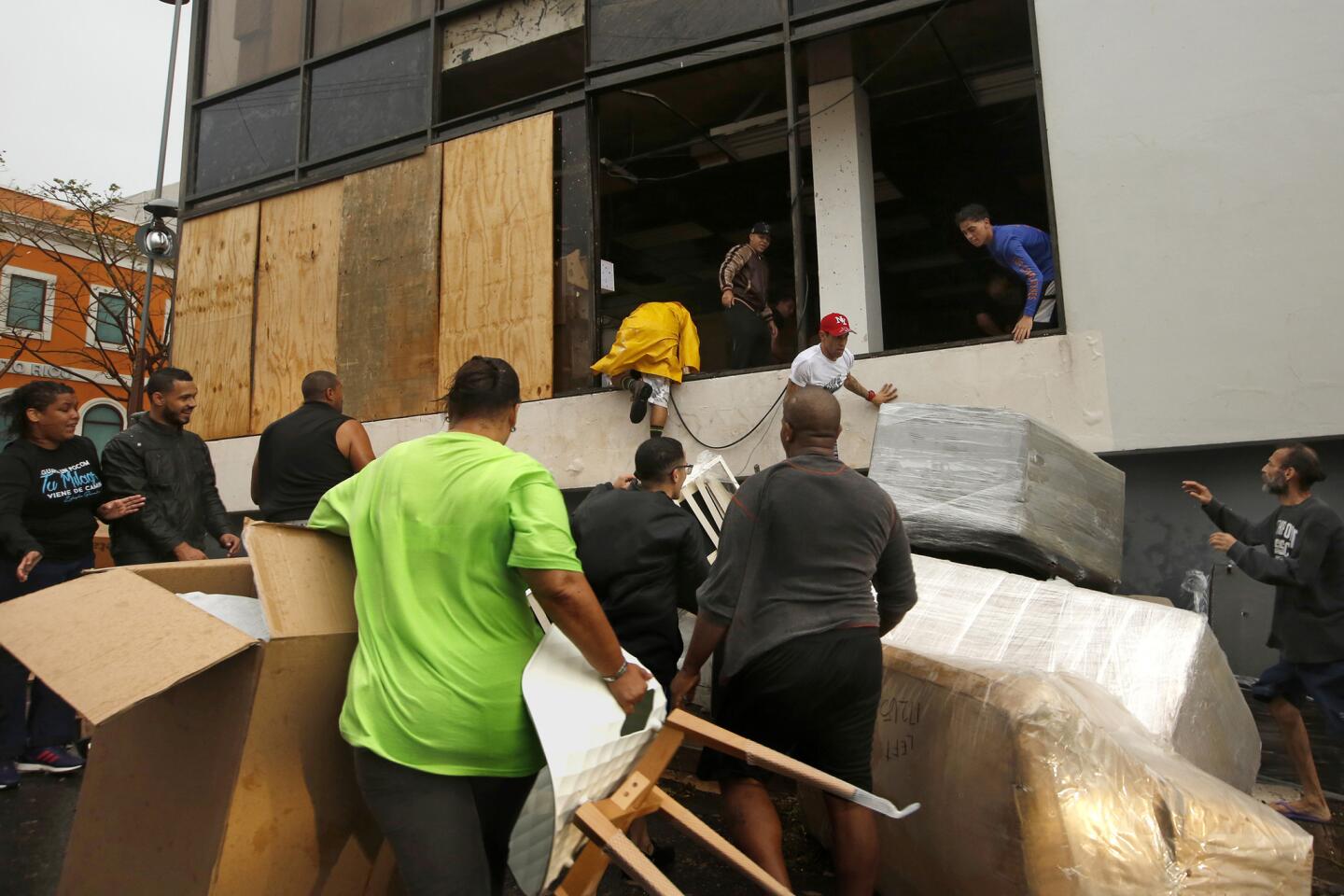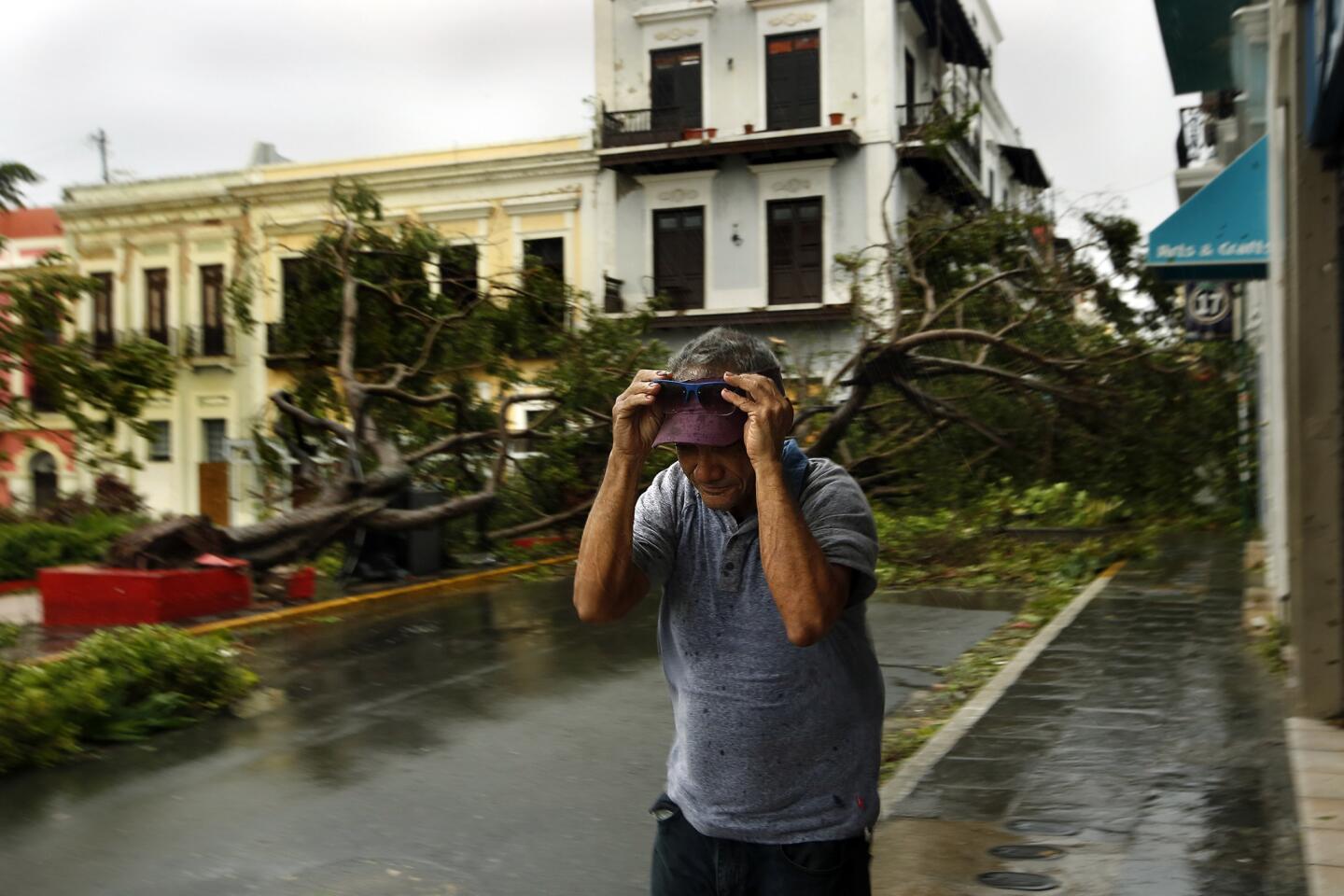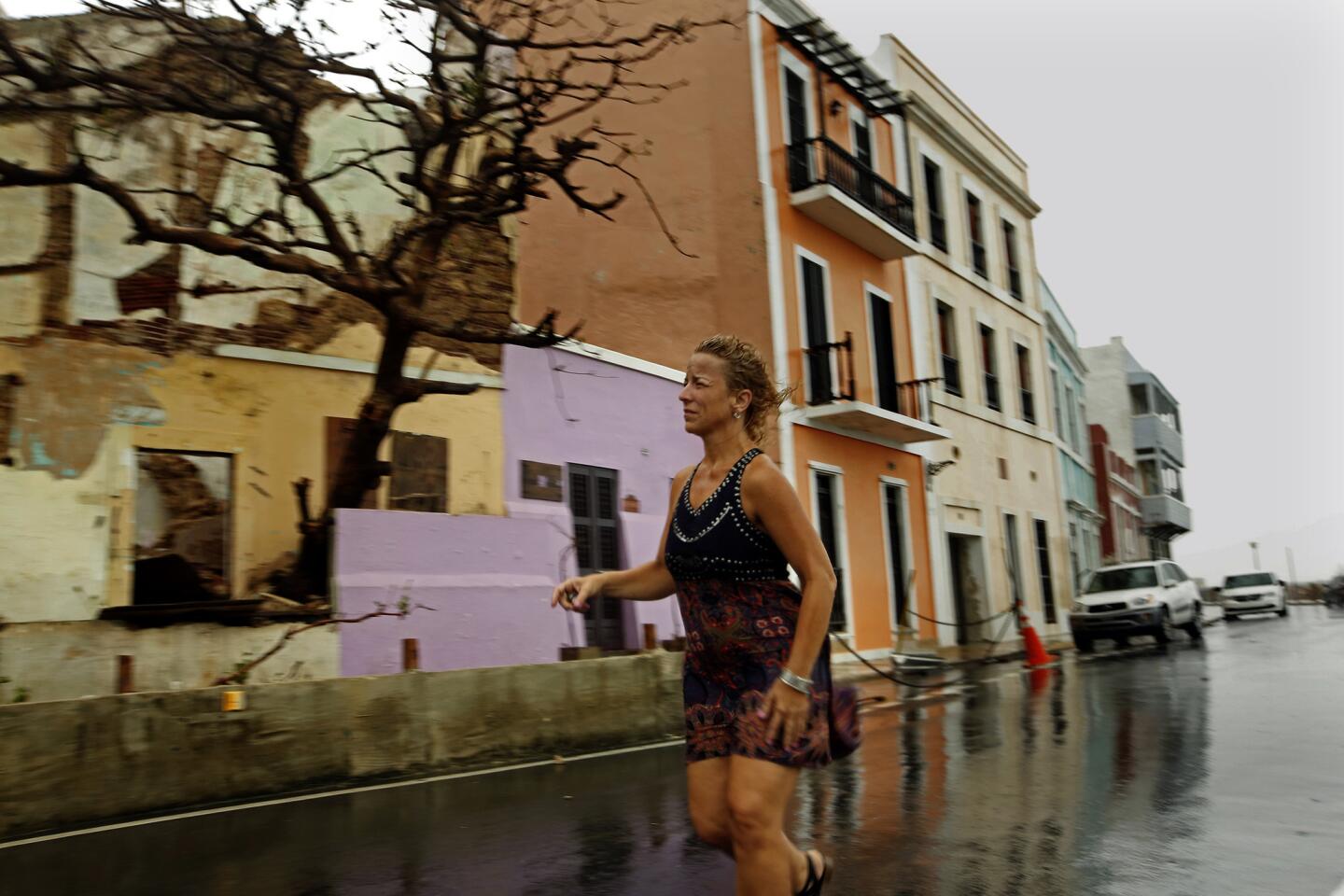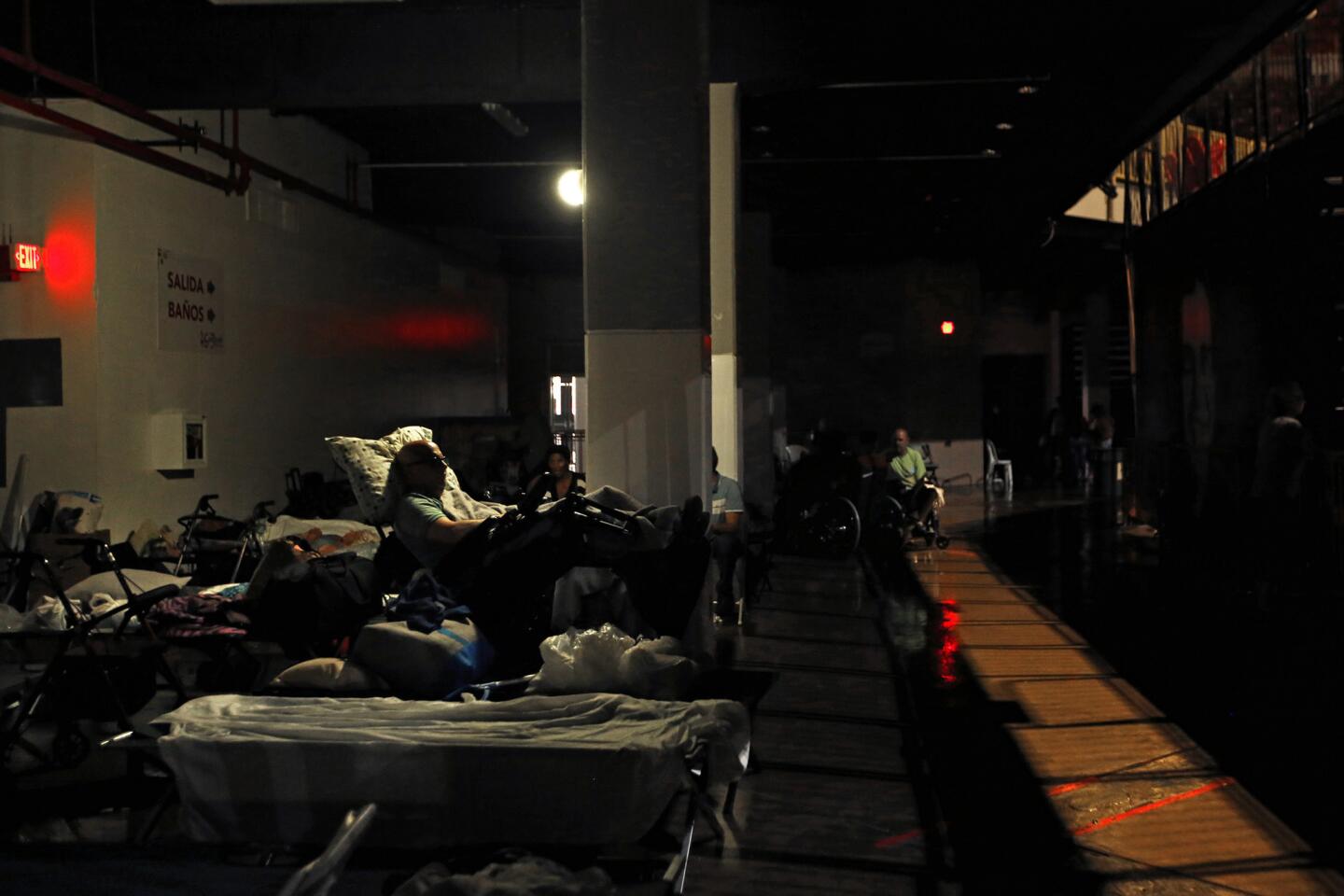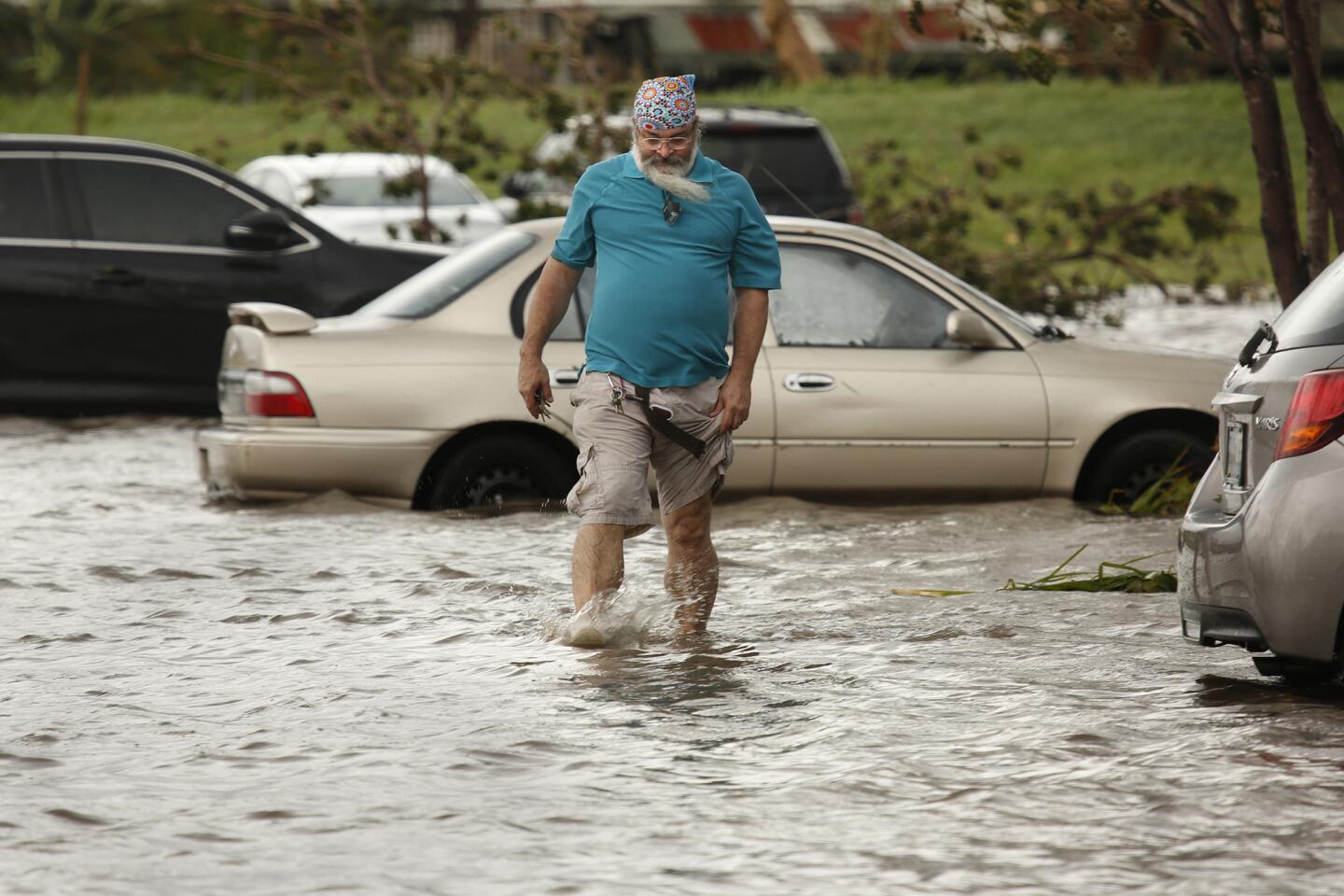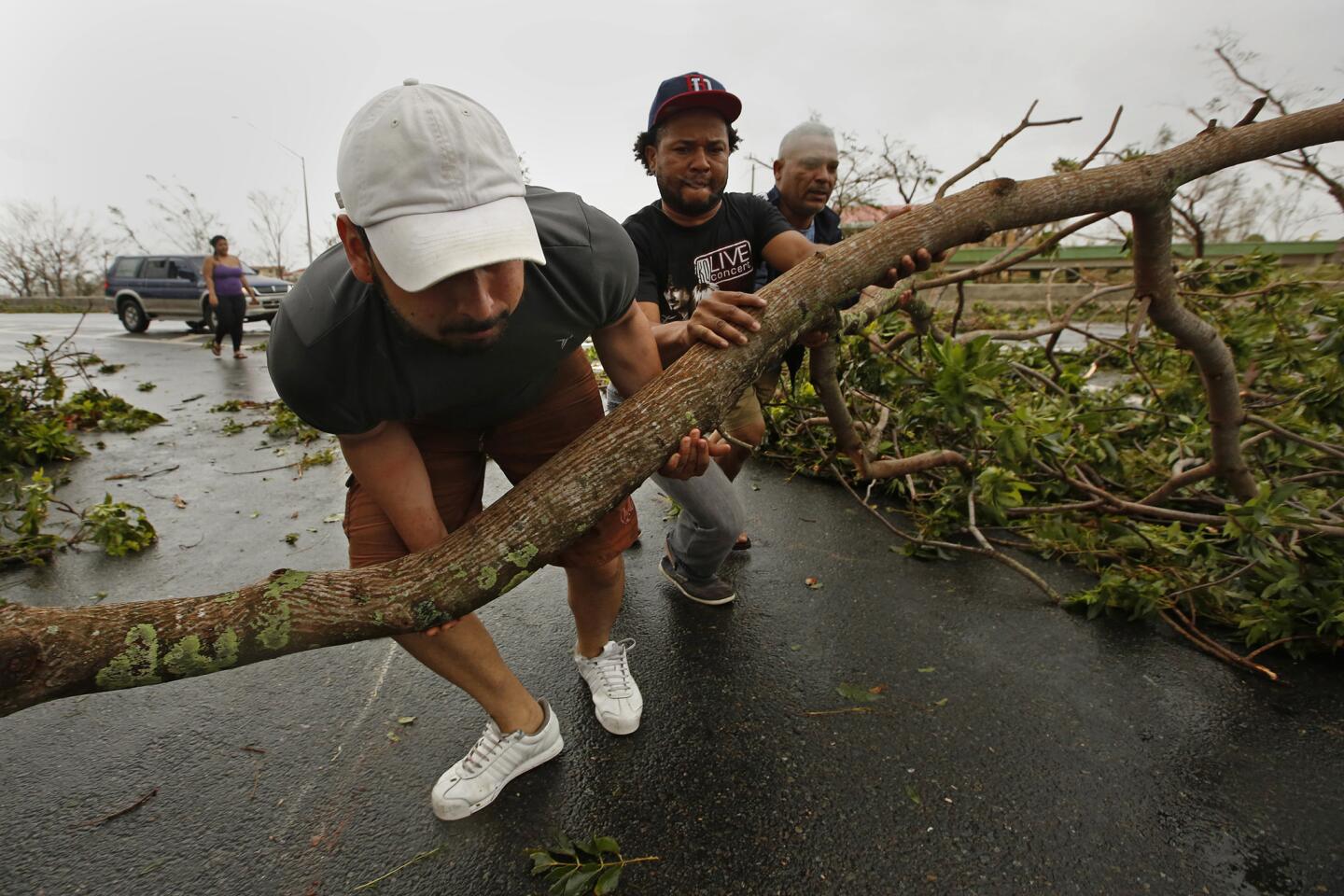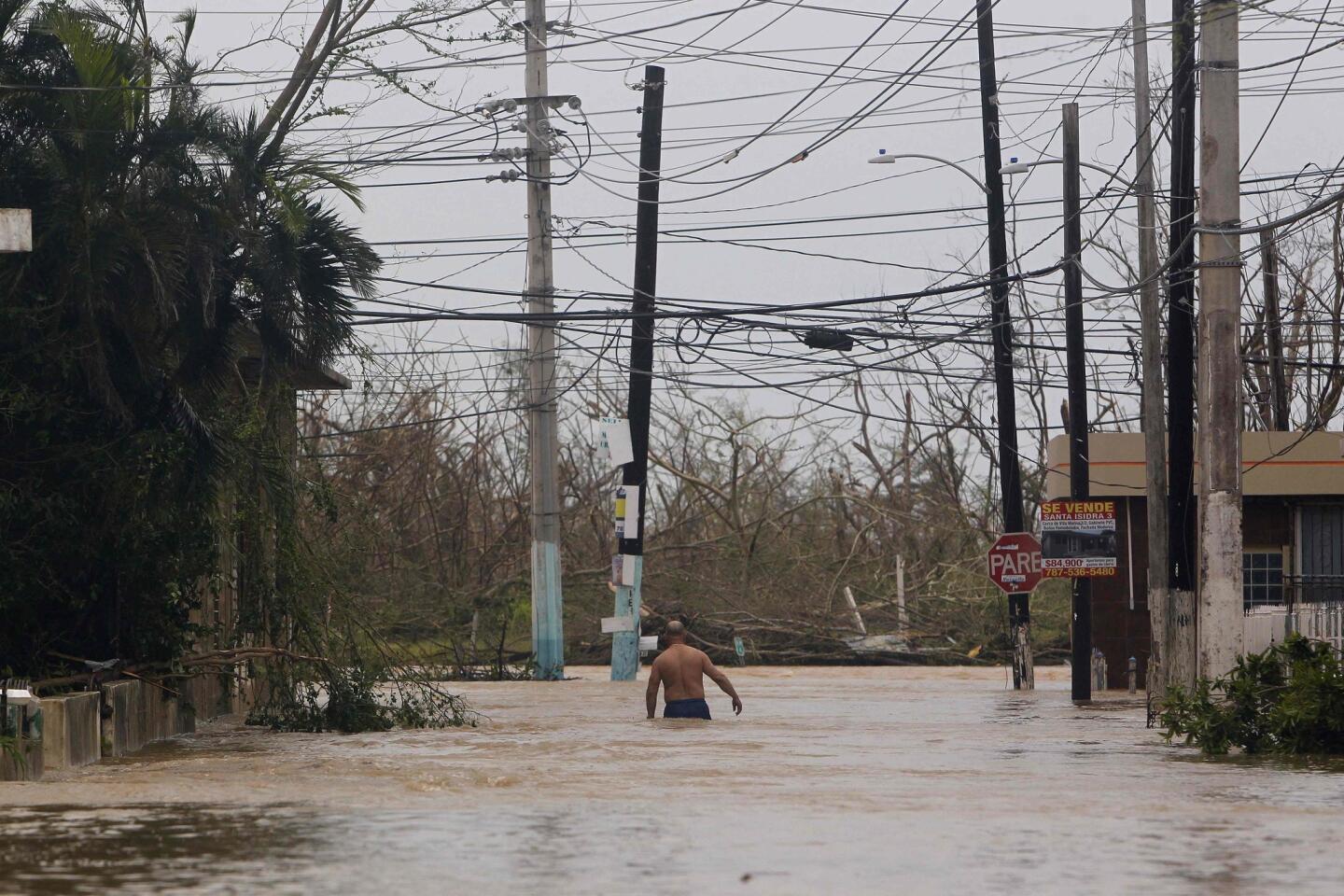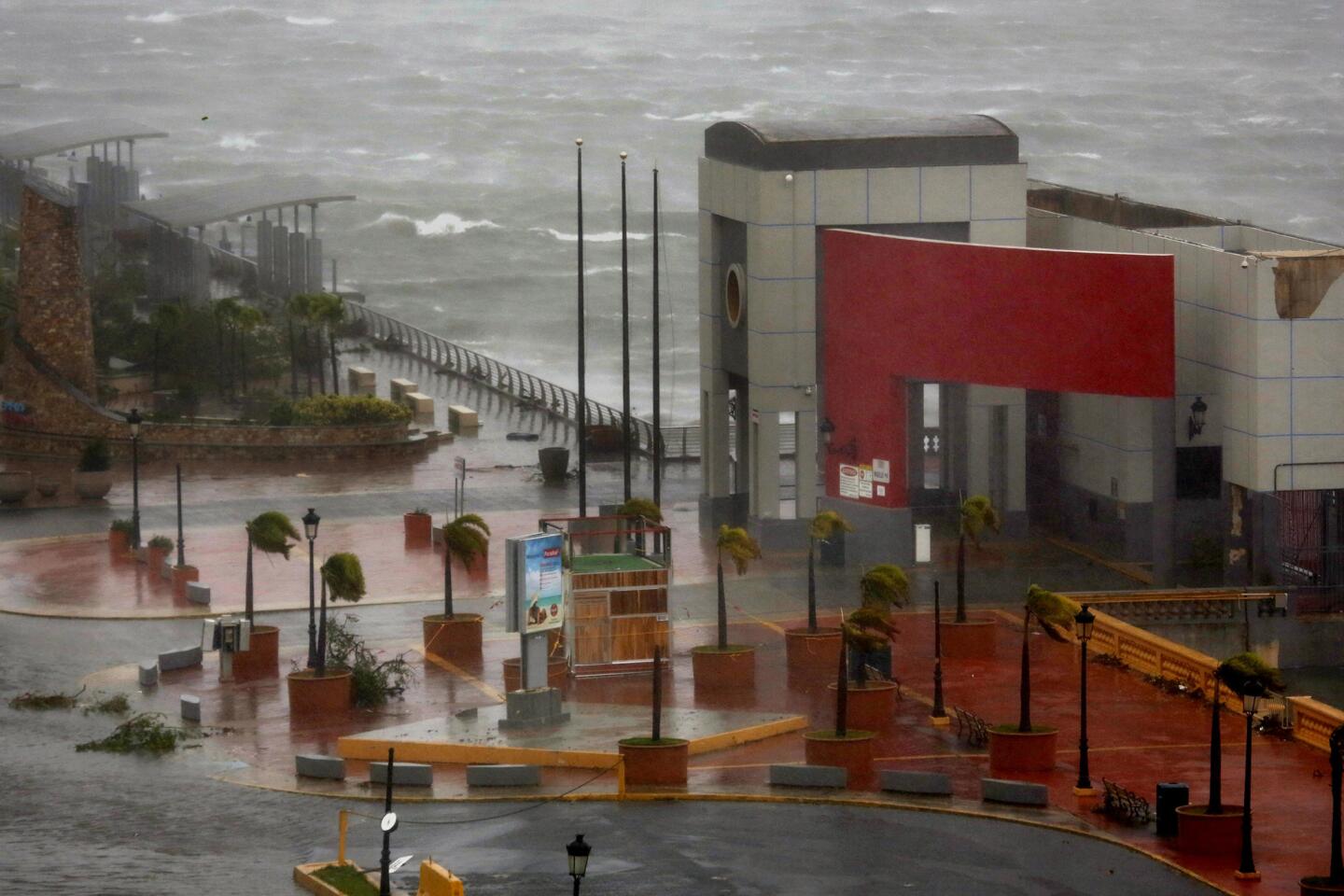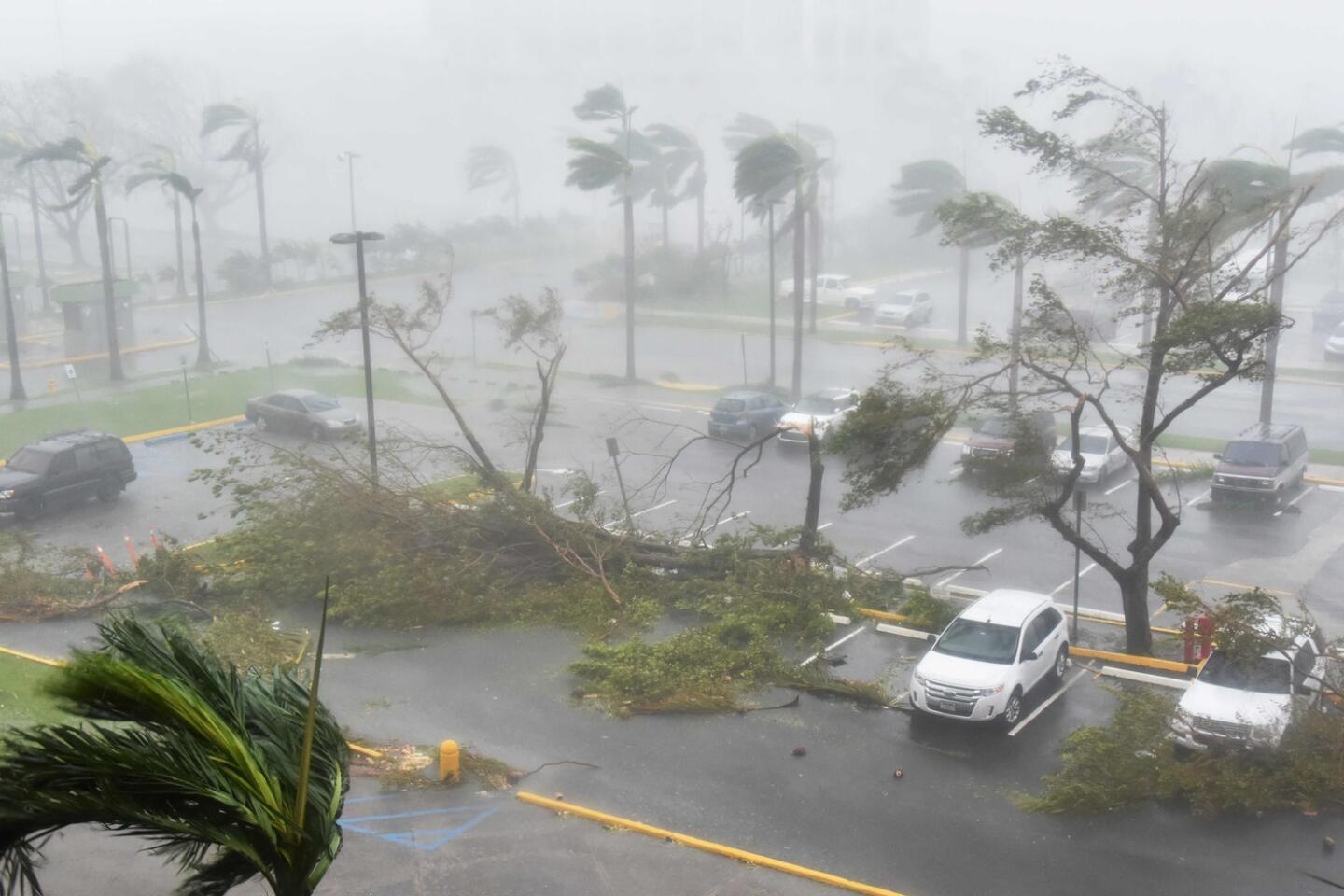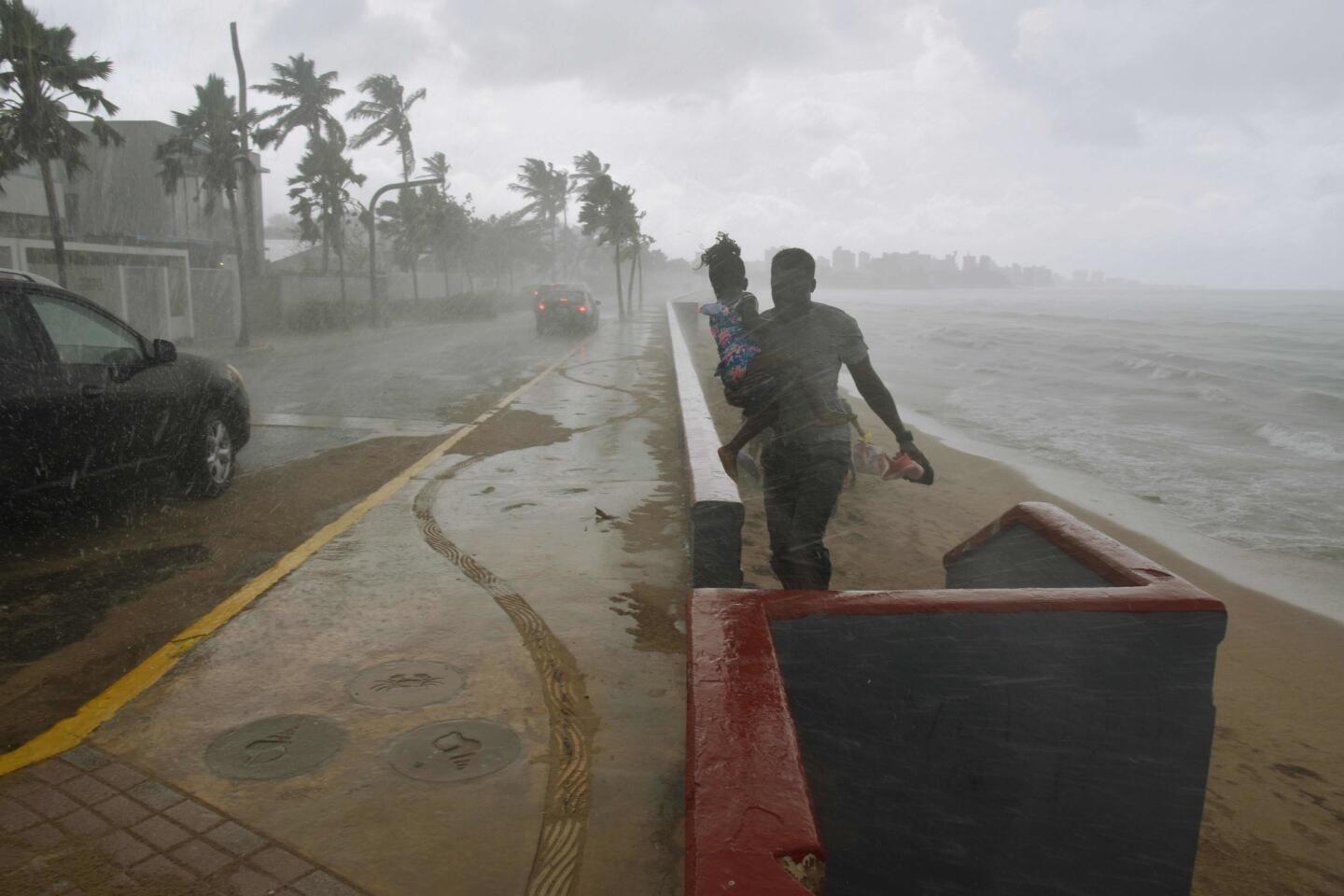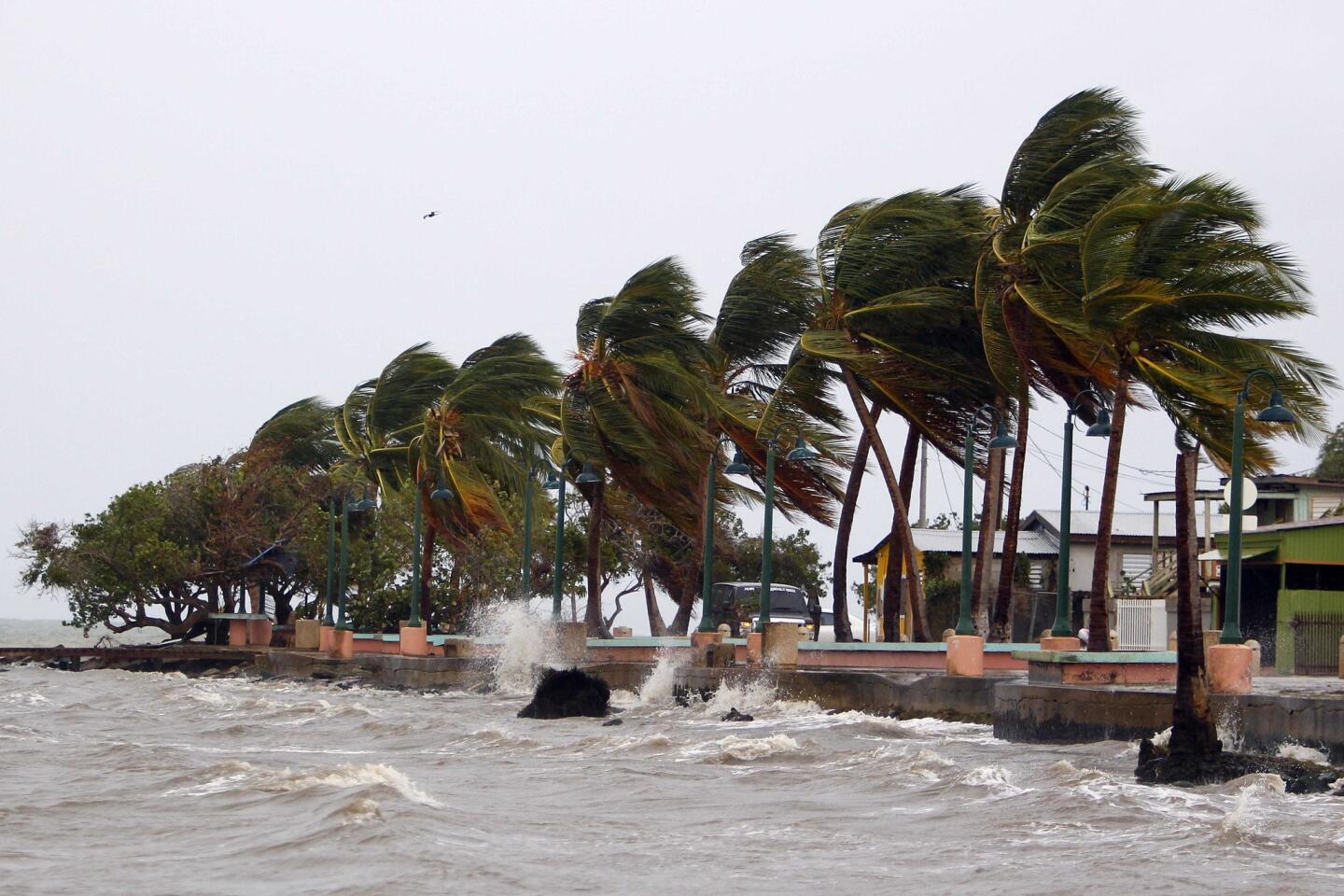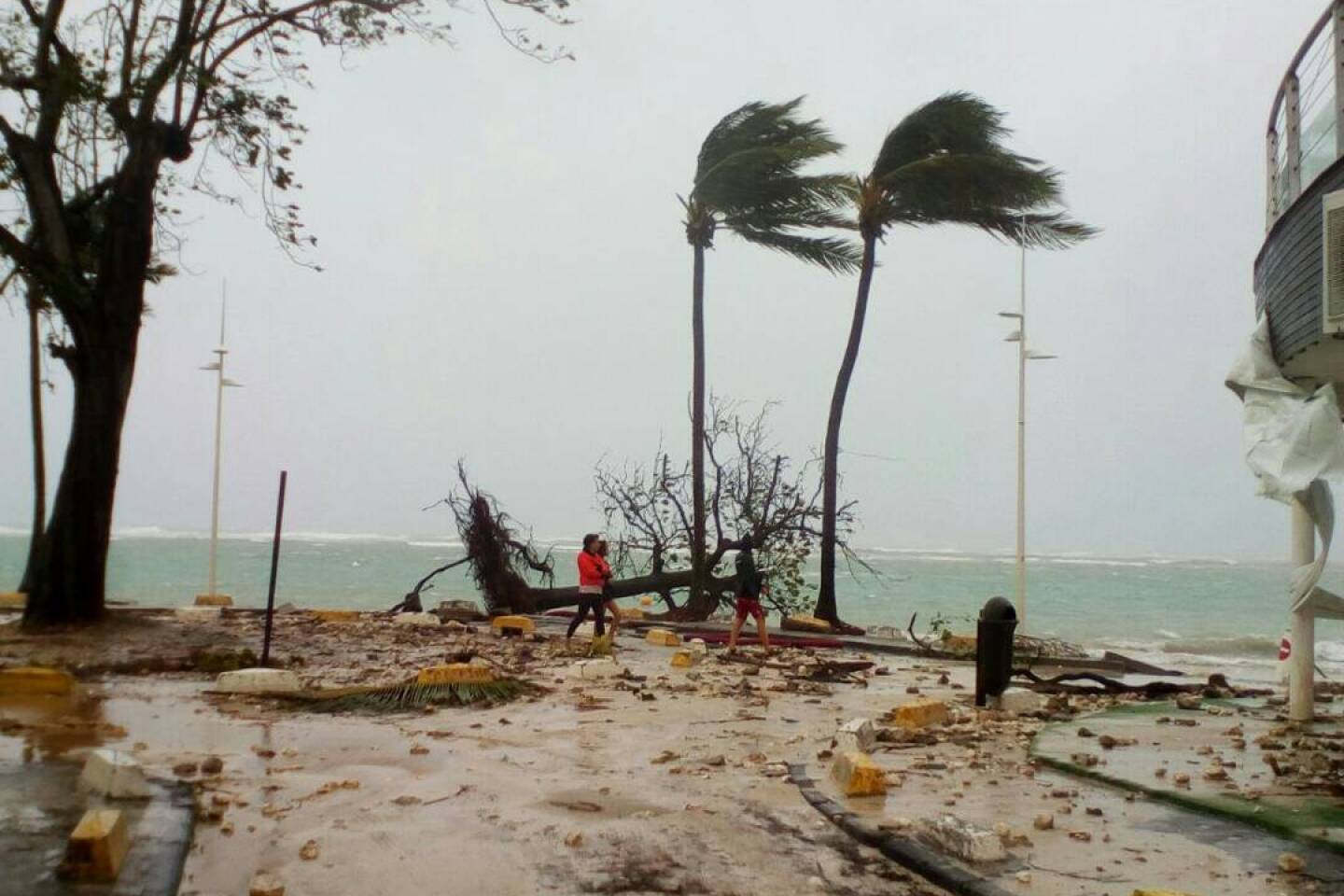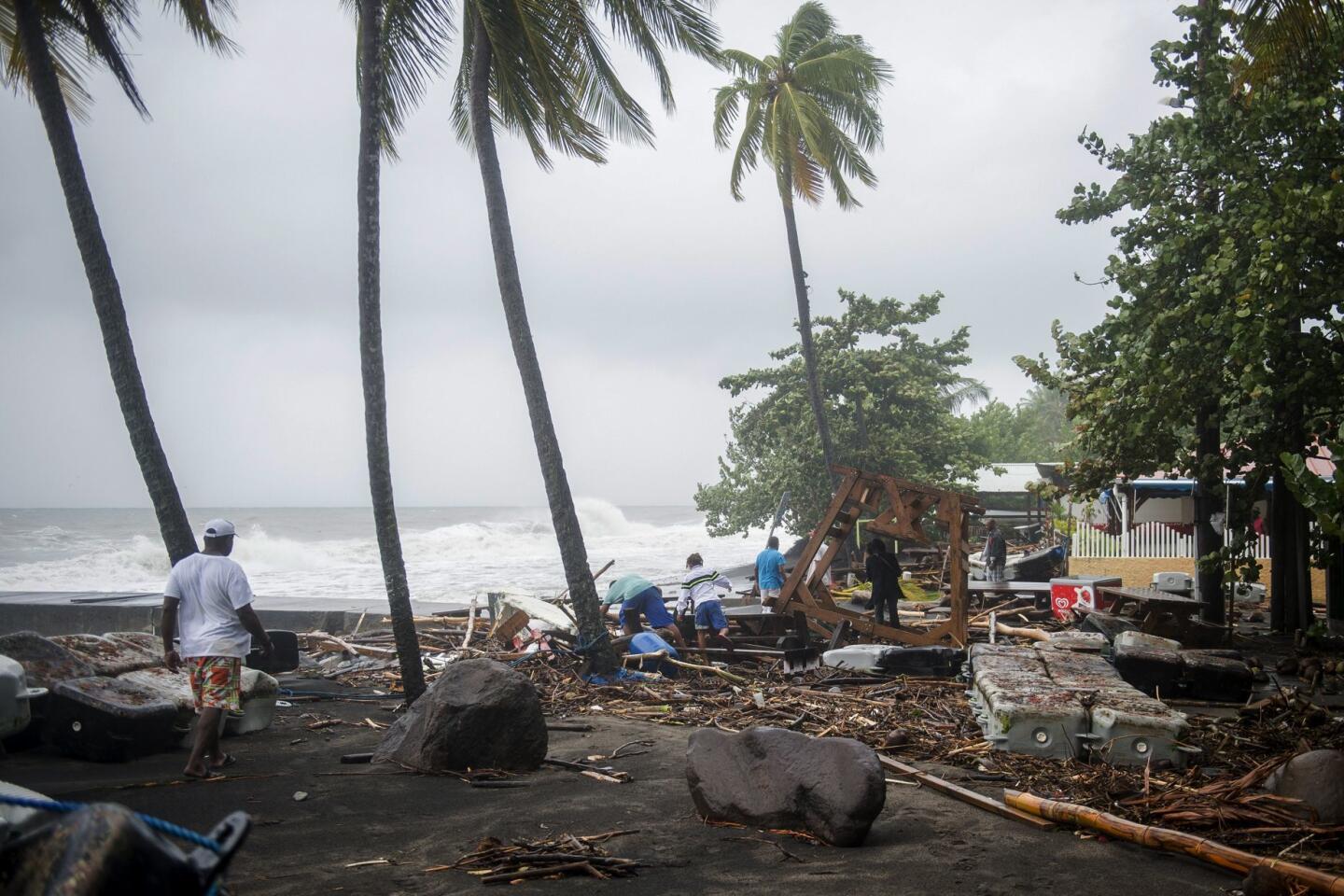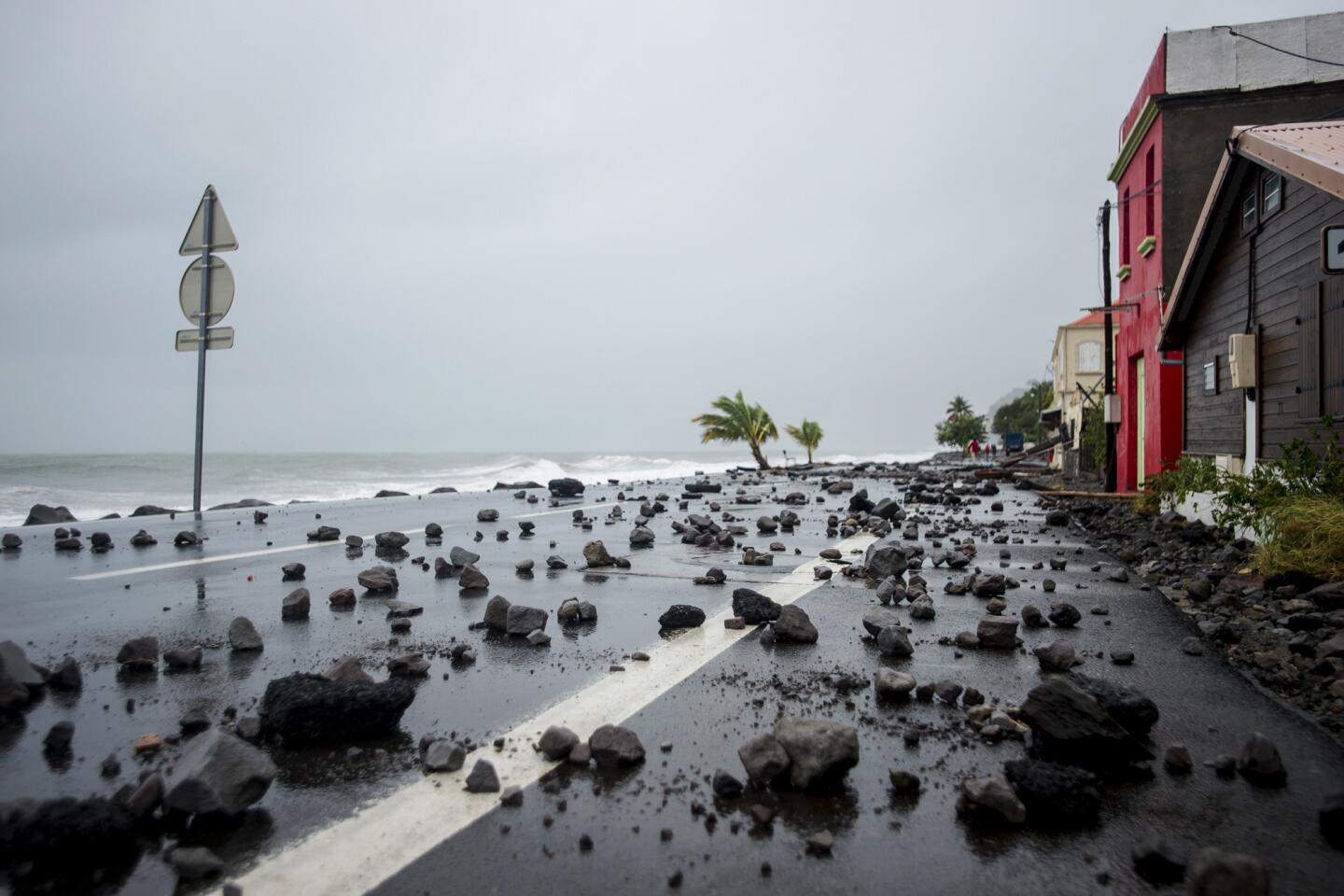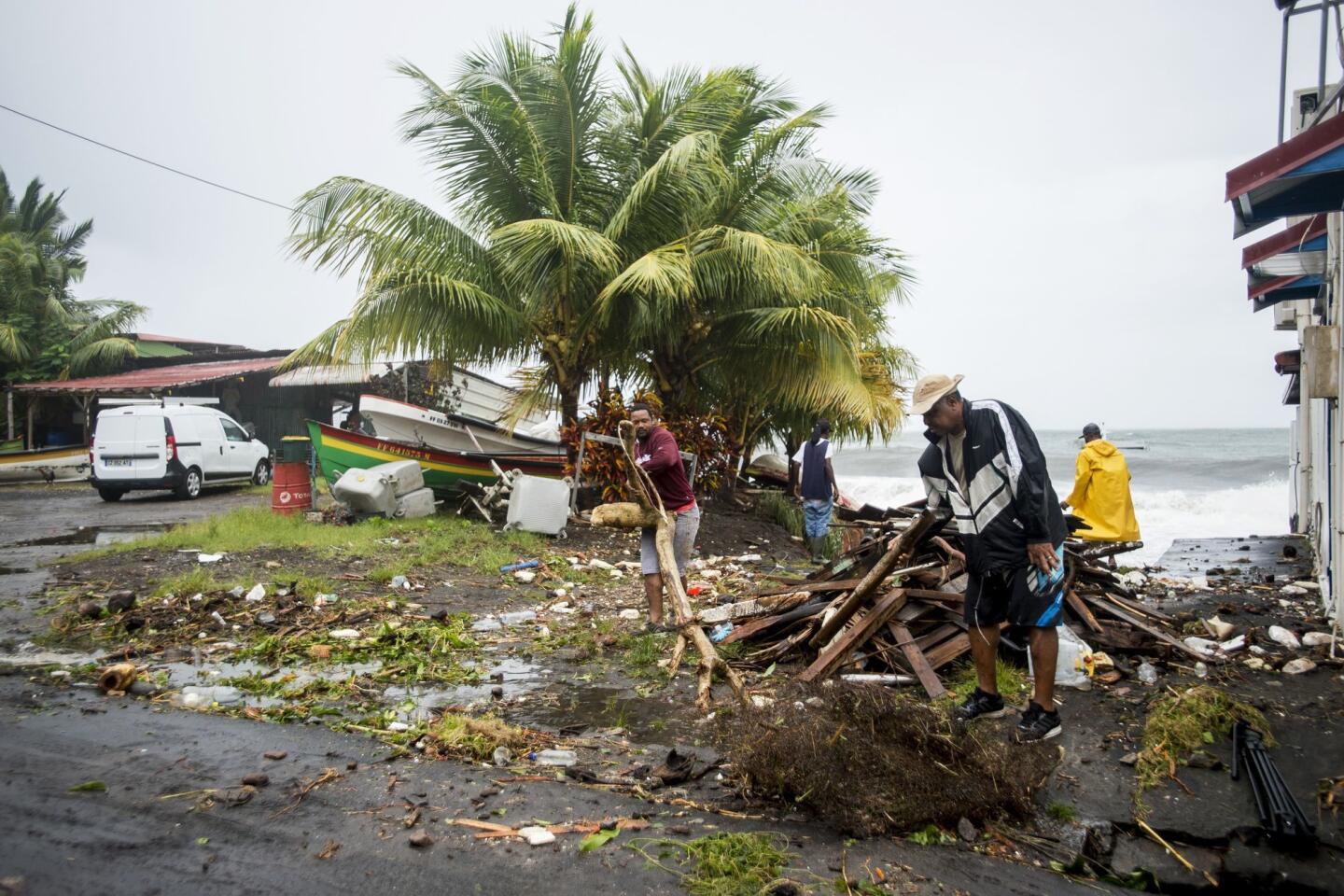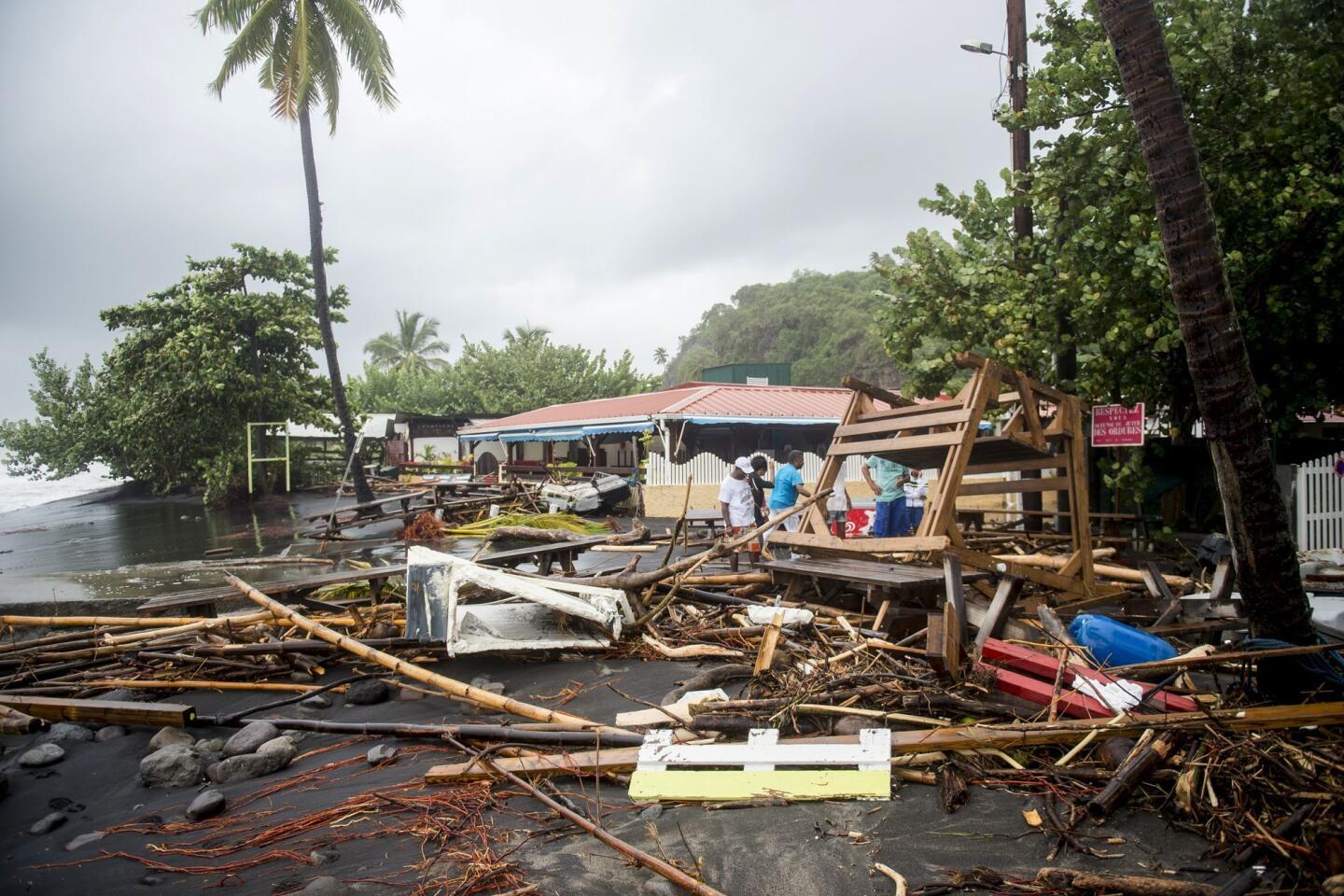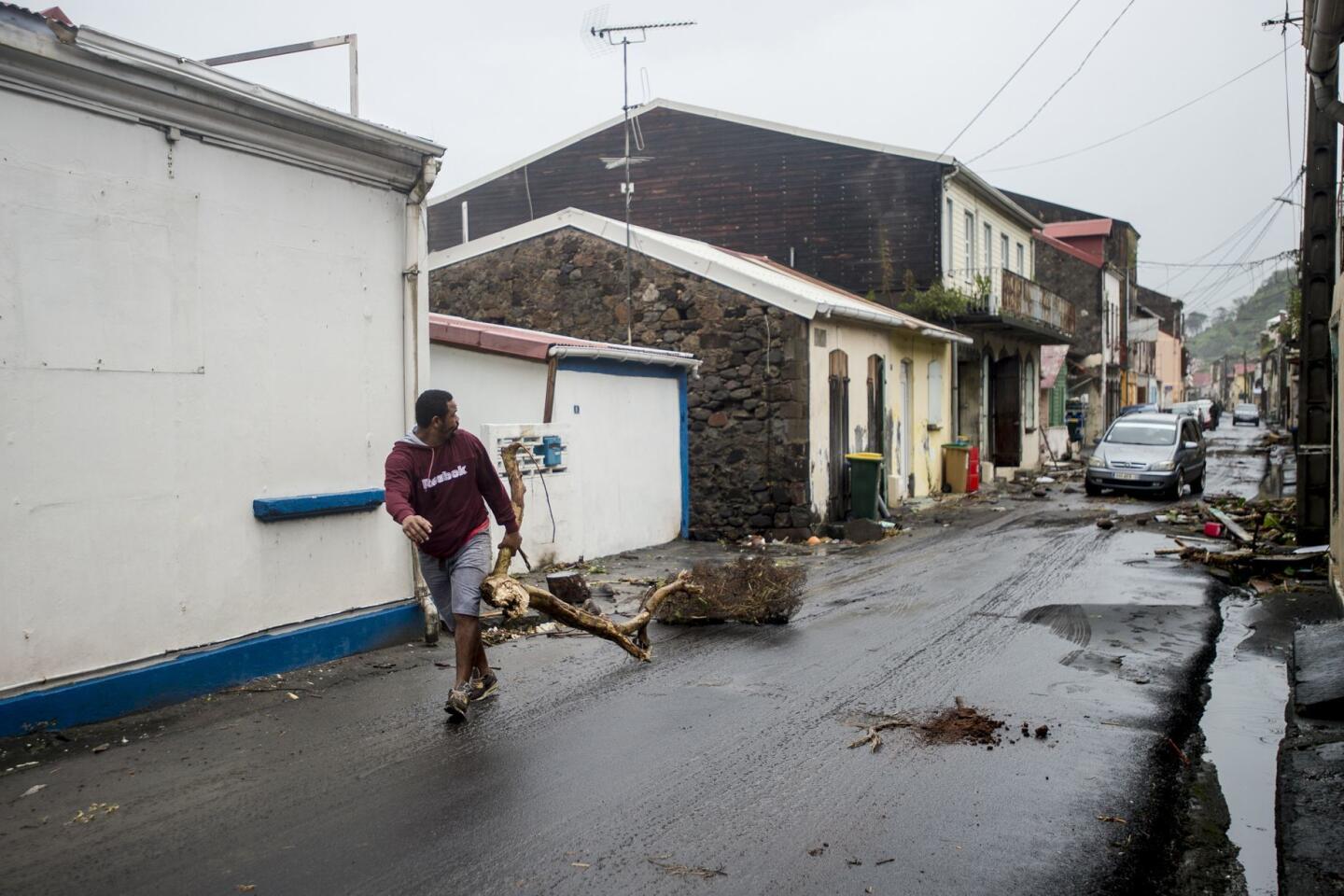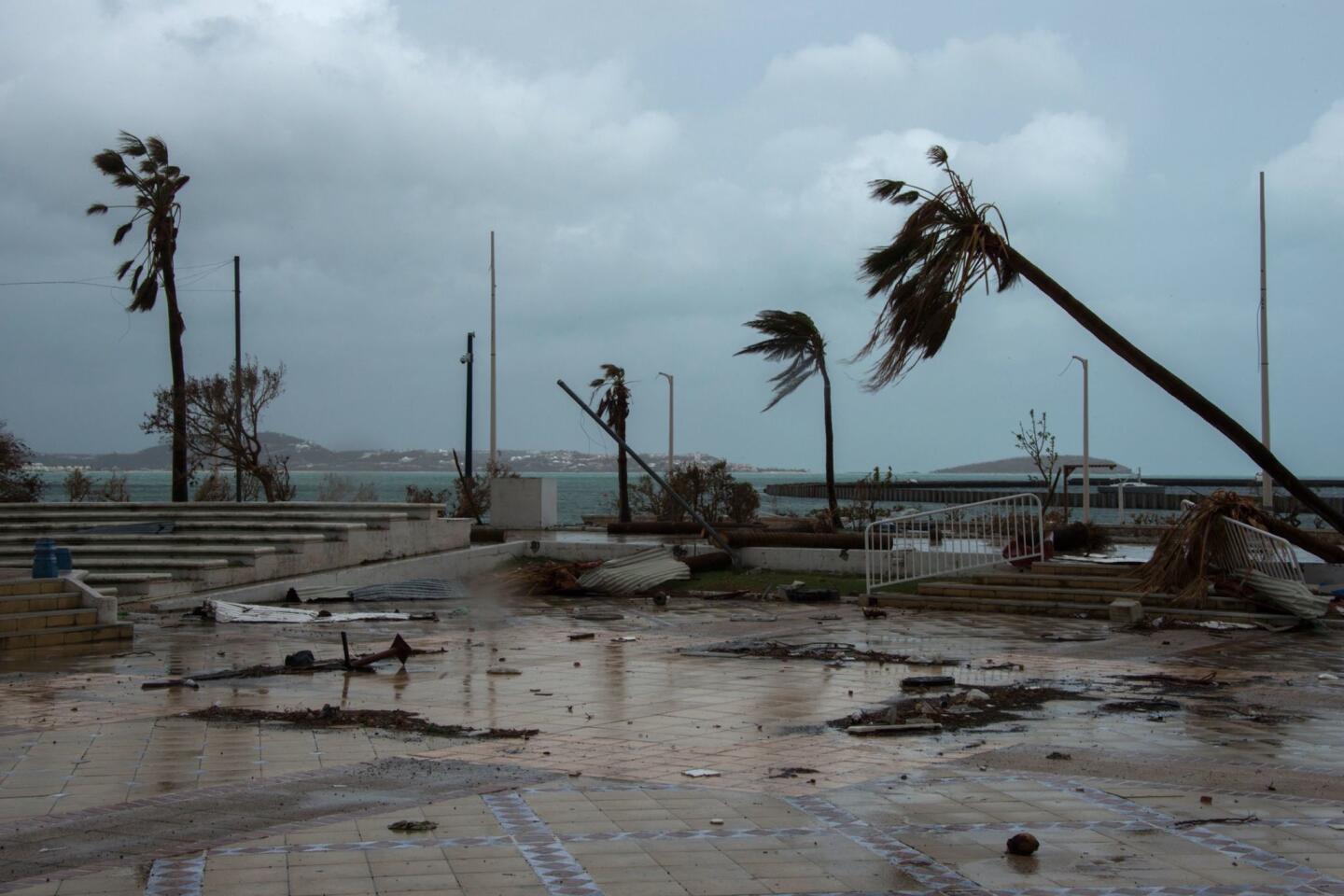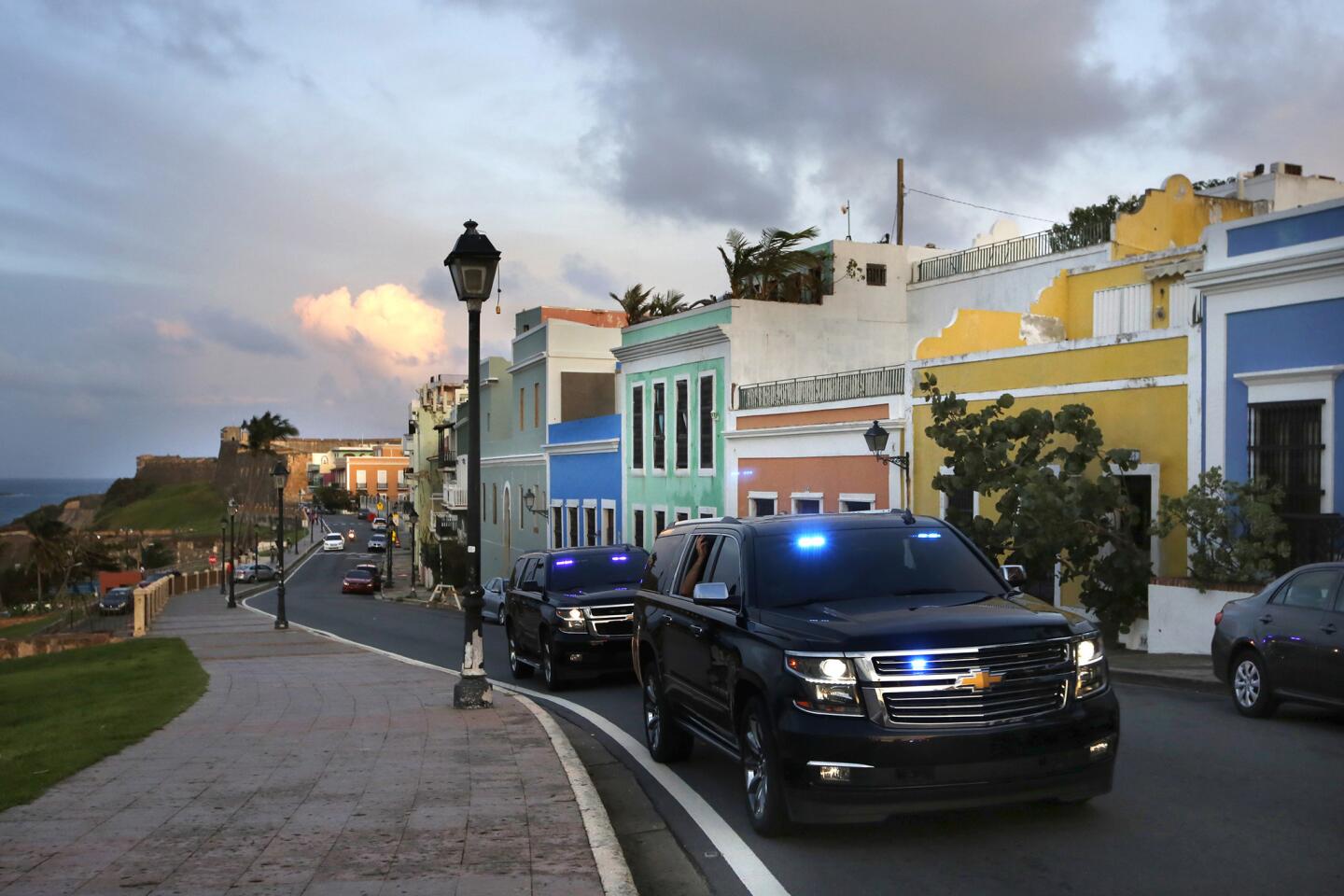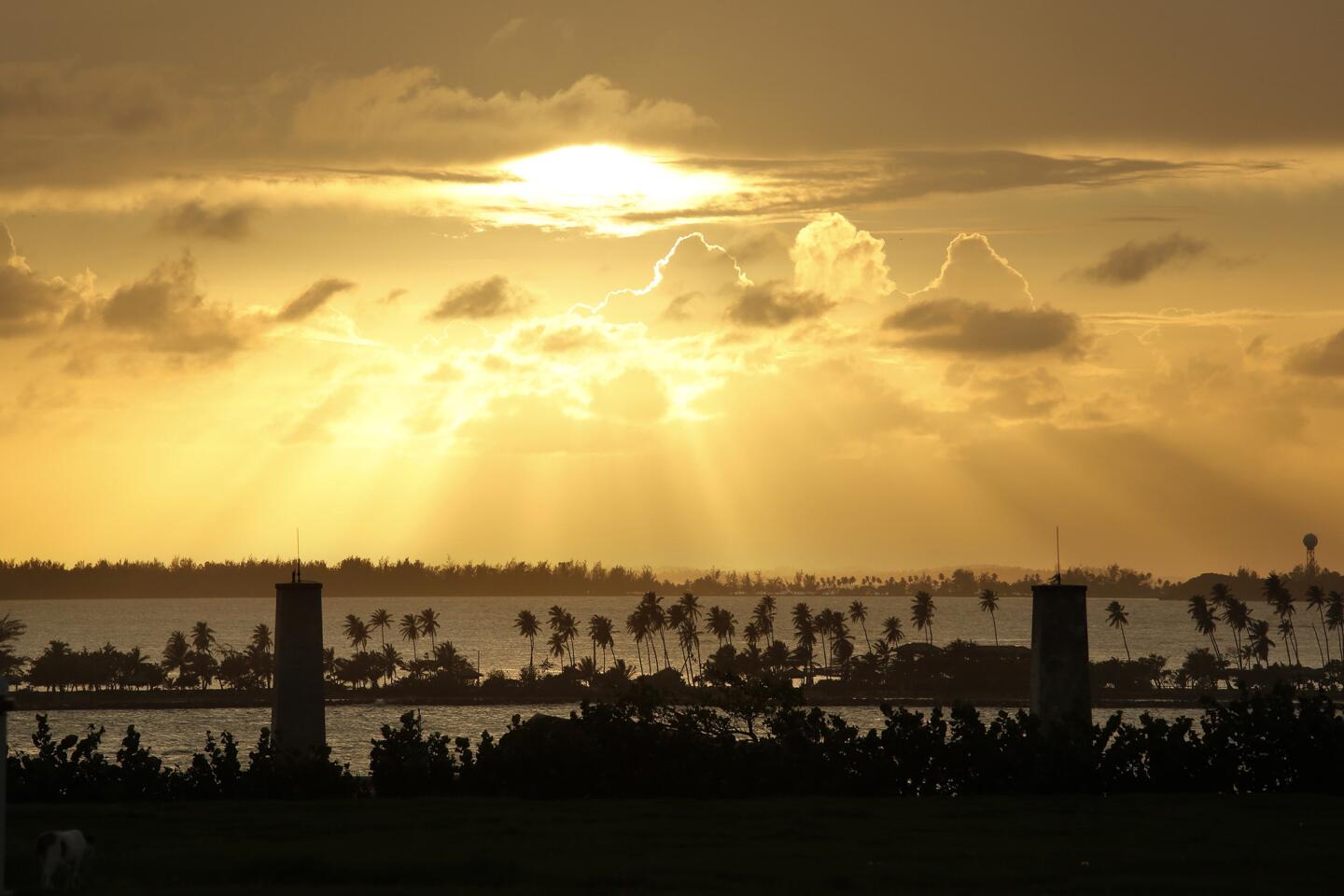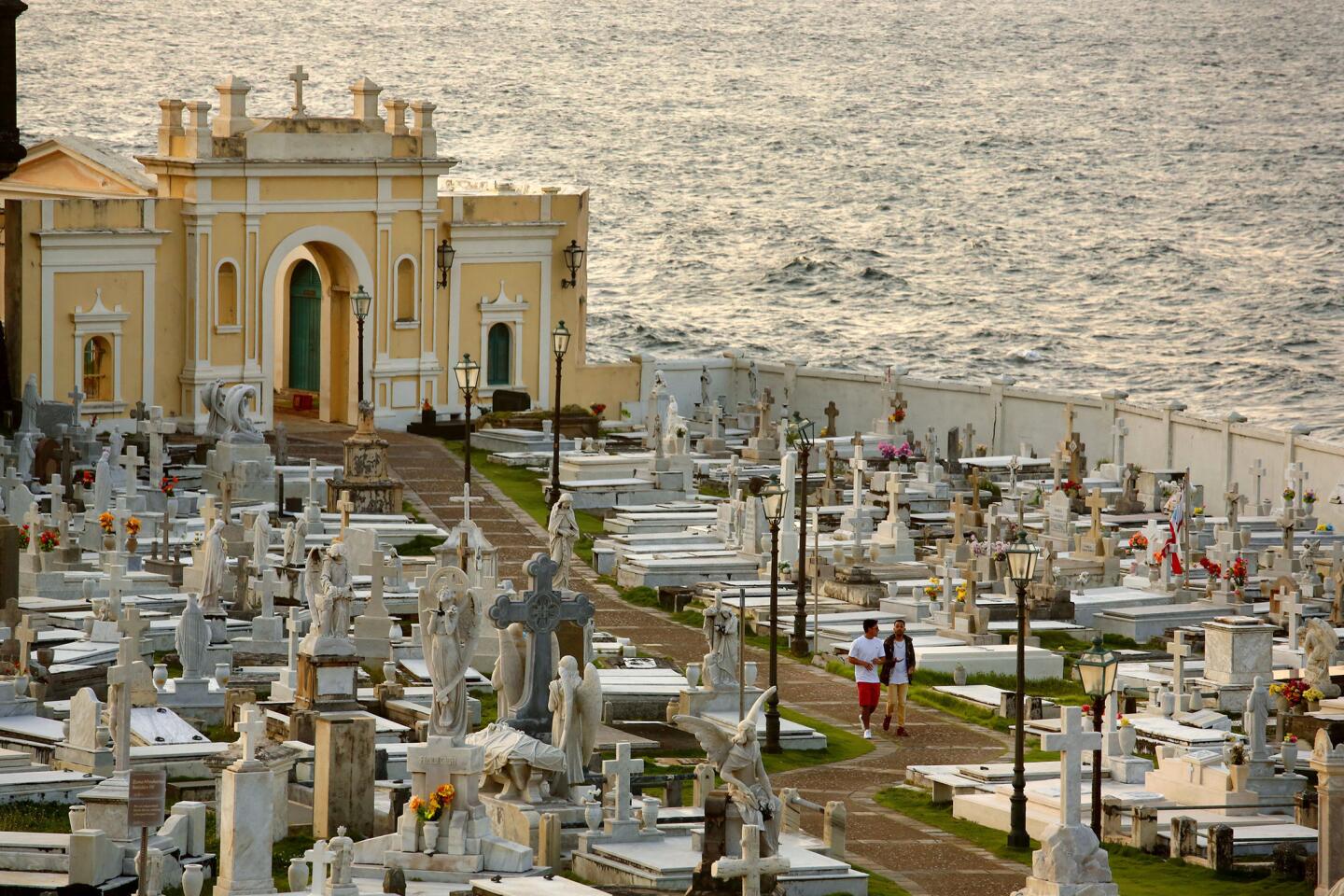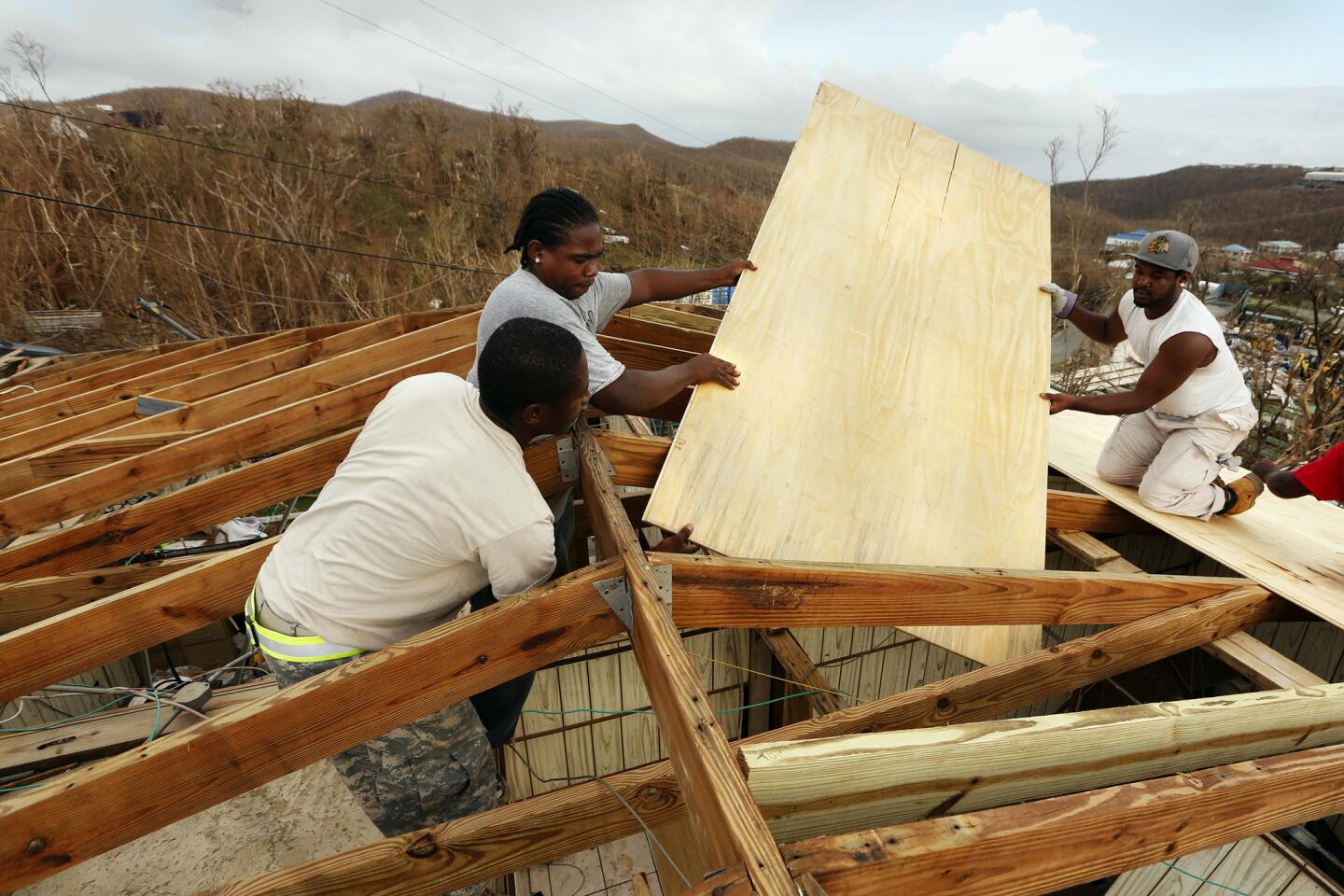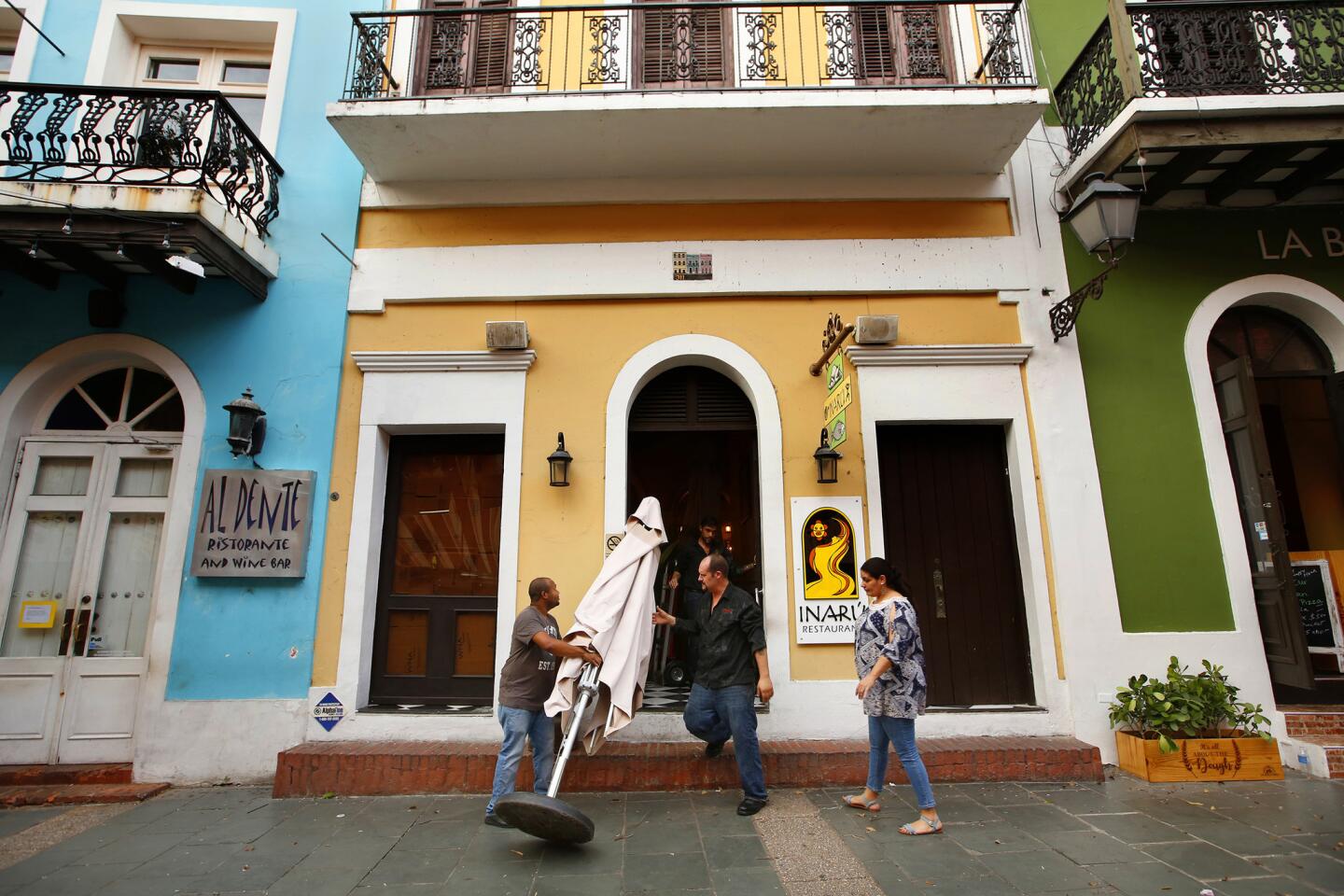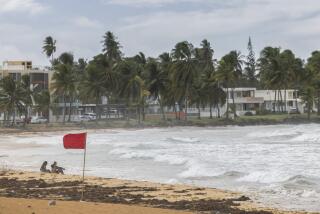Reporting from SAN JUAN, PUERTO RICO â The evacuation of tens of thousands of residents who live near a failing dam in northwest Puerto Rico continued Saturday, as fears of more deaths gripped the U.S. territory, days after Hurricane Maria tore across the island.
Officials warned that the Guajataca Dam, about 70 miles west of San Juan, was in âimminentâ danger of failure. The dam, built around 1928, supplies drinking and irrigation water to residents of towns in the municipalities of Isabela and Quebradillas. The National Weather Service issued a flash-flood warning for towns downstream from the dam because of its possible failure.
Nowhere was safe. In the capital of San Juan, flash-flooding alerts continued. The Carnival Cruise ship Fascination docked Saturday in Old San Juan with 2,000 passengers, but only those from Puerto Rico â about 800 â were allowed to disembark; the rest continued on to Miami. Those who left the ship had to figure out how to get home, having departed last Sunday for a weeklong cruise cut short by the storm.
Marjorie Rivera, a disabled U.S. Army veteran and mother of five, left the ship with her husband and three daughters using a walker. They had parked nearby and hoped to make it back to their home in southern Puerto Rico to check on her other two girls before dark.
The storm didnât impact the ship, she said, but they received reports about damage in Puerto Rico and stopped near Antigua on the way back, where they saw widespread devastation that only heightened their concern.
Puerto Rico Gov. Ricardo Rossello participated in an aerial tour of the Guajataca Dam on Saturday to assess its stability.
âWe could directly see damageâ to the dam, he said on Twitter, urging residents to âvacate the area as soon as possible.â
So far, the Puerto Rico government has confirmed six deaths â three from mudslides, three from flooding and falling debris â as a result of Maria. Officials, however, have warned that the death toll is likely to increase. At least 27 people around the Caribbean were killed, including at least 15 on hard-hit Dominica.
Several days after Maria made landfall here as a Category 4 storm, much of Puerto Rico remained without power and was unable to communicate with those beyond the island.
1/66
Darkness falls on downtown San Juan which remains without power. Puerto Rico officials say it will likely be four to six months before power is fully restored across the U.S. territory of 3.5 million people. (Carolyn Cole / Los Angeles Times)
2/66
A Royal Caribbean cruise ship is evacuating over 2,000 people from Puerto Rico, St. John, and St. Thomas. (Carolyn Cole / Los Angeles Times)
3/66
Luis Frankie, age 66, waits to board an evacuation cruise ship in San Juan. (Carolyn Cole / Los Angeles Times)
4/66
Cesar Ayala, second from left, and his family wait to board an evacuation cruise ship in San Juan. (Carolyn Cole / Los Angeles Times)
5/66
In downtown San Juan, electric lines lie in the road and poles block apartment complexes. (Carolyn Cole / Los Angeles Times)
6/66
Police control the lines at every gas station in the San Juan metro area. (Carolyn Cole / Los Angeles Times)
7/66
Blance Dias, age 77, opens a container of cold ravioli that she received at a FEMA food distribution. âIâm hungry. I havenât eaten in two days,â she said. (Carolyn Cole / Los Angeles Times)
8/66
Heydee Perez, age 29, and her son, Yeriel Calera, age 4, have not received any aid one week after Hurricane Maria hit Puerto Ricl. The roof of their home is gone and they have very little to eat. (Carolyn Cole / Los Angeles Times)
9/66
Hospital employees and nurses gather to pray for a co-worker who was critically injured in a violent attack during the chaos after Hurricane Maria hit Puerto Rico. (Carolyn Cole / Los Angeles Times)
10/66
Children bath with the water from a fire hydrant in a public housing project in San Juan. Residents are still trying to get the basics of food, water, gas, and money from banks. (Carolyn Cole / Los Angeles Times)
11/66
Two people sit in an apartment with a wall missing along the waterfront in San Juan. Nearly one week after hurricane Maria devastated the island of Puerto Rico, residents are still trying to get the basics of food, water, gas, and money from banks. (Carolyn Cole / Los Angeles Times)
12/66
Hurricane Maria devastated the island of Puerto Rico causing heavy damage to many homes. (Carolyn Cole / Los Angeles Times)
13/66
A line of people hoping to withdraw money wraps around the Banco Popular in San Juan on Monday. (Carolyn Cole / Los Angeles Times)
14/66
Hurricane Maria flattened vegetation across the island of Puerto Rico. (Carolyn Cole / Los Angeles Times)
15/66
U.S. Coast Guard personnel survey the damage to an oil dock after Hurricane Maria passed through the area in San Juan, Puerto Rico. (Joe Raedle / Getty Images)
16/66
Vehicles drive along a flooded road after Hurricane Maria passed through the area in San Juan, Puerto Rico. (Joe Raedle / Getty Images)
17/66
In the mountain town of Utuado, Puerto Rico, residents are struggling to recover after Hurricane Maria. There is no running water, so people are collecting water from mountain springs. (Carolyn Cole / Los Angeles Times)
18/66
Delia Pineda, 89, is evacuated from Salto Arriba, an area cut off from Utuado following Hurricane Maria. (Carolyn Cole / Los Angeles Times)
19/66
In Utuado, Puerto Rico, rushing water from Hurricane Maria tore down trees and stripped them of their branches. The main north-south road is washed out, leaving people cut off. (Carolyn Cole / Los Angeles Times)
20/66
Highway 10, a major north-south connection through Puerto Rico, was washed out by Hurricane Maria. (Carolyn Cole / Los Angeles Times)
21/66
A man walks on a highway divider while carrying his bicycle in the aftermath of Hurricane Maria in San Juan, Puerto Rico. (Ricardo Arduengo / AFP/Getty Images)
22/66
Residents clear the streets after Hurricane Maria made landfall in the Guaynabo suburb of San Juan, Puerto Rico. (Alex Wroblewski / Getty Images)
23/66
People walk across a flooded street in Juana Matos, Puerto Rico. (Hector Retamal / AFP/Getty Images)
24/66
Damaged sailboats washed ashore are seen in the aftermath of Hurricane Maria in Fajardo, Puerto Rico. (Ricardo Arduengo / AFP/Getty Images)
25/66
Downed traffic lights and power lines are seen in the aftermath of Hurricane Maria in Luquillo, Puerto Rico. (Douglas Curran / AFP/Getty Images)
26/66
People are transported along a road flooded by Hurricane Maria in Juana Matos, Puerto Rico. (Hector Retamal / AFP/Getty Images)
27/66
Old San Juan is without electricity after Maria. (Carolyn Cole / Los Angeles Times)
28/66
Old San Juan has no electricity, including the area of La Perla. Restoring power to the island may take months. (Carolyn Cole / Los Angeles Times)
29/66
Wide swaths of Puerto Rico remained without power. (Carolyn Cole / Los Angeles Times)
30/66
The day after Hurricane Mariaâs direct hit, residents of La Perla, part of Old San Juan, begin cleaning up. (Carolyn Cole / Los Angeles Times)
31/66
A damaged residence in Old San Juanâs La Perla community. Like the rest of Puerto Rico, the residents are without power or running water. (Carolyn Cole / Los Angeles Times)
32/66
Residents of Isla Palmeras, a San Juan neighborhood, are surrounded by floodwater. (Carolyn Cole / Los Angeles Times)
33/66
Ivan Lopez, 51, helps a neighbor with his badly damaged home. âI was born here, Iâll die here,â Lopez said. (Carolyn Cole / Los Angeles Times)
34/66
The long cleanup process has begun in La Perla, part of Old San Juan. (Carolyn Cole / Los Angeles Times)
35/66
Branches are strewn about Santurce, part of San Juan. (Carolyn Cole / Los Angeles Times)
36/66
Lyan Carrillo, 12, foreground, and her family, including Nilda Ramirez, center, and Ramirezâs 1-year-old son, Crisxander Cotto, returned to their home in La Perla. They plan to stay despite the lack of electricity and water. (Carolyn Cole / Los Angeles Times)
37/66
Residents of the San Juan district of Santurce wade through floodwater toward their home. (Carolyn Cole / Los Angeles Times)
38/66
Ivan Lopez looks at the damage to his neighborsâ homes. His home was not as badly damaged, so he plans to stay despite a lack of water and electricity. (Carolyn Cole / Los Angeles Times)
39/66
Residents of La Perla begin to clean up. (Carolyn Cole / Los Angeles Times)
40/66
Sonia Viruet, who lives in La Perla, takes stock after Hurricane Maria caused widespread damage. (Carolyn Cole / Los Angeles Times)
41/66
Neighbors come together to move a car in San Juanâs La Perla area. (Carolyn Cole / Los Angeles Times)
42/66
Chickens run loose in the area of La Perla, where many homes were destroyed. (Carolyn Cole / Los Angeles Times)
43/66
People loot a furniture store in a section of Old San Juan after Maria damaged buildings. (Carolyn Cole / Los Angeles Times)
44/66
Maria downed trees and damaged structures in Old San Juan. (Carolyn Cole / Los Angeles Times)
45/66
Old San Juan resident Rosa Avalo, 48, saw her home, purple building, damaged by debris from her neighborâs property. (Carolyn Cole / Los Angeles Times)
46/66
Evacuees rest in almost complete darkness on the ground floor of the Roberto Clemente Coliseum, a major shelter in San Juan. (Carolyn Cole / Los Angeles Times)
47/66
David Leininger leaves his flooded car in a San Juan parking lot. (Carolyn Cole / Los Angeles Times)
48/66
Roberto Flores, left, helps move tree limbs from a San Juan road. (Carolyn Cole / Los Angeles Times)
49/66
A man wades through a flooded road in Fajardo on Wednesday. (Ricardo Arduengo / AFP / Getty Images)
50/66
A view from the Sheraton Old San Juan, where people were waiting out Maria. (Carolyn Cole / Los Angeles Times)
51/66
At the Sheraton Old San Juan, people wait out the hurricane. (Carolyn Cole / Los Angeles Times)
52/66
Trees topple in a parking lot at Roberto Clemente Coliseum in San Juan. (Hector Retamal / AFP/Getty Images)
53/66
A man and his daughter flee from the rain on a San Juan beach before Hurricane Mariaâs arrival. (Hector Retamal / AFP/Getty Images)
54/66
Winds lash the coastal city of Fajardo as Hurricane Maria approaches Puerto Rico. (Ricardo Arduengo / AFP / Getty Images)
55/66
People walk by a fallen tree off the shore of Sainte-Anne on the French Caribbean island of Guadeloupe after the passing of Hurricane Maria. (Dominique Chomereau-Lamotte / Associated Press)
56/66
People walk amid debris of a restaurant shattered by Hurricane Maria in Le Carbet on the French Caribbean island of Martinique. (Lionel Chamoiseau / AFP/Getty Images)
57/66
Rocks swept up by hurricane-generated waves cover a road along the oceanfront in Le Carbet, on the French Caribbean island of Martinique. (Lionel Chamoiseau / AFP/Getty Images)
58/66
People clear debris in Saint-Pierre, on the French Caribbean island of Martinique, after it was hit by Hurricane Maria. (Lionel Chamoiseau / AFP/Getty Images)
59/66
A restaurant lies in splinters in Le Carbet, on the French Caribbean island of Martinique, after it was hit by Hurricane Maria. (Lionel Chamoiseau / AFP/Getty Images)
60/66
A man clears debris from a street in Saint-Pierre, on the French Caribbean island of Martinique, after it was hit by Hurricane Maria. (Lionel Chamoiseau / AFP/Getty Images)
61/66
Debris in a street in Marigot, on the French Caribbean island of Saint Martin, after Hurricane Maria hit. (Helene Valenzuela / AFP/Getty Images)
62/66
Official cars with loudspeakers roll slowly down a street in Old San Juan, Puerto Rico, broadcasting a warning to residents to evacuate as Hurricane Maria approaches. (Carolyn Cole / Los Angeles Times)
63/66
As Hurricane Maria approached from the other direction, Old San Juan was graced by a dramatic sunset on Monday. (Carolyn Cole / Los Angeles Times)
64/66
A historic cemetery at the waterâs edge in Old San Juan, Puerto Rico, faces possible flooding as Hurricane Maria passes over the island. (Carolyn Cole / Los Angeles Times)
65/66
In Cruz Bay on St. John in the Virgin Islands, which already took a severe lashing from Hurricane Irma, workers rush to fix a roof in advance of Hurricane Maria. (Carolyn Cole / Los Angeles Times)
66/66
Workers at the Inaru restaurant in Old San Juan take in umbrellas and close early in anticipation of Hurricane Maria. (Carolyn Cole / Los Angeles Times)
In a statement, the Federal Communications Commission said 95% of cell phone sites are out of service.
âIt appears as though there has been little if any improvement to communications networks in Puerto Rico since the hurricane departed,â the agency said.
Nearly 3,700 federal staffers are in Puerto Rico to help with recovery efforts. They already were on the island before the stormâs arrival on Wednesday, helping with recovery efforts after Hurricane Irma hammered the Caribbean days earlier. Additional resources â food, water, cots â were being flown into the San Juan airport, which opened late Friday. Most of the flights arriving and departing were military relief flights, though some commercial service has resumed.
On Saturday, Navy officials said the amphibious assault ship Kearsarge was supporting ongoing relief efforts in Puerto Rico. More than a dozen tilt-rotor aircraft and helicopters are departing from the vessel to conduct search-and-rescue missions and aerial assessments of the damage.
âThe Navy-Marine Corps team is well-suited for humanitarian assistance and disaster relief,â Rear Adm. Jeffrey Hughes said in a statement. âWe have the capabilities to address this problem from the land, the sea and the air.â
In San Juan, some of the few stores that opened imposed special conditions. At the Walgreens in Old San Juan, police posted at the entrance allowed customers to enter one at a time, and employees escorted them through the store, limiting them to two bottles of water each.
Bob Pederson was attempting to mop up outside his Old San Juan sports bar Saturday, which was still boarded up but had a generator humming.
It took Pederson, 42, six hours to find gas earlier in the day, after waiting in line and discovering the station was rationing, allowing only $10 worth per person.
âIâm selling what I can,â he said of his restaurant. âI have the generator running mostly for the freezer, but the people need to eat.â
He drove around the island Friday and described what he saw as âtotal devastation,â with water still chest-high in some neighborhoods. Lines for food and water were already long.
Pedersonâs condominium complex, not far from the sports bar, has a generator, but itâs running out of diesel fuel and elderly residents were unwilling to shut it off, counting on the government to bring them more.
He worried what would happen when they run out. He expects the government will reserve dwindling supplies for hospitals and other emergency services.
âWhen you start regulating, people get desperate. And desperation brings the animal out in people,â he said. âItâs about survival.â
[email protected]
Twitter: @mollyhf
[email protected]
Twitter: @kurtisalee
Hennessy-Fiske reported from San Juan and Lee from Los Angeles.
ALSO
Scientists say latest 6.1 aftershock in Mexico is ânot surprisingâ
The fate of earthquake victim âFrida Sofiaâ captivated Mexico. But it seems she never existed
Mexico earthquake crumbles concrete buildings, sending deadly warning to California
UPDATES:
6:35 p.m.: This article was updated with additional details.
This article was originally published at 10:25 a.m.
